Text
Soundtrack of the Year 2015 Post Archived
Originally posted January 18, 2016 on the old forum.
I don’t have much to say other than ... I’m tired of 2015. Haha. It was a rough year so I didn’t get to listen to everything I’d wanted to! I did get to listen to the Yasunori Mitsuda remix album, and a bunch of albums that Solune and I talked about over the course of a few months. My shortlist was apparently longer than some expected, and I do think 2015 had a lot of great albums. Although the Canadian dollar sank like a tank (and this isn’t going to change heading into 2016), I did try to listen to as many soundtracks as I could. However, I will readily admit that I did not get a chance to listen to everything like I usually do in previous years. Personal life combined with work combined with the crappy dollar combined with falling in love (this is a good thing), kind of made it a little hard try to check out new stuff. I was fairly on top of everything for the first half of the year and then everything kind of fell apart towards the end.
The decision between my number one and number two soundtracks was fairly tough. I went through a lot of mental wrangling in terms of the question “do I vote with my heart, or do I vote with my head?” I don’t usually like going with my heart when I vote for game of the year or soundtrack of the year. It feels completely biased on my part, and I feel like I’m not evaluating something with clarity or based on its own merits. Then I sort of realized, “Well, isn’t that the point?” In my head, Undertale takes the win. In my heart, though, something else does, and it’s entirely based on context. So this year, I decided to go with my heart. Listening to my heart feels weird. I feel very strongly about two soundtracks this year, and therefore, I have decided to go with only two.
This is also the first time that I think I’ve written a list where I’ve played all the games. I could be wrong on that front, but this comes as a genuine surprise. I am disappointed with the lack of Falcom on my list, but I am not entirely comfortable throwing a vote Tokyo Xanadu’s way because I’m almost finished the game. While I do have a lot to say about Tokyo Xanadu’s soundtrack at the moment, I would much rather experience the music further in context before throwing a vote its way (but the soundtrack is really good, and the game itself is quite fun!).
Previous Posts:
2011 Soundtrack of the Year: 1, 2
2012 Soundtrack of the Year: 1, 2, LTTP Post
2013 Soundtrack of the Year: 1, 2, 3, 4
2014 Soundtrack of the Year: 1 / 2 / 3 / 4
Soundtrack of the 6th Generation: 1 / 2 / 3
I decided to forego the awards this year, particularly because I decided to forego my Worst Soundtrack of the Year award. My pick for that would be more than a bit controversial, and I think a few folks know what that one is so I’ll let it slide under the rug.
Honourable Mentions
x. Ori and the Blind Forest : I’d been waiting for this soundtrack for months before the game came out, and it did not disappoint. I was going to make it #3 on my soundtrack list, but halfway through my writeup for it, I felt as though I lost my motivation to write about it. Therefore, I am only including a top 2 this year. A lot of the tracks are incredibly emotional (Light of Nibel, and whenever there’s a rush to quickly platform (Restoring the Light, Facing the Dark), the pacing of the tracks do the level design justice.
x. Tokyo Xanadu : Mixing electronica and violins makes this soundtrack fairly classy, from the upbeat yet elegant Strayed into Passage to the characteristic Believe It!!. Falcom hasn’t lost it; the sound is just evolved to fit Tokyo Xanadu’s tone.
x. Nights of Azure : Holy shit, Nights of Azure is some hot shit, and I wish more people listened to this soundtrack cuz Solune and I love it so much. Moving from some hard rock (Malicious Roses and Edge of Apocalypse to the jazzy Hotel Ende. I wish I had way more time to spend with this soundtrack and imported the game because the soundtrack is definitely Top 5 material.
x. Splatoon : Shooters aren’t my thing. If everyone I tweet didn’t bring this soundtrack up when I was asking for help with the archive, then I probably wouldn’t have known about the soundtrack’s variations. Sucker Punch, Ink Me Up
x. Legend of Legacy : I like Legend of Legacy. Or, at least, when I played the Japanese version of it. It had stuff I liked to nitpick and the game is certainly not for everyone. The music itself feels like an extension of Hamauzu’s recent work. Ex: Twin Dimensional Battle, Initium (one of the better town themes he’s composed, imo)
x. Kirby and the Rainbow Curse : I didn’t finish this game. I, uh, didn’t feel like it jived well with me, and anyone who knows me knows that I absolutely adore Kirby. But this game has some fantastic tuneage, from Great Cave Escape to Dethskullk Jam to The Final Battle. A lot of the soundtrack drives back to previous Kirby games, which is to be expected. However, the tone of the music moving directly back to Kirby Super Star sounds felt right.
x. Transformers Devastation : I had to laugh when NTom64 brought this one up to me, just because I... wasn’t expecting it? I didn’t play the game, so I don’t know if any of the music fits the context at all (never mind that I saw the Transformers movie and I know The Touch fits super-well), but holy crap, the music is incredible and I think it deserves the Badassery Award. Sample: Face the Devastation
2. Undertale
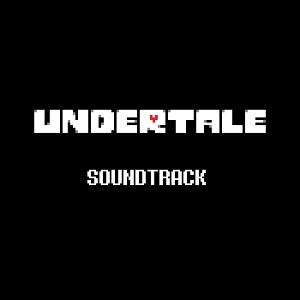
Toby Fox
It’s not even a damn contest. I can reiterate what everyone has said in this thread up to this point about Undertale, but it’s undeniable that this is one of the best soundtracks of 2015. Heck, it might be the best soundtrack of 2015 if the whole “voting with your heart” thing didn’t get in the way for me.
Basically, it took a lot of convincing to get me through this game. For one, another GAF member (Shadow Hog) gifted me the game on Steam because I essentially refused to play it at the time. And I’m still thankful that he did. I played through the whole game with Noi doing his own playthrough and we pushed each other through the game. It took some prodding from EmCee to finish off the game and get the True Pacifist Ending to add more meaning to the soundtrack overall (and I took Noi with me in tow for that, too). Now that doesn’t mean I don’t like the game. I just got spoiled on the endings and a lot of things before playing the game because, well, a lot of people wouldn’t shush about it. When I played the game, I felt like it was about the journey not the end.
The game’s musical journey is fulfilling. Writing about Undertale’s soundtrack feels like a daunting task simply because there is just so much to say. From references to other games, to leitmotifs being used in single areas, to different types of instrumentation, to different soundfonts being used... there’s a lot of things to say about the soundtrack, and even just glancing through this entire thread, there are a lot of different things that people are saying about it. Undertale’s soundtrack is fairly difficult to review. There are a lot of tracks (well, actually, that part isn’t too difficult; I’ve reviewed 100+ track albums before), they all have extremely varying track lengths, and they all use different soundfonts that somehow create a cohesively-sounding album in the end. Overall, the album encourages the listener to be attentive: to soundfonts, to leitmotifs, to different references to other games, and more.
There are twenty-three leitmotifs in the entire soundtrack. Undertale’s soundtrack release also composes of music that hasn’t been used in the game. I think the best way for me to approach the soundtrack, and Noi and I were talking about this last night when he was trying to get me to stop panicking about writing this post in general, is through discussing the leitmotifs. It’s like he said to me, “When you listen to <track>, what do you think of?” Well, there are a lot of things to think of. Nearly every single theme in Undertale references something else internally and externally. There are so many albums and soundtracks that use underlying motifs for everything, but Undertale kind of goes for the nth degree with respect to subtext and motif usage.
The soundtrack opens up with Once Upon a Time, serving as the Undertale theme and the primary leitmotif in the game. The thing about the Undertale theme is that I guess it’s supposed to evoke a comparison between either Pollyanna or Eight Melodies. Going into the Start Menu continues a Mother comparison in terms of the Fun Naming themes without the “OK desu” part. More of the Undertale motif picks up in the comforting midi string theme Home, and it’s here that you start piecing together that all of the thematic similarities between each theme and their usage essentially crafts a story. Or at least, it lets the player have expectations of characters or areas. I particularly like the B-portion, where it sounds like it’s channeling some of the acoustic-driven themes Chrono Cross. It is also here that the player recognizes that Undertale’s soundtrack isn’t just a mesh of soundwaves; it uses midi to its advantage and thus steps up soundfont usage even further. The Undertale motif doesn’t surface until much further into the album under the Hotel and Can You Really Call This a Hotel, I Didn’t Receive a Mint On My Pillow themes, which are more flamenco-based, upbeat and resort-like. I particularly like the latter theme simply because it merges the Undertale theme with the uptempo nature of another character’s leitmotif (rather, the leitmotif isn’t used, but the tempo is). The live acoustic with the final Undertale theme in the neutral ending is so, so good. It mixes another leitmotif from His Theme and the Undertale theme to create a piece that’s used in a particular area that weaves in and out of battle and serves as an excellent conclusion for the six-hour journey. The Undertale motif is used in further pieces on the soundtrack, but I will elaborate on those further down the line.
Your Best Friend is the next motif and it’s kind of one of my favourites simply because it comes from this stupid two-channel harmony but extends into something else entirely as the motif is used beyond this track. The next track is a major spoiler, but This theme is hilarious out of context because it’s just amazing how much mileage a 23-second loop got in six entire variations with different samples and soundfonts entirely. It makes complete sense in-game, but listening to it out of context like I initially did, I had to wonder why a 23-second initial loop got so much mileage and different soundfonts applied to it in one single theme. Finale has a ton of synth bass applied to it and I adore its pacing with a piano lead turning into a backing. Trying to apply the theme to a synth bass-orchestra is a nice touch too.
Ruins is one of the more curious tracks in the game because it’s referenced several times in places that I didn’t particularly expect. I love the B-portion after the introduction because the percussion is so good. It’s the first place where you start realizing that everything is all connected. Ruins is further referenced in Waterfall, for instance, and it’s an entirely different area altogether. In fact, the Ruins leitmotif fits into another character’s motif altogether and gets a bit combined. Undyne has her own leitmotif, which sounds rightfully knightly and gothic (yet the loop is incredibly short), but in battle themes and general themes concerning Undyne, a lot of the leitmotifs intervowen into these themes are that of Ruins. The few themes that are raw arrangements of Undyne’s own theme in another soundfont (and I may add that the sampling is fairly decent for some of these soundfonts) entirely is Dating Tense!, and Run! (which I feel is a better arrangement of the two). Undyne’s battle theme, Spear of Justice is a hot number, with several portions throughout the track dedicated to sampling other themes: from Undyne, to Ruins (specifically, the version of it in Waterfall), Don’t Give Up, to An Ending. The backing makes the theme for me, and the introduction hits the right notes, especially when they’re held. The C-portion with the different arrangements and instrumentations of Undyne’s theme before the loop is so melodic and catchy. Battle Against a True Hero also samples a bit of Ruins itself, bringing a little more percussion and synth strings into the fray. Additionally, the Waterfall/Ruins motif also lends itself to Another Medium and CORE (with those two themes adopting thematic elements based on the characters that integrate themselves into the plot of those areas).
Another Medium is probably the biggest theme that popped out at me. I played through Undertale together with Noi and we just sat there talking while this theme was playing in the background while just going “baby, this theme is so good, isn’t it?” to each other. Aeana brought it up with me, and I did indeed feel like it references X-Naut Fortress. And a lot of themes in Undertale, thematically-speaking, references a lot of other themes from other games, whether it’s in terms of a soundfont used, or just... being like Dating Fight! and Oh! One True Love.
Temmie Village is fucking stupid and it isn’t even cohesive, and I love it. I enjoy the stupid soundfonts used, and I enjoy that it’s supposed to refer to the music played whenever a character’s behaving like an idiot, due in part to the lack of percussion in the track overall.
Death by Glamour is one of the more fabulous tracks on the entire soundtrack. The piano harmonies aren’t as cohesive as possible, and the beat is kind of frenetic, but I think that’s what makes the piece its own. It’s an arrangement of CORE, Metal Crusher, and It’s Showtime! It’s a gigantic showcase of, well, being kind of like… um, Roundabout by Yes. The reference was so good that I had to laugh. Even the bass and percussion was replicated so well. A few folks who’ve played the game, and know where Roundabout is from may also get an additional reference, and then everything will make complete and utter sense. Definitely up there with some of my favourite tracks in the game.
From here on, I guess I should probably not discuss names of tracks. The penultimate boss‘s theme is one of my favourites. For all of the emotions it evokes, and for the callback to this theme at the beginning of the game (which I truly enjoy has a few channels compared to the actual theme which uses more channels), I can’t help but to feel like it’s my favourite? It sounds like the most honest theme in the entire game. Even though it’s entirely honest, it’s an arrangement of this small theme from another of Fox’s works. It’s nice to see it expanded into something with greater detail. I love the C-portion of this track, due to the percussion and synth voice degenerating into synth piano and chiptune prior to a piano in a lower range taking over prior to the loop. It assists with making the pacing so smooth and frenetic, and emotional to boot. Even if I didn’t hear the theme in context, I’d still feel the same way.
Noi and I did another ending last night together. When we heard Here We Are, I mentioned to him that it sounded fairly... Meguro-like? Perhaps that was an error in terms of analysis on my part, because upon further consideration, it reminded me a lot of OFF and Yume Nikki. It also uses the soundfont for this, though it’s not readily apparent. One of the more interesting tracks, Amalgam is a strange sampling of Earthbound tracks integrated into one thing that’s kind of cohesive taken as one whole product.
Finally, what a lot of people feel the theme that caps the entire soundtrack off is the final True Pacifist boss theme. Or rather, both of its themes. Noi and I sang the whole things to each other while we were playing through the ending together. In fact, EmCee refused to let me vote for Undertale until I’d finished off the True Pacifist ending, and I could tell why. The first half of the track I linked is one separate theme for an entire phase, using three different motifs dedicated to stronger Undertale themes, opting for a synth violin opening, then transitioning forward into a synth guitar and chiptune. Undertale likes to lie about its upfront appearance. You suspect the entire soundtrack to drown in chiptune, but it doesn’t. The second theme, completely obliterates that notion, opting for a stronger sense of synth/electronica with a combination of guitar, drums, and a nice little xylophone. It’s a very pleasant and semi-rock-opera-esque way to cap off the soundtrack as a whole.
I suppose, that the strongest suit that this soundtrack has, is that it tells every character’s story. The synergy between every piece in an area dedicated to that particular character, and also callbacks to other area themes is so flawless that sometimes it’s not even noticeable until you start to think about it.
The soundtrack isn’t entirely flawless. A lot of the unused tracks simply sound like that: unused and unpolished. It’s nice to have them there, but they stick out in not the best way. I feel like tracks on the album should have additional loops. Speaking about the soundtrack in a game context, it’s difficult to narrow down a shortcoming because the way each theme is used is dedicated and carefully placed.
Undertale was a pleasure to experience, both the game, and its soundscape. It’s an inspired album, internally and externally. It’s probably a stupid and silly reason, but I can’t help but to compare the soundtrack to what Nier the game was: a collection of different references to everything else and nods to other games woven into one thing. Of course, the collection of different soundfonts and different samples in every theme and from theme to theme is really… strange, but I kind of dig it? It’s a testament to the fact to a lack of cohesion doesn’t necessarily break a product because I feel as though Fox got what he wanted out of the game and out of its soundtrack’s lack of cohesion. It’s all over the place, but it fits. It’s different, and out of context, it sounds like the strangest thing, and even in context it sounds like the strangest thing. But because it’s so strange, it sounds so natural and fitting. Undertale is a strange journey. Its soundtrack being strange, yet so cohesive is absolutely fitting, and it has earned its spot as one of the best and strongest soundtracks of 2015.
1. Final Fantasy XIV: Heavensward (patches 3.0 to 3.15)
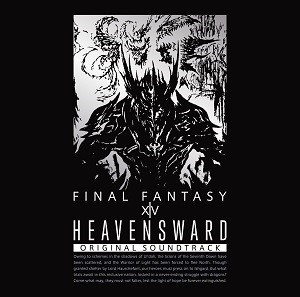
Masayoshi Soken (some original tracks by Nobuo Uematsu)
This is where I decided to listen to my heart. I really wanted to give Undertale the first spot, because speaking as an evaluator, I felt that Undertale was the most consistent soundtrack of the year and the most impressive soundtrack from one single person. However, as I keep playing Heavensward and experiencing what I feel and what my friends feel, I can’t help but to think with my heart instead of my brain. I picked up Final Fantasy XIV after years of Noi asking me to play the game with him and I didn’t really want to start playing it because I wasn’t interested in any of the jobs until Ninja was implemented. Perhaps it might be slightly unprofessional on my part (lol “professionalism” when it comes to organizing a thread) to choose a soundtrack based on my personal biases and experiences that is game-specific as opposed to the musicality of a soundtrack. A lot of my decision-making with respect to this soundtrack has a lot to do with personal experiences, so please bear with me.
A lot of Final Fantasy XIV’s soundtrack, particularly pieces from A Realm Reborn and the 2.x patch content, can be a bit mixed. While some of it is amazing, like Thunder Rolls or Torn from the Heavens, some of it doesn’t feel entirely cohesive. This is due in part by some of the music being remnants from the game that Final Fantasy XIV was, and the game Final Fantasy XIV is today. It is also due in part to Masayoshi Soken having not come into his own entirely yet. Soken has composed for other games, such as Mario Hoops 3-on-3, but these games typically side-games or games that don’t have a lot of traction outside of niche circles. I believe, even since last year, I was waxing poetic about Soken’s work simply based on out of context experiences with his music. Now that I can say I’ve experienced his work in context, it’s even better, and I understand the following he has.
Final Fantasy XIV: Heavensward is, for the most part, Soken’s time to shine in the sun. Although the main theme, Dragonsong, was composed by series’ veteran Nobuo Uematsu, many of its leitmotifs are carried on throughout the entire soundtrack. I do feel as though Dragonsong is more cohesive than Answers; however, that is a personal bias considering I liked Final Fantasy XI’s theme, Distant Worlds, far more than Answers. Truth be told, I did not start warming up to Answers until my Free Company started raiding the Binding Coil of Bahamut more often. That being said, there’s a lot of what Dragonsong does, which works for me more than Answers did (and I’m typically not a huge fan of Uematsu’s vocal pieces at all). Susan Calloway’s diction is, as usual, incredibly excellent. Hearing her voice feels like a gift. As some may recall, I’ve studied vocal music, trained as a mezzo-soprano, so hearing another soprano with a lot of control feels amazing to me. Physically-speaking, it’s hard to control your voice when you get into a higher range and your voice is more of a power voice than a paper-thin voice. My vocal coach and I spent sessions together trying to get my voice under control for Phantom of the Opera pieces where I did both parts when I was younger, even. I’ve come to admire sopranos who can get it done flawlessly, and Calloway is one of them. It’d be an honour to hear this live one day. While the lyrics describe nothing but the legend of Saint Shiva, Hraesvelgr, and the history of Ishgard itself, the way the music is composed, with many of the note holds, some of the simplicity and elegance melodically-speaking, and the feeling and diction emanating from Calloway’s vocals makes the music more meaningful. I feel that way every time I let the game’s opening trailer roll.
Many of the game’s themes revolve around Dragonsong’s motifs. Well, “many” is probably falling short of how many truly use its motif. Despite this, as Thoraxes and I had discussed months ago, this soundtrack demonstrates a lot of Soken’s growth as a composer. Dragonsong appears numerous times in different motifs, from the slowest, most delicate pieces, so the more energizing pieces.
I enjoy the redone prelude, since much of the instrumentation used in terms of strings is more evocative of cold and loneliness, which enhances Heavensward’s thematic elements a little more. I’ll personally be sad to see the theme go when 4.0 rolls around, but I love leaving the game on the start screen just to listen to it even more.
The boss theme, Ominous Prognosticks, is more melodic than the A Realm Reborn boss theme, and it’s even better. It’s easy to hum, and I love the percussion and brass. The percussion drives the entire thing and the strings and brass carry it all the way through, especially frantic bit in the C-section. When the theme launches into the main melody in D, extending into the main Heavensward melody, with the chorus, it’s paced so well with the percussion hitting hard then extending into the main traditional Final Fantasy battle opener prior to the loop. It’s one of the better boss themes in the series, and it’s incredibly catchy.
The Primal themes in this game are different from those of 2.1-2.5. Ravana’s themes demonstrate that Soken’s not all about rock operas or metal. The first half is a hilarious waltz. The strings make this far more than the chorus. But then you’re blasted into the second half with some hot bass (throatsinging) vocals and setting itself far apart from the other upbeat primal themes. The instrumentation doesn’t run far from the vocals, and the brass doesn’t overtake any of the vocals, letting the lyrics play out gracefully. I can just sing “the war still wageth on” when it comes up because I know when it’s coming up in the movement. I like it. It’s one of the better Primal themes in the game because there’s a lot of depth to the instrumentation and care taken in lyrical writing.
For the second primal theme, Bismarck, Soken decides to go with more electronica as opposed to rock or what he did for Ravana. More drum and bass, and it sounds really good. It’s the first primal theme out of the two main ones that I gravitated towards because of the bass. The second phase adds some piano and slight vocals. The bass and percussion stand out more in front of the rest of the music and it’s something I always appreciate in any sort of music because bass anything is my sort of jam. The second portion of the track where the piano is added is nicely rhythmically-paced, integrating vocals. It’s hard to say out of the two primal themes which one I enjoy more, but it entirely depends on my mood.
Heroes is the final boss theme of Heavensward, and it integrates parts of Dragonsong into the theme. Even listening to it while writing this up, I find myself humming the harmony because it’s my favourite part as opposed to the lead melody or the vocal portions. The portions where the main melody of Dragonsong flows in, it’s difficult not to be enraptured by the string sweeps, the percussion, the orchestration, and the brass.
The Azys Lla theme is one of my absolute favourites. I don’t know what to gush about first. The introduction with electronica? The organ melodies (oh hell yeah, the organ melodies)? The theme is a deliberate nod to Final Fantasy VI’s New Continent, albeit with different instrumentation. I love the backing, too. It’s not something you typically hear unless you have a good audio system, but in some good headphones, during the downbeat/piano portion in D, there’s some really nice stuff being done with hi-hats and synth vocals. It’s fairly different from other area themes in the game overall, and it stands out by being a completely different genre from everything else.
I have a very deep affection for Coerthas Western Day, and Coerthas Western Night, simply because they were really the first two themes I went out to experience for myself when I got to the Heavensward patch. The instrumentation in both is so melancholy, hinging on strings and piano in a cold wilderness. At the same timeChurning Mists Day and Churning Mists Night don’t get a lot of love in-context because... well, not a lot of people like that place. It sucks. Musically speaking, both themes are really nice inverses of each other and easily told apart due to a complete difference in terms of instrumentation. One is a beautiful piano rendition, and the other is draped in strings and plucking. The introductions of each piece are fantastic and tender and slow.
Contention, linked previously, is one of my favourite themes in the entirety of Heavensward, and half of the reason is because it’s a very important theme for me. It is supposed to illustrate a deeper connection between two characters in the Heavensward narrative, and hence it’s a graver arrangement, led by a piano, of Dragonsong. However, in a personal sense, I generally associate the theme with Noi and me fighting then making up, or just being together listening to the theme and telling each other that we love each other very much. Thus, Conviction is very important to me, both as a game-player, and as an individual. Musically-speaking, it’s a wonderful grave piano arrangement of Dragonsong, and it doesn’t necessarily build or change outside of synth strings being added in a layer. Nothing necessarily overtakes the piano until a small grave climax in the theme. It’s very tender and I love it very dearly.
I kind of dislike the Idyllshire Day and Night themes, and I find the Hinterlands Day and Night themes fairly unremarkable. I feel like they don’t necessarily add anything musically or add anything with respect to musicality other than “here’s this town theme, it sure sounds like a town theme”. The Hinterlands themes simply use instrumentation that don’t necessarily tug on my ears. By contrast, the Ishgard themes (Pillars : Night / Day; Foundation Night / Day), are much better and more grounded in emotion along with motifs for Dragonsong better portrayed through instrumentation. The piano, the brass, and the organs play out the prestige of a town theme mixed with a main title theme, and it’s a pleasure to listen to every time.
However, the main dungeon theme for the dungeon in the Idyllshire area, Ink Long Dry, is one of my favourite themes in all of Heavensward. That jazz piano is some of the hottest stuff on this side of D4. The bass stands out, and while the time signature for this piece is weird, and everything about the piece is so weird, it’s the most relaxing piece in the entire game for me outside of another soon to be mentioned. Jazz fused with some weird instrumental hip hop in the main portion of the track, and it sounds so good.
Out of the two postgame dungeons in 3.0, I like The Fractal Continuum more (not just because my damage-per-second shoots through the roof based on my job, but it doesn’t hurt!). While Neverreap sounds like a standard arrangement of The Sea of Clouds, Fractal brings its own fun melody to the table with organs, synth, a nice backing guitar, fun backing percussion and hi-hats, a nice little piano. But man, listen to that percussion. It’s almost to die for and I’d love to drum that myself if I ever got better at playing the drums.
The Alexander themes are a true treasure. It’s something you kind of expect from the area, and from Soken himself due to his previous work and which genres he chooses to set his themes. The ambient theme doesn’t get a lot of play, and honestly due to the area, it doesn’t get a lot of love either. I kinda dig it because it reminds me of 90s rave music. The electric guitar melody is pretty hot, the organ is hard to hear but it adds a lot of melody, and the backing synth is jammin’. The one theme that everyone loves (well, not Jucksalbe :V :V) is the boss theme! This shit right here is super-hot. The lyrics are hot (dc, dying, dying, electricity!), the percussion is so fucking good in almost every section of the theme (particularly A-portion prior to a verse, with the electronica). The introduction is so good, and I’d love to hear an entire piano quartet rendition of the entire theme because of that. Sometimes I go in, hum one part of the melody and Noi hums the other for the harmony and it feels so good to know someone else gets it.
Metal is probably the one theme that some folks who don’t play the game might know? There was a live version done at a panel and some non-FF14 players thought it was hilarious on my timeline, anyway. The lyrics are lore-specific, with FF14’s Goblinspeak pervading throughout the entire theme. This is where “No Busydeals For the Wicked” comes from, and you can’t help but to sing along to it to have something to laugh at because folks aren’t doing their jobs in the raid and not picking adds up when they should also the tank isn’t stunning the legs ... and... what? Metal is a theme that’s more or less a typical Soken theme. The lyrics don’t kick in until the battle actually starts and someone’s hitting something. The instrumentation is so caustic, particularly due to the reliance on hard percussion coming from all angles. The synth and the electric guitar pick up at a fantastic point during the theme’s chorus, and I especially love the bit during the second verse with some of the off-beat string points. It’s so frantic and sounds added in because they were late to the party, but it fits so well.
The 3.1 themes are a bit hit-and-miss. The Diadem and its battle theme sound great for the first few times, particularly because they invoke the traditional prelude, and it hinges on more of an orchestrated sound as opposed to the rock or gothic themes that we usually get for raids. The B-portion of the former theme is probably the best part of it as opposed to the introduction which includes the prelude, because it sounds more militaristic due to the percussion, and yet, it evokes a sense of wonder due to the brass and flute. That being said, like any MMO theme like this, it gets very repetitive very quickly, particularly before its loop. The battle version of the Diadem theme is really cool due to the pacing of the track, and because it integrates the classical Final Fantasy battle theme introduction. I like it far more than the exploratory theme, and I kind of wish it had a longer loop because I’d rather hear that for 90 minutes straight as opposed to the exploratory theme.
The two dungeon themes in 3.15 are really good, though one is old. Pharos Sirius only got a new (very excellent) piano introduction, and I wish the rest of the piece were more arranged to set it apart from its easy mode predecessor. Saint Mocianne’s Arboretum is gorgeous. I’ve used it as study music. The woodwind introduction, with the piano D-portion is my favourite. Never mind that the dungeon itself is gorgeous; the pacing of the track itself, particularly in its C-portion with its pacing piano prior to the loop and the B-portion relying more on strings and guitar, allow the player to perceive a sense of beauty and magnificence with respect to a slight reference to Final Fantasy IX. It’s a very nice arrangement of the Dravanian Hinterlands theme, and it makes the theme even more respectable.
The new Vanu themes are so well-done to me. They’re so evocative of some Genso Suikoden III pieces that tried to inspire the same tribal tone but those themes weren’t always so successful at it. I especially enjoy the piano in this theme, combined with the underlying backing and percussion. It sounds so frenetic and disjointed, but it works so well, and I’m glad that these themes were integrated into the patch. The Gundu theme may not start off as strong, but its final portion before the loop has an excellent orchestrated background with a flute lead. I couldn’t help but to think, upon hearing the themes in the patch for the first time, that Soken grew a little bit. He’s not confined to rock anthems or electronica anymore. He can still land into traditionalist territory and set himself apart.
I don’t have much experience with the Lords of Verminion theme because I don’t usually do the event. But man, it reminds me of Mortal Kombat. It’s so easy to dismiss it because of the electronica backing and the percussion, but the best part of it is the violin passage. Even then, it’s unfortunate that the loop is so short, when matches are apparently five to ten minutes long.
The Void Ark themes are probably the best new pieces of music in the 3.1 patch. While traditionally gothic, it’s not every day that we get organ and piano-filled themes like that in Final Fantasy XIV. Void Ark’s Calm Theme relies on its organ, its piano, plucking, and softer percussion. I feel like I know the melody in and out because I have someone humming it in my ear every time I run through the dungeon with him. There are times when I literally have to tell him to shush because I’m concentrating on healing or hitting a thing, but it honestly makes me love the melody more because it tells me that the melody is quite catchy. Even during the battle theme, I can’t help but to sing the main melody along with Noi because it keeps me at ease when I’m in a tough situation. I do enjoy that the brass became more prominent in this version as opposed to the organ and piano in the former. The Echidna boss theme is still a variation of the Void Ark theme, but it includes choral work, more brass, and more percussion. The bells return and there is a sweet interlude in the C-portion with the original organ and flute before picking up to the main instrumentation.
The final theme added in patch 3.15 is the (final boss spoiler) Primal Extreme boss. Some people kinda hate because it’s not enriching enough, but I love it. I love the B-portion, post percussion introduction, with the piano prelude joining an arrangement of the main final boss theme/Dragonsong arrangement. It’s a good arrangement in a completely different key. After the big bombastic portion finishes, a piano transition occurs which I absolutely adore. It’s backed by synth and very little percussion, and the portion slightly arranges the Azys Lla theme. It then transitions to a paced choral portion of Dragonsong with a final brass fanfare before looping. I haven’t done the fight yet because the running joke is that my FC is busy doing silly distracting things instead of new content (hey man, 3-4-manning content is plenty fun!), but man I’m sure I’ll love it in context when I do finally do it.
I had asked Noi to run the Aetherochemical Research Facility with me on Friday because I was still struggling to vote between my heart and my head. And after our run was over, I realized that I should go with my heart. Listening to Dragonsong arranged with more percussion and emotion (brass/piano) made me realize a lot of things. Heavensward as a whole brought me closer to a lot of other people whom I consider good friends of mine. It brought me much closer to Noi in ways I wouldn’t have dreamed of three years ago. Talking about our experiences with the soundtrack, a few of us singing the soundtrack to each other, going “whoa” at some new pieces of music, and gabbing a whole lot about different parts of it made me realized that maybe it’s not so bad to go with your heart once in a while.
From a technical perspective, Heavensward’s soundtrack is not perfect. It definitely has a few duds. Speaking from standpoint reflective of soundtrack cohesion, while Heavensward elects to use Dragonsong everywhere throughout its entire soundtrack, it isn’t successful in some areas, and it ends up being dragged down because of it (ex: Sohm Al; this is an arrangement for the sake of an arrangement to me). Heavensward’s highs more than make up for its inadequacies, however. This soundtrack, despite essentially being a motif arrangement soundtrack, demonstrates that Soken has grown very much as a composer since A Realm Reborn. And patch content demonstrates that he still is growing. I look forward to seeing what Soken does next, and I genuinely hope that he gets attached to a mainline single-player Final Fantasy game for everyone to experience his work.
1 note
·
View note
Text
Noi’s Games of the Decade (2010-2019)
The last decade of video games sure feels like a long time, given that it spans almost the entire length of two console generations. Lots of new franchices, sequels and the rise of ports and remakes have led to a landscape very different from the one the generation started on. From among that sea of chaos, here are some of my top choices, whether because they were my favorites or influenced me in some way. Text size and image spam per entry may vary.
Dark Souls (2011, FromSoftware / Bandai Namco)
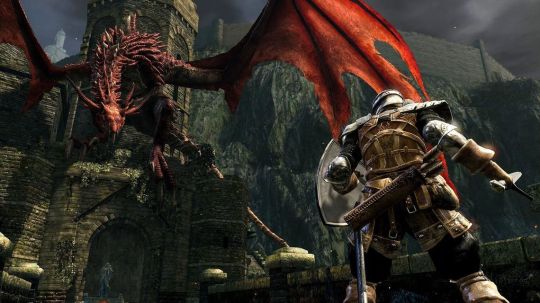
Let’s get this one out of the way.
Dark Souls is a landmark title that uprooted and changed most games as we know it. While far from my favorite entry in that series, there can be no denying a game that serves as such a bar for comparison that everything gets likened to it. And it isn’t hard to see why, either. At this point in the generation, there was a wave of released games that placed a heavy emphasis on narrative and presentation, choosing to present big bombastic set pieces at the cost of its core gameplay. From among the Uncharteds, Mass Effects and Deus Exes, comes this really janky action RPG that tries and succeeds at proving that you can release a difficult, intense game that focuses on player skill, growth and exploration and still get the attention of the masses.
Which isn’t to say that Dark Souls lacks a narrative or a story, it’s just not as important. The game’s word is created in such a way that you feel like an intruder stepping into the middle of an ongoing, nasty affair. Connecting passages, doors, elevators and tunnels make the locations feel real and persistent, rather than being just a linear set of levels to clear. The story is there, hidden within item descriptions, world design and indirect story telling, but the choice is given to the player on how much they care to invest into learning all the pieces of the puzzle. Even then, there are a lot of blanks to fill that are left up to the player’s imagination and interpretation, not unlike games of decades past. I spent an admittedly long time just trying to piece together how things connected and how characters were related, further becoming invested in the miserable world FromSoftware created.
An important factor to talk about regarding Dark Souls, which ends up being crucial to the experience, is the community that builds up around each game. Built-into the game is a system that allows you to leave messages for other players, some giving helpful advice on how to avoid traps and reaching hidden areas, others intentionally misleading players into deathtraps and pitfalls. This aspect of the game actually extends to things like wiki entries, where players pool information on how to overcome the game’s boss fights, farming strategies or discuss hidden lore details. Playing a Souls game on release, with a community of players all scouring and excitedly sharing information is a very different feeling from playing them any time down the line, once they’ve been figured out and thoroughly examined.
Dark Souls is far from perfect. The second half is made up of mostly recycled assets and has some of the worst designed boss fights in the series. Bugs and glitches are pervasive everywhere. But there’s a clear attention to detail in the way the game is presented, in its NPCs, its gameplay, its environments and even its item placement, that resonates among the people who play the game. This care and attention continued into FromSoftware’s later releases, leading to multiple sequels and sub-series. It influenced every other action game that came forward, causing other franchises to even copy its control scheme and structure. Everyone wants to be Dark Souls, but much like the Call of Duty craze before it, it’s hard to do so without feeling like a hollow copy.
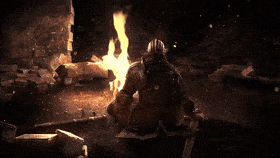
Amusingly, its this trend that Dark Souls started that leads right into…
Sekiro: Shadows Die Twice (2019, From Software / Activision)

With three sequels and one Bloodborne under their belt, FromSoftware were looking to try something decidedly different from what they’d done up to this point. Rather than make a new action RPG along the same lines, they opted to make… an action game with light RPG elements. Okay, maybe not that different, but hear me out.
I love Sekiro. It’s up there with Demon’s Souls as my favorite game in their lineup, precisely in all the ways that it both is, yet isn’t like a Souls game. All those same wrinkles that I praised Dark Souls for are present here, but in a significantly more polished fashion. Because it’s an action game first and foremost, a lot of the thought normally put into things like character builds, stat allocations and weapon choices instead are focused on techniques, sub-weapons and your own ability to parry enemy attacks. Sekiro shares the same framework as earlier games, but feels way more dynamic and free-form as a result, as I grapple my way through areas, sneak kill enemies and just proceed with a much brisker pace than its Souls brothers allow.
When I started playing Sekiro, I basically treated it like I did all the prior Souls titles. Slow. Methodical. Strike at enemies, side dodge their attacks, strike again. This approach got me nowhere fast. My fiancée laughed at me as I died for the umpteenth time to the same mini-boss. General Naomori Kawarada had my number, and he knew it. So I ventured in a different direction, only to stumble into another spear-based wall of similar difficulty. Clearly I was doing something wrong. It wasn’t until I reach I reached Genichiro Asahina, the man who curb-stomps you in the game’s prologue, that the game’s many attempts at getting me to learn how to play finally clicked in place. Sekiro isn’t a game where you wail on an enemy until they die. In fact, you don’t need to strike them at all if you’re good enough. Parrying is the name of the game: it increases the enemy’s posture meter and, when it breaks, you can land a deathblow on them. Reducing enemy health simply makes the posture meter reduce at a slower rate, making it easier to break as fights go along. It’s this tense back and forth between offense and defense that make encounters in Sekiro such an intense experience, with the feeling of victory washing over me after every bitter encounter.
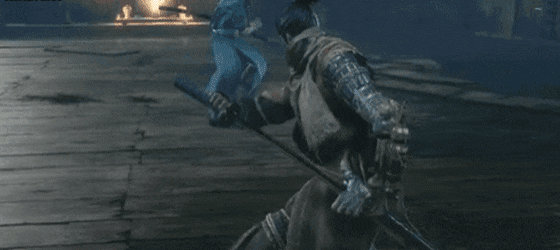
No multiplayer means battles can’t be cheesed through player numbers, but the social information sharing becomes even more relevant than before. Enemies and boss fights have so many intricacies and details, from specific attacks and unique ways to counter them, to the different effects that subweapons can have on them. Each time I watch someone play the game, I discover a new strategy or trick on how to clear an enemy that I struggled with. I watch as that same person is blocked by sections that I had an easy time with due to discovering a strategy or trick they didn’t know. The kicker of course being that knowing all this information isn’t enough: you still need to get good enough at the game’s systems to execute everything you read about rather than discovering a single overpowered weapon that trivializes the game.
With another fantasy game on the horizon from developer FromSoftware, I can only hope that Sekiro continues to be supported the same way its previous titles were. I’d love to play more of this game before they move on to something new, specially if said new game is more like Souls and less like this one.
Resident Evil 7: Biohazard (2017, Capcom)
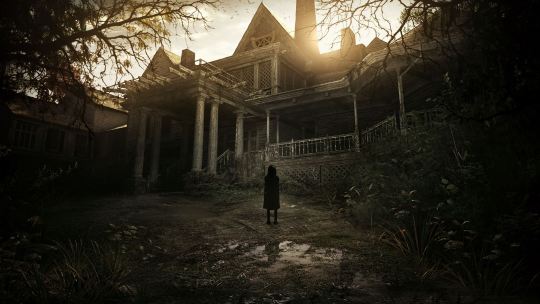
Resident Evil is weird. A franchise that’s gone through many ups and downs due to questionable choices from its developer Capcom. Coming on the heels of the most polarizing entry in the series and many requests to “return to its roots”, RE7 was a sink or swim test to see if Resident Evil could recapture the spark that had made it such a success in the first place.
I personally don’t have that much love for franchise as a whole. While I somewhat appreciate the original titles for what they did at the time, I never found the act of playing the games all that much fun. With RE4 taking the franchise down a more action-heavy path, I felt like the mainline entries started becoming basically bog standard action games (and in the case of RE6, not particularly good ones). RE7′s January release came and went, and I kept hearing about how the game was such a great revival of the aspects that made Resident Evil special in the first place.
Boy, was I not prepared.

Effectively a soft-reboot for the franchise, RE7 discarded all of the baggage carried on for more than a decade in order to present a new story with a new set of characters and a new setting. No Umbrella Corp, no Jill Sandwiches. Rather than another world-threatening virus, this game opted to tell a more local, personal story, with small scale encounters to match it. Rather than the action focus of earlier games, you don’t machine gun down hundreds of zombies and punch boulders out of the way. RE7 makes single zombies life-threatening and dangerous to manage. It feels like it belongs to a completely different compared to the three games before it, in a good way.
RE7 is creepy. It’s unnerving. It’s distracting. Sneaking around the Baker residence, knowing every member of the family wanted me dead. Skittering noises and subtle, distant groans keep you on your toes. The oppressive atmosphere and lighting makes you fear ordinary household items while a shadow slinks away in the background. You know a horror game is doing its job right when you dread actively turning it on to play, which is how I felt during my time with it. Sometimes a game doesn’t have to be all out scary. All it needs to do is make you feel like something is actually looking over your very real shoulder.
I hope Capcom takes notes from this game’s success and builds on it, but without veering back into the track that led to the series’ action titles in the first place. We have enough of those as it is.
The Binding of Isaac (2011, Edmund McMillen)
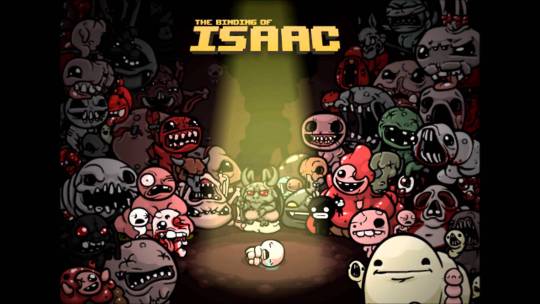
Roguelikes are hard to get juuuuust like for me. I don’t mind the idea of starting fresh on new attempts through the token dungeon/labyrinth/whatever, but I enjoy having some form of progression to mark just how much time I’ve put into the game. On the flip-side, permanent progression can make the game really unbalanced, with either cranked up numbers and difficulty raised to compensate for your ever increasing stats, as the game has to account for the increased levels in order to continue providing a challenge.
Enter Isaac. I first caught wind of the game through some random streams, as I watched people attempt run after run of twitch-based shooting in a rather messed up setting, with all sorts of creepy monstrosities. But more importantly, I liked the idea of Isaac’s takes on the genre: starting from scratch while having progression-based unlocks that you could acquire on successive runs depending on RNG. But ultimately, whether or not you clear isn’t truly dependent on said RNG, but due to not being an RPG, instead relies on your own skill and ability to make the best of the items you find along the way.
Enter basement. Die. Learn potential floor layouts. Enter basement. Get further than before. Experiment with trinket combinations. Die. Enter basement again. Get even further. Learn more. Repeat. Reach Mom. Unlocks new floors. Go again. Unlock new character. Learn how they’re different. Die some more. Unlock more stuff. This constant loop was enough to entertain more for 51 hours in the original Flash version, then double that on the remake. I’d still be playing that version, but the developer for it isn’t one I particularly care to support anymore, which is unfortunate.Still, what original Isaac is lacking in sheer amounts of content and engine upgrades, it makes up for in art and tunes. Edmund McMillen’s gross, unnerving art style is shown in full display, while Danny Baranowsky’s tunes are arguably way better Jams than the replacement soundtrack from the Rebirth version. It’s not just me either: Isaac’s popularity has influenced a whole slew of games like Slay the Spire and 20XX, both of whom proudly wear the influence on their sleeves. A good legacy for a great game.
Five Nights at Freddy’s (2014, Scott Cawthon)

The story of how Five Nights at Freddy’s came to be is pretty great. Scott Cawthon, who had only created family-friendly christian games up to that point, had received tons of criticism about his characters looking like scary animatronics. While initially discouraged, he took that feedback and created a horror game using the same style of characters. The game took off immediately, with much buzz among people online talking about the out of nowhere indie title scaring the world by storm. Now there’s tons of sequels, spin-off media, and even a movie in the works, all born from said criticism. It’s a pretty great underdog story.
FNAF’s concept itself is fairly novel too. Rather than play as a character who has to explore a creepy location while running into monsters and scary things, you play as a stationary security guard who has to avoid getting jump scared by the monsters that slowly but surely come to you. You must manage your power reserves while looking at security cameras and flicking doors on and off to prevent animatronics from coming inside your room, doing so long enough to survive until 6 AM. The different animatronics respond to and behave in different patterns, so the player has to learn how to juggle them and survive.
The thing is? I’m a big coward. So I’ve never played a single one of these games.

I’ve never really been one for watching Let’s Plays, partially due to not having much interest in the idea of watching people play video games when I could just do it myself. That basically changed once I started watching people like Markiplier experience the spooks that I was too much of a coward to go through myself. Starting from 2014, I’ve basically spent years just watching him go through every game in this series, wincing along at every unexpected jump scare and even tabbing out of the video when I knew something would pop up. As a viewer, I feel like I got my own unique experience that I wouldn’t have had from just playing FNAF alone.
And it’s not just this game too. This game served as a springboard for the idea that there is some value in being a passive observer for someone else’s experience through something. So what if I wasn’t the active participant? I’ve read all the wiki entries. I’ve looked up supplementary material. I’m just as invested in the characters, setting and lore as anyone else. Though obviously not an expert at playing the games, my time with this series isn’t any lesser than someone else’s. There clearly must be something to it, since movie theaters wouldn’t be as popular as they are if crowd watching something wasn’t popular.
Maybe some day I’ll put on my big boy pants and try to play any of these games. Until that day comes though, I’ll just watch someone else do it instead.
World of Final Fantasy (2016, Square Enix / Tose)
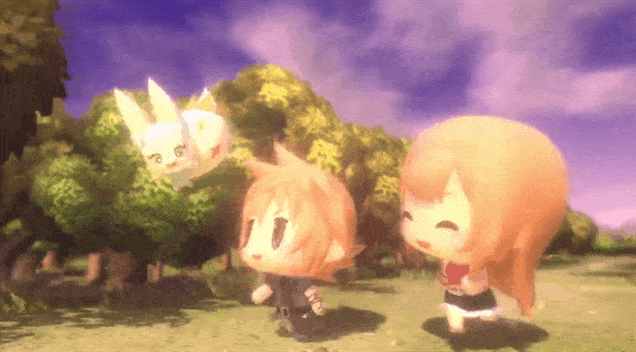
The fact that this isn’t celebrated as Final Fantasy’s 30th anniversary game is a crime that continues unabated.
Announced in the same press conference as the Final Fantasy 7 remake, World of Final Fantasy has always been a game that’s been criminally overshadowed by a larger release from the same company. WoFF was released just a month before the series’ next big mainline title, despite it being the game that actually showed more love, care and attention to the legacy of the series. No, not just because it’s crammed full of fanservice. That’s just the icing on an already solid package.
The game stars Lann and Reynn, twin summoners that are able to capture and control creatures known as Mirages. If you’ve played a Final Fantasy game before, you’ll easily recognize these creatures since they encompass almost every common enemy, summoned beast and staple from the franchise. Mirages vary in both size and abilities, which is important due to the ability to create “stacks” of party members according to their size. While you don’t get to play as any of the mainline FF characters (until the latest DLC update anyway), they can be summoned to unleash powerful one-time effects: both supportive and damaging. WoFF does an incredible job of introducing people new to the series with many of its legacy characters and staples, as well as featuring its own sincere and genuinely touching story of hope versus adversity (which isn’t afraid to get dark when the time comes for it. Seriously.)
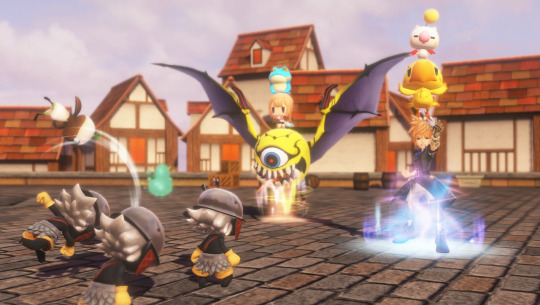
Collecting and raising Mirages satisfies my need for a slightly more complex Pokémon game. You only ever control the two main characters, Lann and Reynn, but their attacks, stats, spells and abilities are determined by the Mirages you assemble in either character’s “stack”. Once you’ve min-maxed the heck out of your party composition of choice (or played with your favorite Mirages, like me), you can tear through random turn based encounters with either relative ease or absolute difficulty depending on how effective said combination of Mirages works. Because you almost always have access to your entire collection of captures critters, it’s really easy to swap them in and out as needed. You use specific types of Mirages to traverse through the overworld too, but thankfully the selections for monsters to use for that are relatively flexible.
Having played through WoFF with my significant other, we both had a lot of fun capturing, experimenting and using completely different setups to go through the game. Naturally we each had sections we breezed through while the other one struggled, which let us give each other advice on how to progress through the game. There’s virtually no ineffective Mirages in the game due to the nature of stacking, since it’s easy to find a different sized monster that compliments your other choices.
I could spend forever gushing about how much I love World of Final Fantasy. I The music, both its original tracks by Masashi Hamauzu and its plethora of Final Fantasy arrangements by Shingo Kataoka, is made up of nothing but bangers with zero duds in between. The writing and localization is top-notch, with personalized descriptions for every single Mirage in the game (there’s 200 of them!) that both reference and poke fun of all kinds of series trivia. The incredibly cute art style that makes me smile no matter what I’m currently feeling. If there’s a single Final Fantasy title from 2016 that should be put on a pedestal and remembered, it’s this one.

Final Fantasy XV sucked anyway.
Kirby’s Epic Yarn (2010, Good-Feel / HAL Laboratory / Nintendo)

It was February 2013. I had just finished playing through the second game in an awful PS2 platformer series that had just about sucked the positive vibes out of me. Feeling quite blue and depressed, I looked through my backlog of unplayed titles to see if there was something that could clear the funk out of my system.
As I stared into the dark void, a bright pair of beady blue eyes stared back.
The Kirby series has always sort-of been Nintendo’s trusty workhorse series. Kirby games don’t really push the same sales numbers or earn the same sort of accolades that its contemporaries do, but it always has some form of presence on their systems. This allows the franchise a form of flexibility to try out new ideas or concepts that would seem appropriate for the ball of pink fluff to explore, whether its making a compilation of eight micro games or a racing game, to turning him into a stylus controlled ball or a swarm of clones. It’s that same freedom that led to the creation of this lovely game.
Kirby’s Epic Yarn is the ultimate feel good title. The funk I mentioned a moment ago? By the end of my time with Epic Yarn, I’d already forgotten what I was sad about. The game does its best to pull you into its warm, fluffy embrace, with soft characters and smooth backgrounds and a cheery/upbeat score that never fails to make me smile. There’s no danger of death or being injured, so you don’t really need to concentrate or stress too much while playing. When you smoosh enemies they crumble into little yarn pieces. When you unlock a new level or world, the cloth and textiles that make up the world spring to life and expand to reveal cute new animated yarn creations. Kirby transforms into different vehicles of mass destruction but they’re all so cute and have his smiling face on it, so its easy to forget exactly what he’s doing.
I mean, just look at the Kirby submarine.

I think my fiancée is rubbing off on me.
Personally, Epic Yarn is the series at its most creative. There’s only so many times they can remake Super Star before my interest starts waning, which is what most of the Kirby platformers after it most amount to. I’d rather have another one of these than another one of those any day of the week, specially as a game to fall back to on a bad day.
Yakuza 0 (2015/2017, Ryu Ga Gotoku Studios / Sega)
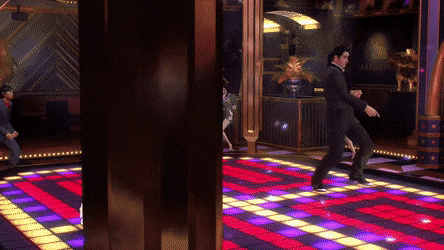
Yakuza as a series is pretty eccentric. From its director/producer, its JAV actresses turned 3D models, to its unapologetic asset re-use in order to both keep budgets low and be able to churn out new yearly releases. This latter point can be a big point of contention for many people, but it actually adds to the one element that I find myself appreciating most when it comes to the franchise.
See, I live in a neighborhood where there’s only two roads you can take to get to places. Said roads are lined by all sorts of businesses and builds, like fast food restaurants, two story complexes and small businesses. I’ve been driving back and forth through those roads for almost 20 years now, watching as stores go out of business, are bought out and re-populated. I’ve seen entire complexes get demolished to make brand new buildings. I’ve watched as the old two-story building where I used to get tutored as a kid grows greener, mossier and more overrun with plants as the years go by. Even though nobody goes there anymore, my memories of time spent there still remain all these years. It’s the same everywhere else: I recall the single time I ate at this one restaurant. The one building where I worked part time for a month. The gym whose membership I let run for way too long. So many businesses, houses and locations that I’ve frequented either many times or just once, that carry on even though I’m no longer there. Inversely, maybe tomorrow I’ll have to drive to a house or building that I’ve seen many times before, but have never had a reason to go there until now. A place that has existed this whole time, but until that moment, had never been acknowledged by me.
Yakuza, probably not intentionally, invokes the exact same feelings in me. I’ve walked down the streets of Kamurocho many times. I’ve seen the city change and evolve as the years go by, from the of the 80′s as depicted in Yakuza 0, to the modern age styling depicted in Yakuza 6 and Judgement, its related spin-off game. I remember locations where important story events occurred, where entire sub-stories developed and concluded. Some games take me insides complexes that had been completely ignored in games prior, while later games may just give a nod at the events that occur in the now vacant lots and inaccessible interiors. But even though the dramatic events may be long over, my memories remain as I stroll down the familiar alleys and look at the flashing lights of the oh so subtly changing Kamurocho. The city doesn’t undergo that many dramatic changes, but as someone playing as long as I have, even the subtle twists are felt once I start feeling around.
That’s the feeling I get any time a new game in the series is released, as I prepare for a new trek down an old familiar street, not knowing what I’ll experience in the immediate future. It’s a really precious feeling.

So why Yakuza 0 in particular? Honestly, it’s the best one of the lot. Not only is it a great starting point for people afraid of jumping into this long running series, it honestly feels like the one influenced by the most creative ideas, some of which have gone to become series staples or influenced other features post-0. The time period the game takes place in is distinct compared to the others too, as its the only game that takes place before the 2000′s. It’s two playable protagonists present two alternate perspectives to the ongoing conflict and very different play-styles to enjoy, each with their own major side activity to pursue as a means of earning money.
If you’ve never played a game in this series, give it a try. If you’ve lapsed from too many of them being out there, also give it a try. If you’ve played every other game but not this one… what are you waiting for?

Assassin’s Creed 4: Black Flag (2013, Ubisoft)
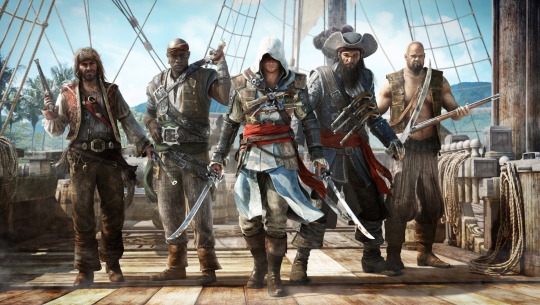
There’s something wild about the fact that the entire Assassin’s Creed franchise grew to become the colossus we know it as within the span of the last decade. Brotherhood, the follow-up to the incredibly successful Assassin’s Creed 2, kicked off the annualized release pattern the series would soon follow, expanded on the concepts introduced in AC2 and gave the world more of Ezio Auditore da Firenze, an iconic character whose popularity still lingers an entire decade after his introduction. By the time Brotherhood’s successor rolled around the following year, it was time to move on from Ezio and proceed to the next phase, not an easy act to follow-up on. Initial previews for Assassin’s Creed 3 seemed promising, showing the oft-requested setting of colonial America and featuring a native american character as its protagonist. How did AC3 fare upon release?
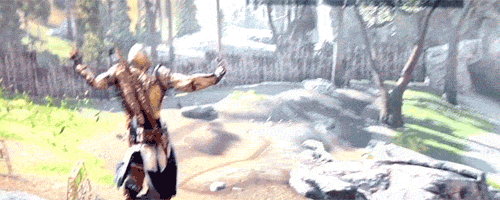
It was bad.
Unfortunately for me, AC3 was the one entry where I’d decided to go all-in on. I bought the premium super edition. I picked up my copy on its midnight release. I dumped hours into what I thought was going to be the best game in the series. After all, after the Ezio trilogy had been so great, how could AC3 be any worse than those? It didn’t take long to get extremely burned on what I thought had been a publisher/developer whose output I’d previously have 100% of my trust. If anyone ever wondered what drove me to be as critical of the media I consume as I am today, Assassin’s Creed 3 can take a large part of that responsibility.
There’s a laundry list of reasons why AC3 failed as hard as it did, without even taking into account more subjective opinions like its protagonist not being an interesting character or the setting not actually being all that interesting. Rather, the entire game had an absurd lack of polish, huge performance issues, a significant number of game breaking bugs or glitches and a fundamental misunderstanding of what made the Ezio trilogy fun: slowly trekking through boring, barren landscapes, completely un-intuitive UI, poorly designed side activities and terribly-structured narrative that barely made use of the setting where the game took place. While those were all things slightly addressed in the game’s downloadable content, the damage had already been done.
When details started popping up about Assassin’s Creed 4, I was naturally very skeptical. “lol they’re rushing to the next numbered entry because 3 was such a stinker”, I thought. Even as more promising details came to light, I didn’t really have much interest in immediately picking the game up. Enough damage had been done after all. It was only when I decided to pick up a PS4 at launch that I gave in and gave the series one last chance.
I’m glad I did.
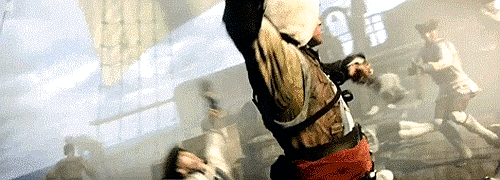
While AC4 was built on the same fundamental structure as AC3, it’s blessed by having more time to flesh out its ideas and structure. Gone are the barren landscapes, replaced instead by the rolling seas and densely packed islands on the Caribbean. Sailing, which started as just an overlook-able side-activity in AC3, was fleshed out and became your main form of travel, with upgrades and customization options fleshing out what you could do with your ship. Combat once again featured a radial menu to select your weapons and tools that didn’t take you completely out of the action. An expanded assortment of firearms and assassination tools allowed for new ways to sneak through enemy locations or rampage through a barrage of combatants. It’s a true return to the highs of the Ezio games, with all the charm and creativity befitting the era it takes place is.
As someone who lives in the Caribbean, it’s very rare to not only get the kind of representation that AC4 brought to the table, but for it to be done as respectfully and accurately as a game featuring topics like slavery could be done. That bundled together with probably my favorite combination of story, gameplay and side activities lead to an experience that the series hasn’t really managed to top for me. Sadly, with the way Assassin’s Creed has changed over the years since then, this will probably remain the last truly high point for my own enjoyment.
Undertale (2015, Toby Fox)

If you’ve read more than one “games of the decade” write-up, seeing this name pop up among the list shouldn’t really surprise you. I’d honestly be more surprised if you hadn’t. The surprise smash hit of the decade has managed to sneak into everything from concert recitals to fighting game downloadable content, in no small part due to what a tight, lovingly crafted package it is. I’m not really going to get into any of those details, because plenty of significantly more eloquent people, my fiancée included, have written about what makes this game special.

Instead, here’s a short list of things Undertale taught or reminded me.
1. Every person, no matter how big, small, square, round, human-like or furry they are, has the potential for an interesting story.
2. Properly implemented leitmotifs that change and echo through the game are rad.
3. A game doesn’t have to be 50 hours long to leave a permanent impression.
4. Just because a piece of media has an intolerable fan-base/community doesn’t mean the content in question is as bad as them.
5. Kickstarter can actually fund some quality stuff, once in a while.
6. Just because something exists in a video game doesn’t mean you need to force yourself to experience it. If it isn’t fun, it isn’t fun.
7. Uhh.
8. Dogs are nice.
9. Anime isn’t real.
10. Writing lists with actual points is hard. No wonder click-bait is popular.
Asura’s Wrath (2012, CyberConnect 2 / Capcom)
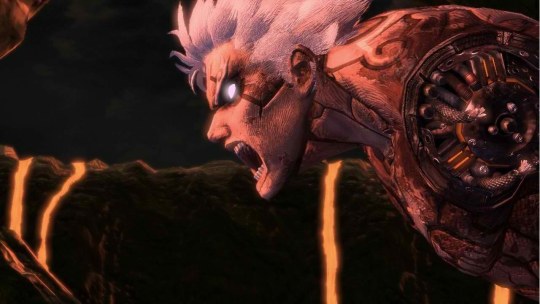
If there were ever a textbook example of a game completely and utterly sent to die, it’d be this one. With a terrible demo before release, a non-existent marketing campaign, and the worst post-release support ideas at the time (releasing the true ending as extra downloadable content was not seen as a popular move). All the external decisions made about this game led to it being unceremoniously buried and forgotten, never to be seen again even in this decade of ports, remasters and remakes for even the most obscure of older titles.
It’s a shame too, because if you’ve ever wanted to see how to perfectly portray a battle shonen anime is like in video game form, this is what you’re looking for.

Asura’s Wrath is a game I never knew I wanted to play, but very quickly fell in love once I did. Knowing what I do now about the fate of the game, I feel bad about picking the game up at a quarter of its full price, but that terrible demo really did make for a bad first impression. The game stars Asura: one of several deities who oversee the Earth and purify it from the Gohma, demons made up of all of the earth’s vices and impurities. After many dramatic twists, Asura is framed, betrayed and set against his fellow deities to rescue his daughter Mithra, with the occasional help of his best frenemy, Yasha. Asura’s Wrath could have been a simple series of punching bouts strung together, but the cast of colorful character genuinely draws you in and charms the heck out of you. Asura’s Wrath will put you through the entire range of emotions, with some really touching moments getting me to genuinely sympathize with the struggles of the game’s two protagonists.
Of said emotions, anger is naturally an important one, though not necessarily in a good way. Important enemies in this game don’t really have health bars. Rather, punching enemies fills up your wrath/burst meter, which makes the fight progress to the next phase. These intermissions are where the game gets the most exciting, with plenty of quick time presses timed with the action (though these only affect the final score, so really, they’re just there for show). Where anger might unintentionally factor in, unfortunately, will be in the many times the game stutters, tears and lightly hangs when the action gets really intense. Poor performance is Asura’s Wrath’s one glaring weak spot, as its easy to tell that the majority of resources went into polishing the presentation instead. It’s a shame too, since said performance problems also leak into the combat sections, making some bits more frustrating than they should be.
But to put such a huge spotlight on combat (like Capcom did) is doing Asura’s Wrath a disservice. The combat sections are the connecting tissue between the lovingly crafted, bombastic, wall-to-wall insanity that is the game’s cutscenes. Two deities will wax philosophically about the worth of a single human being vs the whole of humanity before one launches the other from the moon to the Earth, then impaling them with a sword that covers that entire length. In another tragic moment, the game’s entire color pallet dynamically shifts to and from grey-scale before fading to white. The absolute care for every aspect of the game’s presentation in every moment of every scene, from its most climactic battles to its most somber moments is really what makes this game as special as it is. When you have a development team that even measured the timing of achievement/trophy notifications and used them to maximize either comedic timing or dramatic moments, you know you’ve experiencing something special.
Asura’s Wrath’s rough spots weren’t really enough to damper my enjoyment of the game, however. Like I said, Asura’s Wrath is a game I didn’t know I wanted. The more I played it, the more engaged I became, the more I liked the characters and story presented. There really is no game like it out there with such a unique concept and execution, and its a real shame that, given its reception,it’ll likely be the last of its kind. I’ll just be in a corner, sulkily whistling a familiar tune to myself.

Final Fantasy XIV: Heavensward (2015, Square Enix)

It’s hard to put my feelings behind Final Fantasy XIV to words. What started as curiosity about the franchise’s new (and unknowingly, doomed) online title in 2010 has morphed and evolved into something of a lifestyle. Having signed up since day one of the game’s relaunch in 2013, it’s difficult to be even remotely objective when talking about a game that has both accompanied and assisted me through many difficult periods in my life I’m a testament to the power of online games: I met some of my best friends through FFXIV. I’ve ended friendships through it. I’ve dealt with the death of known acquaintances, their online data living on as a form of digital tombstone.I started and graduated from college while playing the game. I learned how to manage my own finances and spending habits with the game’s subscription model. My relationship with my now fiancée blossomed and became serious through our interactions and bonding activities that FFXIV enabled. It’s no wonder I half-identify with my digital in-game character, one who I’ve customized and molded through the years. Even now, with my interest in the game at its lowest point due some pretty disappointing design choices, I can’t imagine when or what it would take for me to stop playing the game.
Out of the four major launches in the game’s lifespan, the Heavensward expansion is where I believe Final Fantasy XIV was at its best. The relaunch had done a good enough job of restoring my faith in the franchise after a run of subpar spin-offs, re-releases and mobile releases. While not without its downsides, Heavensward and its post-release patch content fired on all cylinders, introducing and fleshing out what are now some of the game’s most memorable characters, plot twists and settings. So popular that to this day, content, locations, enemies and characters introduced in Heavensward continue to be utilized to this day.
While always subjective, all the playable job classes felt diverse and unique among each other, each bringing something to the table that others couldn’t do. Each job has its own nuances and barriers of entry, which provided a nice challenge while on the road to being able to optimize and synergize each role’s talents, with some jobs having much higher skill ceilings than others due to their very design. While that may have led to some level of exclusion (lord knows some jobs were under-powered for most of the expansion), I much prefer that over the game’s current trek towards making every role incredibly similar to achieve some vague notion of “balance”.

The sad part about ongoing service games is that, as the game develops and changes, it becomes impossible to return to what one believes were the game’s golden years. Final Fantasy XIV in 2020 is not what it was in 2015. And barring a Wow Classic-esque relaunch, I’ll likely never get to experience that time of the game again. Yet even without doing so, I’ll never forget the great times I had with my friends and acquaintances or the bonds I created as a result. Maybe some day I’ll be willing to let my personal home vanish with the game’s odious auto-demolition system. But until that day comes, I’ll continue hoping that the game someday undergoes a proper return to form and I’ll again feel happy about logging into the world of Eorzea.
Granblue Fantasy (2014, Cygames)

Some might find this entry either really surprising or not at all.
One would be forgiven to still not know much about this franchise, despite making recent headlines through both of its animated seasons and recently-released fighting game. At its core, Granblue Fantasy is a mobile browser RPG launched on the Mobage platform in 2014. Backed by an all-star cast of ex-Final Fantasy developers, artists and music composers, Granblue Fantasy was designed with the idea of making a large scale fantasy RPG that could be played anywhere. Even I sometimes forget that at its heart its a game played on a web browser, the same format that used to be plagued with facebook-tier time wasters and throwaway shovelware.
For the first two and a half years, Granblue Fantasy started as a Japan-only affair. I started my own journey into the game in 2016 when, purely out of a desire to challenge and develop the skills of its developers own in-house skills, Cygames decided to add an English language option to the game, offering a full localization of most of the game’s content on the same day as its Japanese offerings. It was a rocky start, with some early events having a delay on said English location as they launched, but by now all of the kinds have been ironed out and every new piece of content comes out with multi-language support. For what’s technically a Japan-only mobile browser game. Crazy.
What constantly impresses me about Granblue Fantasy is, partially, developer and publisher Cygame’s unrelenting support, maintenance and insistence on making sure players routinely have something to do. Where other service games tend to rest on their laurels after achieving a measure of success, Granblue Fantasy continues to have a comprehensive schedule of in-game events, activities, updates, and even irl gatherings and conventions arranged by the developers themselves. None of this naturally comes cheap, but the answers given by staff pretty much state that they see no problems re-investing the mountains of cash made by their game into expanding the game and, frankly, spoiling players with content updates, fully voiced monthly events and even rebalances for older playable characters that they have no incentive to do. It’s nice seeing a publisher so open about their ongoing support for a game celebrating its sixth anniversary.
2 notes
·
View notes
Text
Top 20 Games of the Decade
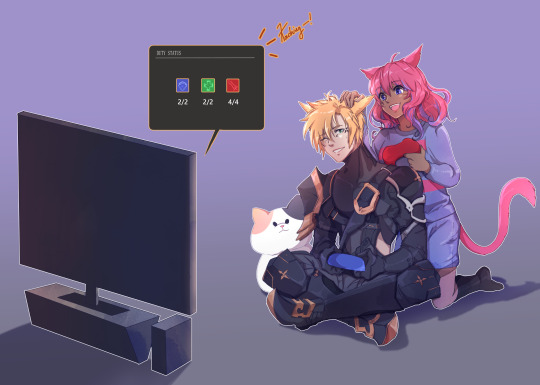
Hi, I felt like writing about my top 20 games of the decade because I kept thinking about it. This is a semi-ranked list, but I decided not to throw numbers into the mix since, really, outside of the top 2, I can’t think of how to rank the games prior to them. I also commissioned hyiroaerak (@/HRAK__S2 on twitter, https://hyiroaerak.weebly.com/work.html) for art to commemorate this occasion. Our characters are cosplaying as characters from our games of the decade!
Mega Man 10
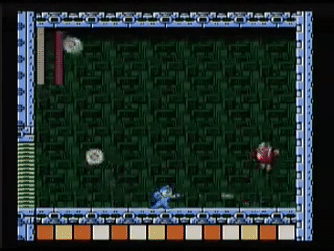
I actually like Mega Man 10 more than Mega Man 9 out of the two platformer revival games in this series. Though a bit of background on this: Mega Man 4 is my favourite, and I prefer the games that are not 2, 6, 7, or 11, so I suppose that contextualises this for others. Either way, despite it not having weapons that were as useful as Mega Man 9’s, I felt like 10’s level design and pacing worked more for me in my favour. Though I’m saying that as someone who liked the double fortress design in earlier games so that might invalidate how I feel.
Time Attack mode from Mega Man 9 returns as well as Proto Man (but he’s unlockable right off the bat). It also has a proper Challenge Mode compared to Mega Man 9’s challenges, whereby challenges for certain levels or bosses are unlocked when you actually do it in the main game. Being able to play as Proto Man off the bat allows for the fluidity Mega Man had in 3 and beyond by letting you slide and use charged shots. I personally liked being able to play as Proto Man off the bat as while he has the 3 and beyond advantages for his moveset, he is a glass cannon and you still have to watch where you’re going.
I feel like the levels were a little better designed and if I needed more of a challenge, Hard Mode was still there to cut my teeth on. I liked the colour schemes throughout the level maps a lot more than 9’s as well. The bosses felt particularly gripping and trading blows with them fit into a nice rhythm.
It has more content than Mega Man 9 and I had a lot more fun with 10 than I did with either 9 or 11. The formula itself is pretty static compared to other Mega Man games, but I like simple things. Why fix what isn’t broken? It’s just a nice piece of cake at the end of the day and that’s all I really want.
Trauma Team / HOSPITAL: 6人の医師

When I started university for the first time in 2006, I was pre-med. I eventually got sick and tired of the politics and people in the program (ie: folks saying they only wanted to go to med school so they can get rich or make friends with pharma reps who might give them perks), and I left the program to pursue program majors and a minor to prepare me for speech-language pathology instead.
We had a Wii in our student lounge. My main university campus wasn’t exactly big and a lot of the people who hung out in the student center were kind of cliquey. I think I had the benefit of being really good friends with one of the guys who was the biggest social butterflies at the school so I got to meet a lot of people or get involved with stuff if I felt like it. So that meant I got to play with other students in games or wi-fi sessions during classes or after classes if I didn’t have to commute home right away.
Because almost everyone I knew at my school wanted to go into medicine, everyone played the Trauma series. Some kids played Under the Knife during class. Some kids played Second Opinion on the Wii in the student lounge. Some kids played New Blood. This was before like… Farmville took over everyone’s computers at the time.
Trauma Team came out way after that, and some of us were either graduating or staying in school an extra year because we didn’t know what to do after the recession or knew what to do but needed extra courses for graduate school. So the Wii was free to use. I don’t think people hooked it up as often anymore anyway. By 2010, a lot of us who had met each other in first year decided to go our separate ways, not even in the same majors or programs anymore. A lot of us either branched out into research, psychology, neurology (like me), kinesiology, epidemiology, forensics, genetics, etc. So Trauma Team for the rest of us who were still there was a good fit.
Trauma Team took some influences from the 2009 Swine Flu pandemic considering that was when the development phase occurred. Now, I live in Canada, and Canada was one of the focal points for the 2003 SARS outbreak. This was when health bodies in the country decided to make some changes to how they respond to potential pandemics. A lot of things they tell medical students or any students studying health policy (like I was at the time) emphasized how different parts of the hospital or medical or health care staff need to work together in order to care for a patient. I actually find the different professions involved in Trauma Team useful and a reflection of what my class of 2010/2011 became later on (a lot of us graduated in 2011 and took an extra year).
Diagnostics and Forensics were what I was really interested in since they don’t play the same as surgery/emergency medicine since they played out like a point-and-click. Later on in life, I had to look at so many medical reports and radiology reports and file them but by then I realised what my patients had but I can’t tell them myself since I’m not a doctor. But Trauma Team gave me a chance to do so and practice my terminology as a student. A friend of mine, who ended up becoming a doctor at a hospital in Toronto, really enjoyed endoscopy since it merely involved using the Wiimote as an endoscope and the nunchuk to steer. A lot of us played co-op too.
The difficulty in Trauma Team, I felt, was decreased from previous games. But that doesn’t really spoil it. It was a varied game and it looks fantastic. It’s a shame that the game style hasn’t been replicated or given a sequel in later years, because while I’m older and my classmates are doing completely different things and I haven’t seen some of them in years, I’d love to take a stab at these types of games with a well-practiced laboratory technologist’s hand.
Sonic Colours

I think it goes without saying. My first community when I joined the old forum was the Sonic community. Just a bunch of people who were interested in talking about Sonic so much in almost every thread that we ended up making a community thread together. I don’t post in the new forum everyone is at but I still talk to mostly everyone via different social mediums.
I wasn’t around when Sonic Colours came out but I think I remember reading the joy everyone felt when nearly universally everyone in that thread seemed to really like Sonic Colours. I remember the thread title still. I preordered Sonic Colours because apparently previews were saying it was… good? I didn’t bother playing Sonic Unleashed until after I’d joined the forum, but hearing Sonic Colours would be a return to form since I was one of those people who didn’t adjust well to the 3D games made me interested.
Sonic Colours is everything I wanted from a 3D Sonic game. Or rather, a 3D version of a platformer. I didn’t really like where 3D platformers were going because they were hard to look at, hard for me to pay attention to, and to be honest I got dizzy while playing a lot of them since you’re expected to work in a 3D space as opposed to a 2D space so it was really hard for me to process. I really like the hybrid nature of the level designs that’s where Sonic Colours got me.
Sonic Colours isn’t without its hangups: some of the levels are really short; existing mostly for ranking/getting red rings. Sonic’s jump is pretty floaty. The script is fairly short even if the jokes can be funny. Bosses are reused. Sonic Colours is not a perfect game, but the attempts it made were fantastic enough in its own right.
The music continues to be great, but the areas are visual spectacles. Whatever you think of the series, it’s fairly undeniable that the games try to have style. From the lighting, to posing, to setpieces, to colours used in assets in the level design – Sonic has always had really great ideas. Sonic Colours is no exception – areas like Aquarium Park, Planet Wisp, and Sweet Mountain have a variety of neat level ideas and they look good trying to execute it. From popcorn on the floor to one of the best darned water levels in all of video games due to the drill wisp, to a fresh take on a grassy knoll with beautiful music, Sonic Colours can bring tears to your eyes because of what it attempts. Terminal Velocity Act 2 is also one of my favourite parts of the Uncolourations games partially because it’s a well-executed setpiece, but it also showed me that maybe those 3D racing bits aren’t that bad.
The bosses may be really easy, and the final boss ends far sooner than it should before it could perfectly execute its Kamen Rider reference, but I think the point was to fully enjoy the theme park that Sonic Team threw at you this time.
In 2020 I like to say that out of all of the Uncolourations games, Sonic Unleashed is my favourite due to the balance it struck and its presentation/artstyle, and basically having one of the best soundtracks of the previous decade. But I recognise everything that Sonic Colours brought to the table. If it wasn’t for Sonic Colours, I wouldn’t be friends or acquaintances with so many people that I am with now.
Kirby’s Epic Yarn

Have you ever played a game that made you feel warm and toasty? Canadian winters can be really cold, you know.
When I lived at my old run-down house, my old room didn’t have good insulation. Whenever it got cold, my room got really cold. I had my own personal heater because we didn’t really have a good heating system in my room either. So I only wore flannel pyjamas, wrapped myself in faux-wool blankets all the time, and went to sleep covered in at least four quilts or comforters (which is something I still do out of habit sorry). I used to make hot choco every day because it was just so cold in my room.
I love Kirby’s Epic Yarn. Kirby’s Epic Yarn makes me feel warm and toasty inside because I think of being wrapped up in yarn and sheets and scarves and I just feel so happy. There are so many pastels used in KEY’s earlier stages that I can’t help but to feel toasty and happy when I’m playing it. It’s not the most challenging game. The game is really easy and all you mostly do is collect furniture, music, beads, and parts of the results wheel in every level, but I don’t think that’s the point of it. The point is just to have fun. Watching Kirby turn into a car to sprint, watching him turn into a little parachute or transform during those vehicle bits, you just can’t help but to feel so enveloped by the cute.
Being able to interact with cloth by pulling a loose button and releasing something, taking off tags, pulling on stray thread, spin balls of yarn… it feels so fulfilling because it’s a clever use of the medium. It’s exactly what you’d do if you’re stitching or knitting. Placing furniture around Kirby’s little apartment makes the Animal Crossing fan in me so happy.
I appreciate the lengths Good-Feel went to producing the level designs. They took photos of the fabric they bought and created the graphics that way. The music is calm and relaxing, with lots of woodwind and piano and lighter sounding instruments. The entire game feels so soft and sweet. It’s a visually-impressive game since everything animates incredibly fluidly.
Cuphead

Like anyone my age or older, I grew up watching a lot of older cartoons by Max Fleischer with watercolour backgrounds, hand-drawn characters with a lot of focus on expressions, rotoscoping, etc Lots of slapstick and musical scores out of that decade. I would have never believed I’d play a video game that looks like that but here we are playing Cuphead this decade.
Cuphead is a blend of that artstyle with older run and gun style games. It combines a gunning experience with puzzles, reflexive actions, and dying… and dying a lot. And learning. Underneath it’s cartoony and child-friendly veneer lies a game that is unrelentingly difficult. There aren’t really any checkpoints in the game save for one. You can’t regain lost health. It’s just you versus the game. You may spend hours on one single level learning everything about it. And you can’t beat the game until you finish off every other level on regular difficulty.
Different levels have different forms: they can be run and guns á la Contra, which are actually, oddly enough, breathing room levels. They’re probably the “easiest” levels in the game. Other types of levels can be straight up shmup-like boss fights where you’re flying in a plane. They can be hard as a regular shmup.
The best crafted types of levels are the ones that include platforming as part of their boss battles because they use the artstyle and ideas involved in the art piece as interesting platforming mechanics. You have a more limited control scheme but the scenario you’re involved in is really interesting and unique. You fight a woman in a play and the setpieces in the play change according to how far you are in the boss fight, for example. The game also has a parry mechanic whereby you can double-jump off of anything that’s coloured pink and fill your super meter in order to kill bosses faster. The parry cues change per boss so it’s really cool to see what they look like every time you encounter something new.
I think while Cuphead can be utterly unforgiving, I think it should be experienced at least once for how much work was put into making things look so fluid and how creative every boss and level can be. It’s what I wanted the UBIart framework to eventually evolve into. I think the game’s aesthetics and sound are its own reward in addition to that feeling when you finally conquer That One Boss.
Asura’s Wrath

Asura’s Wrath was a game I was incredibly iffy on even buying at all. I heard about how the ending was part of paid DLC, that the game didn’t have a lot of gameplay, and that it was incredibly unremarkable. I don’t think I had a remarkably low bar or anything for this, but I decided to purchase it on the cheap.
Asura’s Wrath definitely isn’t a game for everyone, and I feel as though it’s an acquired taste. The main character’s art might not jive well with everyone, the lack of ‘play’ will probably deter some folks, and its episodic nature/final chapter unlock sequence would probably get on people’s nerves. With that said, at first, it seems to be an action-cinematic game without necessarily expanding on the “action” part. A lot of it at first seems to be a bunch of QTEs to move the narrative along, with the narrative not necessarily being that strong in the first place. I think that’s due in part to the game’s structure initially. The first few chapters and the first act truly don’t seem very remarkable. The Buddhist and Hindu aspects of the game are very obvious and very central to the game’s plot, but at the same time, they don’t seem to be specifically mentioned whenever someone talks about the game to me. The Asuras were not one singular character or a god, but a race of warlike beings exhibiting wrath and pride. They were incorporated into Hinduism and Buddhism through their mention in The Rigveda. With that said, I was continually impressed by how many references—whether it was mere mention of regular terms/concepts/people, the artstyle and inclusions of things like lacquer skin, mandorlas, Vajras and Pretas, and also Siddham script—was included in this game. Asura’s Wrath ended up feeling incredibly natural and a nice way of shedding some light on non-Judeo-Christian religions.
Anyway, I genuinely liked that the game felt like a playable anime. I don’t feel like the game would be as effective if it were put into another genre, or were less cinematic. It ends up getting its message across with its carefully-researched artstyle, great scene direction, well-composed music, and penchant for feeling like it was a fantastic shounen anime. I also feel like the game has more combo-based gameplay than people give it credit for. A lot of the complexities come to the forefront on Hard mode, and going for S-ranks and finding ways to do that quickly and effectively on higher difficulty modes is always an interesting affair.
Ghost Trick: Phantom Detective

I finished marathoning all of the Ace Attorney games in 2010. I don’t recall if I was doing it before Ghost Trick but I think what enticed me to get the game was its amazing animation. I hadn’t seen 2D sprites move that fluidly in a very long time. Characters have exaggerated movements, exaggerated dances (ie: the panic dance), and they have big flashy gestures to show off the game’s animation engine.
You’re introduced to all sorts of eccentric characters, many of whom don’t overstay their welcome (Circus case from AA2, I’m looking at you). You have a desk lamp, a doggo, a dancing detective, a little girl who’s the focal point for one episode, etc. Everyone’s dialogue is relatively snappy, their expressions and animations make them stand out from others, and due to how everything is presented right down to the character art portraits, everything just jumps off the screen.
Because you’re a spirit with amnesia, you’re given the ability to go through time, and also the ability to through environments by hopping from object to object and possessing them in order to influence what happens in the past to save people in the present. This is just a path to trying to figure out who you really are or to find who or what killed you. A lot of the gameplay revolves around trying to figure out which objects to manipulate and when in order to influence an outcome. It makes the game partially point and click, but also partially a physics puzzler. I don’t think I remember a single object in the puzzle segments that was wasted. In other circumstances, you must manipulate time in order to save someone in their last four minutes.
If anything, I feel like Ghost Trick is a necessary inclusion simply because of its style and attention to detail, as well as its sort but sweet story where nothing overstays its welcome. Its soundtrack also feels similar. The game is fairly consistent and nothing really changes in terms of progression over most of the game. But I see that as a plus as opposed to a minus for the most part. It helps to bring the game to a compelling and surprising conclusion.
Assassin’s Creed: Brotherhood
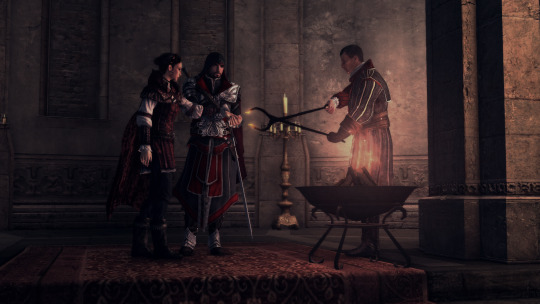
I marathoned all of the Assassin’s Creed games in one year prior to Assassin’s Creed III since I wanted to see what the deal was with the series because the first game wasn’t that great from a play perspective for me. The thing that resonates the most with respect to Assassin’s Creed for me is marshmallow-flavoured birthday cake and a bag of regular Bugles. I started this marathon on one of my birthdays that decade.
Assassin’s Creed II is one of my favourite games out there, but Brotherhood adds so much to the formula despite its middling storyline compared to its predecessor. But that’s because most of Ezio’s growth happened in the previous game. He is a middle-aged man searching for the Apple of Eden, and while the story does not carry as much emotional impact, that isn’t exactly what I’m looking for with respect to the earlier AC games.
One of the things I absolutely love about the earlier AC games is its attention to detail even if it isn’t necessarily completely accurate. At first I missed the fact that I could explore many different towns like I could in AC2. But then I realised how big Rome and its surrounding area is. Rome is gigantic, and it has so much attention to detail with historical buildings everywhere (which you need to pay to rebuild), old tapestries from the era, citizens dancing in the streets, lovers flirting with each other behind pillars, etc. There are more roofs and buildings to parkour over and between. The game adds towards that require you to take over them before you can use them to gain access to vendors and things to renovate. You can also find the glyphs (much like the ones from the previous game) to solve puzzles in order to gain access to more lore.
I genuinely love the renovation aspect of this game. It’s more involved and a lot better than what the previous game tried to do with its economy. You renovate in order to gain access to shops, which in-turn generates income for you, and then you can renovate other stuff based on the income that you generate. It’s something that I’ve come to miss in later AC games. It felt a lot like a Suikoden game in some aspects.
Platforming missions return in the form of finding parts of a cult and cutting the beginnings of a conspiracy off by its limbs. They’re faster paced than AC2’s tombs and there is more variety in terms of what you platform through. I like both types equally since one allows you to marvel at the beauty of a cathedral, while the other allows you to clock a few folks while making your way through a lair.
In addition to the lairs, there are different types of missions for each faction that you forge alliances with, there are Da Vinci missions that involve new war toys and blowing things up in a scripted way. Assassin missions can vary in terms of how you carry out the assassins (albeit still scripted; improvisation was not a thing until ACUnity).
The crux of AC: Brotherhood is being able to recruit assassins to your cause. Random citizens throughout Rome may be under attack by Borgia soldiers, and once you save them, they are recruited to join your cause. You level them up, send them out on missions, improve their gear, and ask for their help when you can and when they’re available. This feature gets expanded upon in later AC games but it gets a very good start here.
Brotherhood is so full of content and a lot of little things that playing it for me makes it feel like comfort food for me. It may not have the best story and it certainly isn’t as memorable in that sense as its predecessor. But it’s so fun that I can’t help but to feel satisfied every time I turn it on.
Pac-Man Championship Edition DX

I played the original Pac-Man CE on 360 years ago at my cousin’s house, where they added a timer and a morphing maze to the base original game. I thought it was a neat novel thing at the time but didn’t think further.
Pac-Man CE DX adds more mazes and more mechanics and more modes to the championship edition base. It added sleeping ghosts where, if Pac-Man moves near them, they wake up and they chase him around the maze in a line until you can finally eat them all and rack up a huge score. You can also elect to use a bomb at a small expense in order to save yourself and send ghosts to the middle of the maze again. These changes assist in maintaining the game’s flow and it never makes a score attack daunting or boring.
Devouring big long conga lines of ghosts following you is so satisfying while you’re listening to a bumpin’ soundtrack and chilling out looking at the cool lights on the maze. Really and truly, while at its core, PMCEDX is a score attack game, it makes for a beautiful loving chill sensory experience and I couldn’t ask anything more from it.
Deadly Premonition / レッドシーズプロファイル

I think I, like a lot of people, was introduced to this game via the GB series. I didn’t have an Xbox 360 so I eventually imported the Japanese version for the PS3. The game’s dub was already in English; the text was in Japanese and it was pretty easy and reasonable to get through. Deadly Premonition actually the Guinness World Record winner for most critically polarizing horror video game since the reviews at the time were so all over the place. And yes, I will contend that Deadly Premonition is definitely not for everyone.
I am not the type of person to play shooters. I actually hate them a lot. I don’t like gushing blood in video games, and I don’t really like the act of murdering someone in a game. I used to play a lot of survival horror games when I was younger on the PS1 and PS2, but a lot of the time you’re dealing with the undead or oddball things going on around you so it’s not nearly as bad I think. It’s funny; I deal with people’s bodily fluids and body parts all the time in real life as part of my job (ie: I’ve had to help dissect someone’s stomach before fresh out of the operating room), and it doesn’t bother me. But the mere act of seeing it done or doing it, makes me feel squeamish. I don’t like it. I don’t even like watching blood being drawn from me or needles being stuck into me, even though I’ve done it to other people as part of my work.
For the most part, inexplicably, in Deadly Premonition, you’re dealing with the undead anyhow. I’m not the best person at shooters, but I certainly know what’s a good one and what isn’t. Deadly Premonition is not a very good shooter. It’s really janky. Some of the weapons don’t make sense in terms of how balanced they are. The controls are also really janky. This is not really a surprise considering the game’s strength wasn’t supposed to be its shooter aspects. In fact, those parts weren’t even supposed to be there.
Deadly Premonition is often cited as an artistic piece or a good game simply because of its story and character writing. It has an excellent main character who was cast almost perfectly. It has a lot of eccentric characters filling the town of Greenvale to help you solve the murder mystery or help obstruct it. The end result of having an unreliable narrator works out in the game’s favour. It helped sprout pop culture references, weird humour, quirky dialogue and more. I have certainly never watched Twin Peaks but I got the allusions either way since the show was so big. Slowly uncovering how every cast member lives their lives throughout the town and every day makes you more emotionally connected with them.
Greenvale is more of a sandbox than just a place where a crime is committed. You can play darts. You can race cars. You can do a ton of sidequests somewhere that will reward you elsewhere. You can collect trading cards??? You can carry some lady holding a pot everywhere? You can taste-test for one of your coworkers? You can do a lot of stuff that makes zero sense but I still end up enjoying it all anyway.
It looks like a PS2 or Dreamcast game or something and I almost found that utterly endearing in the era in which it was released. The soundtrack itself is so dissonant and doesn’t always fit the situation. Sometimes the sound mixing is so all over the place that it often results in making a scene more hilarious than it should be. There’s a song that’s just… American Idiot… on the soundtrack for some reason. Along the way, you start wondering “is this game real? Am I real? Is this really happening right now?” and yes, yes it is.
In the end, because of its cult success and getting people talking, it allowed Swery 65 to make more games. Deadly Premonition was lightning in a bottle for him. He followed up with D4: Dark Dreams Don’t Die (unfortunately in limbo). He cowrote Lord of Arcana and Lord of Apocalypse. He recently released The Missing. If anything, I’m more interested in what he makes. I’m eagerly looking forward to The Good Life.
999: Nine Hours, Nine Persons, Nine Doors

Text/Puzzle-adventures, rather than pure visual novels, became a staple of some players’ libraries due in part of the popular Ace Attorney series, Professor Layton series, and whatever Mystery Case File games that were published by Nintendo. 999 is not a pure visual novel. It’s a puzzle adventure game with visual novel elements. With art by Kinu Nishimura and a story written by Kotaro Uchikoshi (who had a few visual novels under his belt), it was difficult for me to ignore this game. I was also at a point where I really wanted to get into a lot of the games that Aksys published so it was a natural choice to buy.
A lot of the localization and language in this game was edited so that while it stays true to the spirit of the original language, a lot of care was put into making the dialogue and writing sound natural in the English language versus going line by line exactly. It worked out in the game’s favour because the script was fairly large. Based on Uchikoshi’s past games, he likes to ask a question and generally incorporate some pseudoscience in his narratives. 999’s version of pseudoscience ended up being morphogenetic fields (see: Rupert Sheldrake). This theory ended up the basis for a few characters and it is the way the story unravels. He also took inspiration from another older game of Chunsoft’s: Banshee’s Last Cry where the player is put into an unsettling position right off the bat. Indeed, 999 starts the player in media res, but the player is already in trouble when you begin to control the main character.
The puzzles were added to the game so that it would be received well by a wider audience than just visual novel readers. They were naturally and seamlessly integrated into the experience that the game became almost wholly about the puzzle rooms and whatever flavour dialogue occurred during the puzzle rooms. A lot of inspiration seems to have been taken from browser-based escape games like the Crimson Room from 2004. Escape the Room games were a subgenre of point and click adventure games and it was nice seeing the concept integrated in a narrative experience that wasn’t Myst (see: http://www.fasco-cs.net/ for more information). Due to the puzzles being a fundamental part of the game’s story, with them getting more and more difficult, the final puzzle for the entire game at the end of the true route is both a relief and also incredibly impactful due to using both of the DS screens and also revealing a lot to the player about the narrative.
If I had criticism for the game, I feel like it would be having to play the game repeatedly, doing the same puzzles repeatedly in order to unlock another prerequisite ending for the true ending. I did not play the later port which rectifies this but I’m not entirely sure that being able to see the branches would be great for the game either. I also feel like, just like a lot of Uchikoshi’s writing and previous games, that when the characters start cracking jokes when they have to urgently do things to not die, the tone feels a little off.
With that said, 999 is one of the more compelling text/puzzle-adventures from last decade, and it uses its native platform to its advantage. There weren’t a lot of games that used the DS screens to convey a narrative properly but when you are faced with the revelation that the game was using the two screens for a remarkable reason, you feel like the game is a natural and powerful addition to any DS library and gives significance for the dual screens.
Metal Gear Rising: Revengeance

The funniest thing about Metal Gear Rising was that I actually disliked it at the beginning when I first started playing it. I didn’t know what I was doing half the time, and I didn’t ‘get’ the parry mechanic. At first, I guess I was playing it for the sake of playing it? It definitely took me a while to even warm up to it. The camera was obnoxious (and still gets to be obnoxious in some places), and I felt incredibly nauseous while playing it sometimes.
It wasn’t until I got to the Mistral boss that I finally … found what I was looking for… I’m sorry. I’m serious, though. Metal Gear Rising truly shines during the boss battles. When I finished that particular boss battle, I’d reflected that I was smiling like an idiot the entire way through. I don’t think I’d fought satisfying boss battles in years prior to that. Returning to previous chapters told me that Platinum really likes to frame and teach players via trial by fire. Learn to parry yourself, here’s a test to see if you can parry well and you can get a trophy for it, here’s the final test to see if you can even parry (Monsoon). I loved that Metal Gear Rising threw a lot of what we knew about Metal Gear Solid out of the window, with a significantly interesting score, boss battles that centre around the climax of a battle (expertly done via excellent sound design as I noted in my SotY writeup this year), and a more interesting and personable version of Raiden. It relies far more on offense than defense and stealth, and that’s okay to me. It ends up separating Raiden even more from Snake.
The final boss is a love-it-or-hate-it sort of affair, and I ended up loving every single part of it. I felt like it was one of the best final bosses in years. Don’t know how to parry? You’re fucked. Don’t know how to use the game’s other offensive rush tactics like Defensive Offense and running? Good luck. The game makes sure you try to know how to do these things before even bothering to attempt the boss, with the major roadblock being Monsoon. And if you can’t parry by then, the game brutally tells you that you aren’t doing it right by making the boss battles ramp up to significantly require you to use one of the game’s core mechanics for elegant combat. This isn’t the most elegantly-designed game whatsoever. In fact, it can be really sloppy. With that said, it’s one of the better action games I played all decade.
Papers, Please!
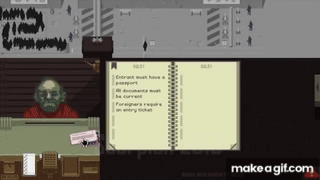
Papers, Please is work. It feels like work because it is work. You can grant freedom and admittance to people, or you can just take their freedom away or not permit them to cross the border. Everything you do is controlled by the government, or by rules and regulations. If you do something wrong, you’re written up. Do enough wrong, and your pay is cut. Do enough wrong and your pay is cut multiple times, and you can’t provide enough for your family. Everything about the game just feels like work. Even right down to the end of the day when the whole thing feels like a budget calculation and spreadsheets. Everything about the game’s UI feels a lot like work. Where do you allocate space to do your job? How much money do you allocate to heat/food/medicine? It ends up feeling very tedious, but somehow fulfilling.
You are an immigration officer in a fictional Soviet state. The interesting part of the game is that it doesn’t only feel like a job, but it also feels like government and self-evaluation. You end up studying why the government keeps regulating the border the way they do, and thinking about how mundane the job can be. You know that people’s livelihood and family lives hinge on whether or not they cross the border, and sometimes your penchant for following the rules and disallowing people across the border may be called into question when people plead with you to go through. Do you accept docked pay so you can reunite people or save people from slavery, or do you do as you’re told and live with the consequences of your actions. In a small way, your ethics are called into question. It’s a nice reminder that a lot of things, despite people being people and having their own stories, generally seem to come down to bureaucracy and pieces of paper as opposed to a full understanding of humanity or extenuating circumstances.
I’d also like to add that Jorji is one of the best characters of 2013 to me. I think his glass half-full philosophy / if at first you don’t succeed, try, try again philosophy is something to look forward to whenever I encounter him in-game.
In many ways, Papers, Please feels a lot like the Milgram experiment. Are you going to make cruel judgement calls to separate a family, or keep people in slavery because the authorities and higher-ups essentially tell you to do your job so you can keep your family healthy? Papers, Please in many ways is written incredibly well. It doesn’t use reams of text to make you understand the overall premise of the game but through your actions, you’re also helping to tell the story. That’s the sort of weird and wonky player “agency” that I find interesting.
World of Final Fantasy

The Final Fantasy series had a better decade than the last decade, I feel, considering the quantity of releases increase from the previous decade. However, it had a lot of growing pains to deal with at the beginning of the decade. Final Fantasy games sell well all the time, and more people playing games than ever, it makes sense that sales numbers continuously increase. Attach rates aren’t as large. Final Fantasy XIV came out in 2010 and it was not a good game at all to the point of having to be structured for its 2013 re-release. Final Fantasy XIII had mixed reviews, as well as its subsequent direct sequels. Final Fantasy All the Bravest wasn’t exactly the best mobile debut for the series. The brand also suffered from dilution – the Final Fantasy name was attached to almost anything and everything for the sake of sales, and numerous spinoffs were released and the quality varied.
Final Fantasy Versus XIII and Final Fantasy Agito XIII, originally planned to be part of the Fabula Nova Crystallis setting with Final Fantasy XIII were renamed and rebranded/redesigned to be their own titles: Final Fantasy XV and Final Fantasy Type-0. Both games also had mixed reviews and multiple delays. If anything, I can probably say that this decade was the most divisive for Final Fantasy fans.
World of Final Fantasy came out during the same year Final Fantasy XV. I think I’ve made my feelings about Final Fantasy XV fairly well-known. Perhaps my feelings about that game influenced how I felt about World of Final Fantasy but as someone who has played this series for decades (for reference: the first game is one year older than I am, and my first Final Fantasy was the first game), I felt like World of Final Fantasy was a love letter written to fans like me. I am a long-standing fan of the series over the course of decades and have been through its up and downs, and while I don’t like every game in the series (we all know how I feel about half of the games in the series, after all), I can still look at them for their influence on the rest of the series. I also like the newer games equally as the older games and dislike and like games from all of the eras, so I don’t really have issues with how the series is represented in general unless the games are really bad.
World of Final Fantasy feels like a Kingdom Hearts-esque exploration of the Final Fantasy games while throwing Pokemon into the mix. It involves a lot of older references as well as bringing new references in and throwing it into a presentation mode that fans of all ages can enjoy. The main characters are chibi which fits right into how the older games represented characters, but they can also grow taller to represent how the newer games are represented. You can create stacks of party members according to their height and balance well accordingly out of classic Final Fantasy enemies and characters in order to battle against other classic Final Fantasy characters, villains, and monsters.
The game is exactly what I wanted a mainline Final Fantasy to look. It retains a cartoony look, embracing stylization while adding so much detail to the areas’ setpieces so that they also stand out while the characters move around on the map. I also felt like the score was also a brilliant blend of old and new: with Masashi Hamauzu composing the score but also remixing older Uematsu themes to fit within the context of the score. The score was loftier compared to Hamauzu’s older works and the strings, synth, and piano works incredibly well to bring the game’s world to life.
The idea for WoFF was to try to bring younger fans into the fold, hence the Pokemon-like influence for using and rearing many classic FF enemies so that children could start to recognise them. The loftier script was also written in-mind taking into account both lighter storytelling from older FF titles and some darker bits taking into account newer Final Fantasy games. I’m not too sure that SE was very successful with bringing younger fans into the fold, but the way the game was written fit well with what I remember liking about FF for the first few games I had played. I also enjoyed that characters were chosen for their involvement to the plot versus them simply picking the most popular ones. This is why we got characters like Eiko and Shelke as well as regular FF mainstays. All of the characters were woven into the story well, as citizens of Grymoire as opposed to characters who just have their regular identities transported into Grymoire instead.
I felt like the Pokemon mechanic was handled well. I even loved it enough to have the idea commissioned in combination with our FFXIV characters. I liked that it changed up whatever skills you had access to, it influenced your stats, and it looked adorable to boot.
I would absolutely love to see a mainline game made by this team because I felt like the loose style of storytelling and worldbuilding made for a very good Final Fantasy game, and in essence, WoFF was the real Final Fantasy XV to me. It felt more “Final Fantasy” than a lot of the games released in the same decade, or even compared to ones released in the previous decade. It was a nice step and touch to demonstrating that there were staff members who remembered what Final Fantasy is to older fans.
Va-11 Hall-A

I’m too young to have a big attachment to older PC games like the ones on the MSX or the PC-88/98. But I’ve always had a fondness for their graphics and their music, like sometimes I feel like I was born in the wrong time or something. It’s one of the reasons why I gravitated hard to the PC Engine—I felt like it was a way for me to finally experience stuff like that.
Valhalla is supposed to be a bartending simulator but in reality, mixing drinks is a bit of a break and distraction between the visual novel bits. Usually if you’re stuck in a futuristic landscape akin to Bubblegum Crisis or Blade Runner, you’re asked to investigate a mystery or explore it. But nope, you’re a bartender making drinks and making enough to scrape by and pay your rent. You hear a lot about the world from various clientele while you serve them drinks but you don’t necessarily have to do anything with the information they give you.
I worked as a medical administrator for a few years and over that time, I got to hear a lot of stories, meet some famous people (like been on TV people or youtubers or people who got paid to do things for celebrities), and just meet a lot of neat and interesting regular people. I got to hear stories about people’s health or their personal lives or witness people falling in or out of love. You don’t necessarily have to do anything with that information (in fact you can’t due to patient confidentiality), but the stories become sealed in your head. I can’t help but to think of some of these people I met for those few years or where they are now. I actually run into some of them at my current lab so I keep getting to see some of their stories. You eventually learn how quickly icebreak in situations like these to make people feel at ease or find a topic of conversation while they’re waiting. I even used my phone to gauge news because a lot of the time when I got home, I was too tired to do anything or getting news in the palm of my hand was incredibly easy to do.
In this sense, I understood Valhalla. It may look dull and it doesn’t look special but you’re the one who makes it so that it doesn’t have a dull moment in the bar. You’re the one who has to make it enjoyable even if your pay sucks. Because you don’t want to be miserable either. It’s through the conversations with others that you learn about Jill because she has to add commentary too. Everyone has a different way of requesting something and it’s up to you to figure out how to decipher it. It’s a lot of like practice in being in the service industry. You need to consistently gauge a conversation in order to actually give the client what they want to unlock more conversation.
The pacing in this game may be a little slow, but it doesn’t feel like a hindrance because the writing is really good. Something always happens to keep you interested or you have to mix drinks to keep yourself on your toes. The humour comes across well, and nothing really falls flat. Part of the reason why I feel like the writing is genuine is because the game’s developers wanted to write something that reflected how they live in Venezuela, akin to laughter in the middle of despair according to the developers. The writing is balanced well with the music and the visuals which makes the whole package a wonderful experience.
This game also has Rad Shiba so it belongs on the list by default.
El Shaddai: Ascension of the Metatron

I had gone to Catholic Schools all my life. I was even in a nursery school operated by nuns when I was a toddler, and they always tried to get me to write with my right hand instead of my left (which left me ambidextrous for some things lol). Because of my experiences with religion growing up, I absolutely had questions and doubts and concerns with metaphysics, theology, and epistemology. Every Catholic, I think, as they grow up and have to take religion classes, and having to take what the province mandates as metaphysics are somehow inserted into math and biology syllabi without even being mentioned in the coursework at all, questions it. And that’s okay. You should. The best religion and philosophy teacher I ever had growing up always said we should question everything we learn including what he taught us.
Going through school, though, and reading the Bible and having Bible study, my friends and I always sorta wondered what it’d be like if a game was made about this stuff? I know it may be a little sacrilegious but there are so many stories in there that would fit a game. Throughout my life, as I became acquainted with others from different branches of Christianity or other western religions, I talked with others who played games who… surprisingly had the same ideas and desires? It probably won’t ever be done. El Shaddai is inspired by the Book of Enoch and while it is considered as non-canon in most Christian and Jewish sects, I guess it might come close to what some of us wanted.
El Shaddai was a game that I picked up mostly because I bought almost every niche game back then. I just looked at some of the trailers, thought it looked just okay, and picked it up because I felt like Ignition was going out of business and it would be a novelty item. Ignition did not have the best reputation among the people I talked to back then. I played Lux-Pain whose localization left a lot to be desired. Nostalgia was a middling RPG. Arc Rise Fantasia’s localization left a lot to be desired despite being a good game. Deadly Premonition had an English dub already but the text localization wasn’t that great. I felt like El Shaddai was the most polished game that Ignition released. They got incredibly great voice actors, including Jason Isaacs. They developed a score attack combo ranking system for replayability. They had a fantastic art director and background art. They made two bishounen that screamed for female audiences to pay attention.
All of it didn’t exactly work out for the time the game came out, and I always contended that the game was released before its time. Unfortunately, all the effort put into El Shaddai didn’t exactly save Ignition. I feel like if El Shaddai were released in the later half of the decade, it would have been accepted. However, I also feel like its marketing was mishandled. It doesn’t feel like a Devil May Cry successor. It shifts between genres continuously. It is very much like Nier in this regard: it is not for everyone and it has its own unique feel that sets it apart from other games. It is also a score attack action game, not a hard character action game.
One thing I really enjoyed about El Shaddai was that all of the setpieces aren’t exactly the same. It ranges from a watercolour painting to abstraction to 2D children art to more abstraction to Final Fantasy VII and keep going like that. It references rhythm games, 2D Platformers, racing games, action games, Devil May Cry (with its own brand of Devil Trigger to boot), and other genres to create something that syncs up very well with the rest of the game due to lore reasons: different enemies prefer different things so that’s why each environment looks different or the gameplay styles may be a little different. I’m okay with this because it shakes things up per chapter and the game doesn’t feel stale at all. You’re expected to adjust to new mechanics per area.
The combat is a lot like Rock-Paper-Scissors, where certain weapons beat other weapons, or some bosses change which weapons they’re weak against (and the game gives you other weapons so you can adjust accordingly during fights). The weapon you wield also modify your platforming abilities (ex: one allows Enoch to dash, one weighs him down, etc), and they also vary in terms of character strength. In order to obtain G-rankings for each stage, the player needs to analyse which weapon would be the most useful for certain enemies and combo while guarding, guard-breaking, and stealing enemies’ weapons.
I am putting El Shaddai on this list because I really enjoyed it for what it was. It’s a brilliant score attack action game with a fantastic soundtrack and fantastic art design. It made for a pleasant sensory experience and made some religious figures fairly compelling with good character designs. It’s definitely one of the most rewarding and prettiest score attack games I’ve played this decade.
To the Moon
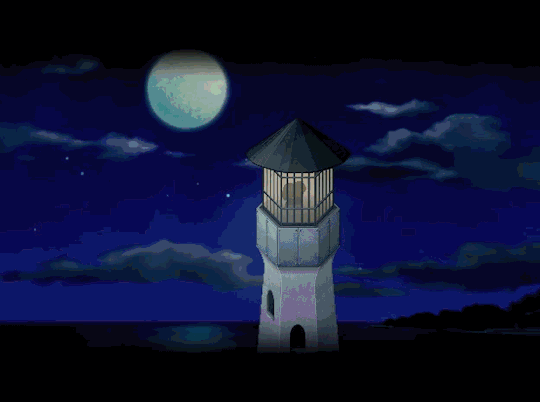
Everyone goes through life with regrets. I’m in my thirties now and I think I’ve done things I’ve regretted, or I didn’t other to do something and I’ve regretted that. Kan Gao was inspired by his grandfather’s illness when he was writing and making To the Moon, he’s noted that when he gets old and when his time would come, he might end up regretting some decision he’d made throughout his entire life. Everyone goes through that when faced with introspection. You can have the courage to love, you can feel pain, you can live your life fully, or not live it enough. To the Moon explores this, and while the writing isn’t the best and can be a little messy (this gets improved on in Gao’s later sequels to this game: A Bird Story and Finding Paradise), I understand what To the Moon was trying to accomplish. To the Moon is an exploration of everything that life throws at us, and the results of the decisions made throughout our lives that touches everyone and everything around us until our time passes.
Eventually you build up so many wishes and have a big bucket list but eventually there will come a time where you won’t remember why half of those things are on those lists. To the Moon relates the story of Johnny Wyles, an elderly man on his deathbed with one wish: to go to the moon. The problem is that he could not remember why. The general flow of Gao’s games have involved two scientists from Sigmund Corp, specialising in wish fulfillment at the end of someone’s life, creating memories for people in their final moments to generate comfort for the patient. How ever you may feel about the moral implications of generating false memories for someone prior to their end of life, this is merely a set up for traveling through time to understand what the patient had wanted and what they’d accomplished.
Johnny’s character revolves around another character with an ASD. I will also note that my brother has autism (compounded with a multisystem syndrome). While the central focus was on Asperger’s Syndrome (Tony Attwood books being mentioned in the game), I’m a little happy that ASDs are being brought up in games and the game truly hit home for me. The writing may not be stellar, but I felt that the theme of the impact of medical disorders was communicated well. Particularly the theme of why communication and connections with others is so difficult for those with ASDs and those who take care of those who have ASDs. It’s easy to sympathize with the characters trying to express what they mean to each other.
The game itself is relatively short. Regardless of its length, players must confront some uncomfortable situations and emotions that people struggle with daily or even at different points in our lives. I’m older now and I appreciate this game a little more since I’ve come to experience more of what the game had been trying to tell me a decade ago. The writing may not be the best, and it can be a little messy at times with respect to how it’s presented and written, but a lot of its messages come across as utterly genuine. Slowly unraveling the reasoning behind Johnny’s desire to go to the moon is beautiful. This game is quite human and I appreciate all three games that are a part of this subseries that came out this decade. I am looking forward to more.
Nier Gestalt
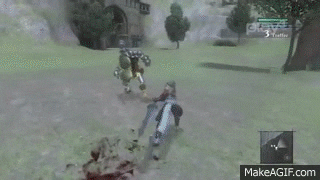
If you’ve played a Drakengard game or the first Nier game at all, you kind of know what you’re getting into. Not the best graphics of the decade, plays pretty janky, having bosses that can be difficult to manage, etc. So going into Nier Gestalt in 2010, I knew what I was getting into. Not a lot of people bothered playing this game since I don’t think it got as much promotion considering it came out during the same year a mainline Final Fantasy game got localized. Nier also got a little scrutiny since the west got a different protagonist from the Japanese version. I will say that this worked out in its favour, since the protagonist being one of the central character’s father versus her brother makes for a better, more interesting story than having yet another shounen protagonist.
I will support the case that, like the Drakengard games before it, Nier Gestalt was difficult to get into. The gameplay is jank. Easy is too easy. Normal doesn’t drop enough stuff to warrant playing on the mode. Hard can be a little hard but eventually it evens out. I generally used spears for the charge portion of the combo but in the end it doesn’t necessarily matter what weapon type you use. It doesn’t even matter if you use magic or not unless the game prompts you to do so. It’s either broken or not and the game doesn’t have a set balance for anything. Combos are boring and you’re essentially mashing a button. Even playing through the Nightmare DLC for extra drops, it continues being like this. I was used to playing shmups so it wasn’t necessarily revolutionary that AoE attacks looked as though they were spat out from a shmup either.
I wasn’t quite understanding why game started acquiring a cult following, because what I’d played of it was pretty boring and standard. “It’s just a regular ARPG starring an older character versus a young protagonist,” I said to myself. I guess that was the reason. I didn’t quite understand why, even past acquiring Kaine, because I guess I accepted that there weren’t a lot of NPCs and certain towns were the way they were due to, what I surmised were, RPG conventions. It wasn’t until I finished the questline for the brothers, where their mother tried to run away with a man and abandon her children, that I finally started to understand.
Within every substory, there was something that resonated with someone. I couldn’t fathom why someone would want to abandon their responsibilities, and at the same time I understood. Sometimes you just want to take care of yourself. With the way the older brother sort of understood why even through his anger and disappointment, it resonated with me. I finally ‘got’ the story, so I wanted to play more. This became one of those rare games where I played only for the story and lore and abandoned any hopes of the gameplay getting better. I fished, I upgraded weapons, I did enough sidequests for the trophies. I almost platinumed this game, but since the drop rates are so terrible for this game, I didn’t.
I started enjoying the game for what it was. It was genuinely a fun romp where it feels like everyone taking part in the game’s design contributed something unique and something they were fond of. If you read any interview from Emi Evans from this time period, you’d realise language is something she’s particularly fond of, so much of the composition and lyrical content of every song was a phoneme from any language that would make it sound like an evolved or a sort of Esperanto version of a current language. This came into play with the game’s lore, and many of the interviews were interesting to read from back then.
Many of the game’s stages borrowed from different genres of video games. There were the obvious shmup references, the rail shooter reference, the visual novel reference, the Resident Evil/fixed angle horror game reference, the Shadow of the Colossus references, the 2D platformer references, the Zelda references, the top-down puzzle game references, etc. For what the game lacked with respect to its combat, the game excelled at reliving genres and putting maps together in such a way that it felt like an ode to other games and genres that inspired it. The City of Façade’s language being a loose phoneme reconstruction of Japanese felt right at home with the dungeon’s Zelda references complete with Zelda fanfare for me. The Forest of Myth being one long visual novel was so hilarious and unique at the same time.
Playing more of the game and opening up the lore with every playthrough was neat. I don’t particularly like when games waste my time, but Nier made each new playthrough worth it. Killing bosses quickly for a trophy, redoing dungeons to see the enemies’ perspectives, and unlocking more of the story and learning more about the world that came from a Drakengard ending felt satisfying. As someone who was studying linguistics at the time, constructing nonsense words from drops out of different morphemes to act as accessories or armour was really amazing for me.
Much of Nier felt organically put together, from characters’ writing and what they wanted from each other, to the dungeon design, to maybe even the combat design… it felt like a truly special game made from the heart with as much lore as it could possibly include. I had purchased the Nightmare DLC primarily to get weapon drops and while it isn’t nearly as interesting as the rest of the game, it has some implications for the lore. The music and resulting soundscape lends so much to the worldbuilding and includes many peoples’ languages from the area with French, Japanese, English, German, etc phonemes thrown around to sound utterly organic and special.
At the end of this, I have come to realise that despite saying to myself that I never played this game for the game… I’ve been lying to myself this entire time. I actually did play the game for its game parts. Those are the bits I remember the most about it, and they’re the reasons why I genuinely loved the game. It’s unforgettable for me and it’s why it’s one of my favourites in general.
Final Fantasy XIV: Heavensward
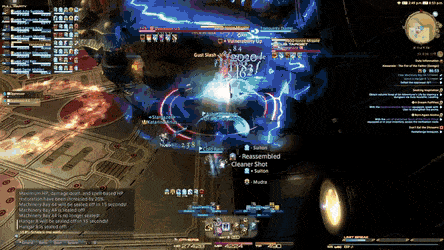
I did not care about MMOs in my late 20s because I was far more focused on finishing school and actually working hard in my field. I think by the end of university, I barely played games because I literally didn’t have time for them. I probably stressed myself out a lot. I threw myself into a semester where I had what felt like 500 evaluations, had to study a lot, had to write papers, and I ended up breaking up with my ex-boyfriend amicably. I was on my own a lot and to be honest, I think I felt okay that way. I think maybe others thought I was unapproachable.
My best friend now turned fiancé had been begging me to start playing Final Fantasy XIV for a really long time, since he was in the beta prior to its 2.0 release. I made excuses and said I won’t play until a speedster class was implemented since nothing really stuck out at me. In reality, I was mostly busy. Well, Ninja got implemented late 2014, so I ran out of excuses. I got a copy of ARR but to be honest, I didn’t have time for it and I didn’t play it much so I didn’t bother to try harder since my focus was elsewhere.
Luckily, I got into a semester where I didn’t have that much coursework to think about so I ended up playing XIV more. I caught up during ARR and really my intention was to only play through ARR and finish the story and quit. But my fiancé’s friends were so nice and welcoming to me. When the servers shut down for Heavensward maintainance and I’d finished the ARR storyline literally that night, I made the conscious decision to buy Heavensward. By that time, I was falling a little too hard for my best friend and I really liked my newfound friends. I wasn’t ready to leave Eorzea yet.
Of course, I had some quests to finish up during Early Access so I didn’t get the opportunity to play with anyone I knew during the main storyline for Heavensward. Heavensward was leaps and bounds above anything I experienced in ARR. The story was well-written, the English voices were recast and given better direction, character deaths were meaningful, a smaller cast made for good character building, the environments were large and you could only assume things happened in each area eventually (they didn’t in the long run), each area was different, it reminded me of Canada… Heavensward made me feel at home.
Almost every job felt built on, since nothing was really truly culled. A lot of what you got felt like an extension of what you already did. The three new jobs didn’t start out too well or too balanced. Machinist was a mess. Astrologian felt weird. Dark Knight had some growing pains but probably performed the best out of the three once the Alexander raid was implemented given that its specialty at the time centered on magic defense. I was one of the five people who really liked bowmage since it required you to think before you cast but you still did a lot of damage if you thought before firing. I swapped to an omnihealer main officially halfway through the patches because my fiancé requested it.
Heavensward had a lot of growing pains. For all the team did for the base game, they took a six-month vacation to recharge. 3.1 wasn’t really worth the wait and a lot of people quit the game or stopped playing because nothing really meaningful was added to the game other than a faceroll raid, poorly-tuned exploration missions, and two dungeons. Gordias earlier in the expansion nearly killed the raiding community as a whole. 3.2 didn’t fare too much better, though it did add the best raid tier that has yet to be topped. 3.3 was when FFXIV solidified itself as an MMO with a grand story to tell, with one of the best conclusions a Final Fantasy game had seen in almost a decade. The sound design was near-perfect for this patch, and it was when a lot of us genuinely felt comfortable with the game and its future. Heavensward wasn’t perfect; it still had its missteps and balancing issues, but it was the most comfortable and profoundly skilled I’d ever felt with the game.
Final Fantasy XIV may not be what it used to be. I feel old and I feel like I’ve played the game for a really long time. Now while it’s riding the wave of success, currently having the best story Final Fantasy has seen in a very long time, I can’t help but to remember Heavensward when we finally felt assured about the game and it felt like a cohesive gift to players who were active at that time. I got to know so many people during Heavensward, and now I’m engaged to my best friend partially due to our experiences together playing at that time.
Undertale

The late half of 2015 was a really bad year for me. The first half was really great. I started playing FFXIV often, I finished the hardest year I’ve ever had of my 9 years of university so far with high grades and was going full-on hard into my residency year, I fell in love with my best friend. I was pretty happy since I finally felt very successful.
If anyone can recall (or this may be new to the person who is reading this), towards the end of 2015 my dad was falsely accused by our neighbour of possession of a weapon (it was a gardening tool), and he had a restraining order put against him so he couldn’t live with us anymore. My little brother is severely disabled so that’s why I still lived at home so I could help out. Without my dad around, it was so much harder. I came home from my days at the hospital every day after a 12-hour day, had to babysit my brother since my mom still cooked food to carry for my dad who had to live at my aunt’s, somehow had to find time to study for my licensing exam and do some work for school and my thesis, had to find time to socialise a tiny bit otherwise I’d go crazy, maybe had to take my brother to his appointments by coming home a little early, and then had to find whatever time I had left to sleep. I stopped posting on message boards because I literally had no time to do so and I wouldn’t have anything of value to contribute to discussions either.
I detached myself from a lot of people. It was actually kind of lonely. It was really hard. I lashed out at people when I shouldn’t have. I don’t look back on those days other than the bright spots with fondness at all.
Before that, everyone was telling me to play Undertale but I sort of didn’t want to? I felt like the fanbase was sort of making the game unapproachable around the time it came out. By the end of the year, I was so out of the loop about games that I didn’t give a hoot. A friend of mine, Shadow Hog, bought the game for me on Steam. I still have the e-mail message for it.
My now-fiancé got his own copy so we could play it together because at that point I didn’t want to do much of anything alone. I was actually sinking deeper into depression and verging on a mental breakdown. I was not mentally sound and every single week it felt like someone had to save me from doing something stupid.
I started Undertale and I didn’t really think much of it at the start. I can’t remember when it started clicking with me but maybe it was around the time I got into a battle with Tsunderplane and Vulkin and got to Hotland that I gave up and started having fun with it because it was just… silly. It was time to let down your hair and have some fun for once and not feel completely guilty about it.
The idea of having to win and achieving a certain ending by sparing your enemy isn’t necessarily new – SMT’s demon negotiation, Silent Hill 2’s morality system, and MGS3’s fight with the Sorrow have some sort of sparing mechanic. The hybrid of a turn-based battle system with enemy negotiation, as well as dodge system inspired by a shmup makes every encounter both strategic (ie: having to avoid bullets while also sparing enemies in a set order per battle) and consistently active. Unless you are going for a certain other ending, you cannot just sit there and hold down the attack button and expect to win. That said, this makes a lot of encounters a little longer than a standard RPG battle, but the flavour text for each uniquely-designed enemy makes many of the battle worth it. Undertale isn’t a hard game unless you’re playing on a certain route. But I don’t necessarily think the gameplay part of Undertale speaks properly for it. The dungeon maps are relatively simple. They all have their little gimmicks. The battle system is relatively easy to understand.
The reason why Undertale has such a prolific fanbase is primarily because of its character writing and ability to make and use memes properly enough that they catch on. Many of the characters are easily encountered early, are easy to draw (propels a lot of fanart), and understand due to the character writing. What also helps is that the game is 4-6 hours long, and it came out at the right time with the right kind of word of mouth. Undertale could have easily fallen into the sea like so many other RPGs before it but it didn’t. My fiancé and I were shopping for work clothes one day at a store that sells business clothing, construction clothing, and scrubs. He was wearing a shirt with the Delta Rune on it since he loves game shirts that are relatively subtle. Even then, one of the sales clerks pointed it out and was pretty excited to see it. It was pretty crazy to both of us how popular Undertale had gotten. I don’t think the popularity was unwarranted. I think it’s a fantastic game, helped by a considerably lengthy varied and catchy soundtrack. Granted, I was not as exposed to how explosive its popularity was when it came out. But I understood why so many people liked it. It wasn’t for its gameplay.
As I progressed through Undertale, instead of thinking of the lore (which was well-written), I was thinking of how the monsters treated your character with respect and love because you treated them that way. They didn’t go out of their way to fear you, and welcomed you as one of their own. In the end, they were hesitant to even kill you, and you were hesitant to kill them. Even then you still had the spare/save commands.
At the very end, you only had the Save command.
And that’s how I felt. When Hopes and Dreams started playing, I couldn’t help but to cry. When I was repeatedly nudged to press the Save command, I didn’t actually feel like the game nudged me to do so. That was something I wanted to do. Just remembering how depressed I was when I started playing this game and then progressing to its true end with Hopes and Dreams and SAVE the World playing, I couldn’t help but to feel like my hopes and dreams were still alive.
Even if I was going through a really hard time in my life, hope was still there as long as I had people around me that supported me all the way through. That was the time in my life that I realised who my real friends were. And in the end, I felt like Undertale told me my friends saved me and that my dreams weren’t crushed, now matter what threw at me.
And that’s why it’s my game of the decade. It may not be the most perfect game that came out this decade or the objectively best-crafted, but it did so much for me. When I was prompted for my game of the decade, Undertale was the first thing that popped into my head. I didn’t question it. I just knew. I don’t think we’ll get another Undertale again in my lifetime, but I’m glad to say that I gave it a shot and I love it for what it is.
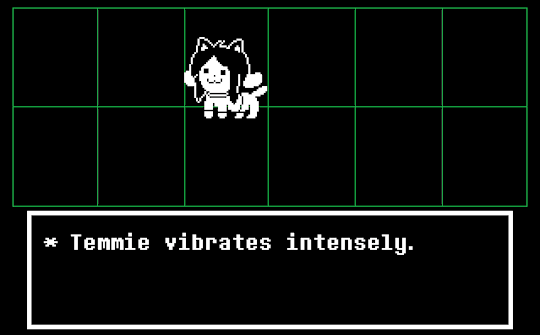
6 notes
·
View notes
Text
Noi’s 2019 Games In Review
Making ranked lists is blasé, so here’s some words about things I played in 2019 that may not actually be from 2019.
The Good
Self explanatory.
Sekiro: Shadows Die Twice
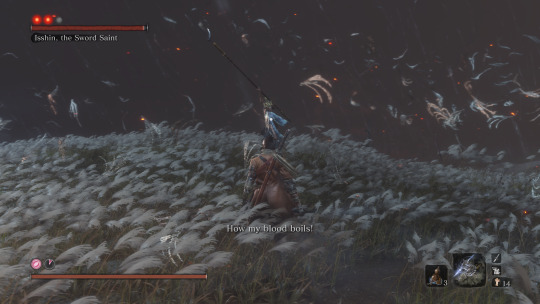
I came around to picking up Sekiro long after its March release. While I’ve played most of From Software’s “Souls” catalog, I’d gotten rather tired of the sort of expected routine that came with playing one of those entries. Planning out character builds, weapon upgrade paths, crafting options, etc is all good fun, but I’d gone through the same process enough times that I wasn’t quite ready to repeat the cycle again. My unwrapped copy of Dark Souls 3 is a testament to that.
Enter Sekiro, a game about a shinobi retainer tasked with protecting his master from a series of baddies after his immortality-granting blood. While it shares a similar framework with its Souls counterparts, it is fundamentally a completely different beast. Gone are the myriad player builds and weapon choices, the multiple stat upgrades that were often the source of much discussion about being worth upgrading or not. Sekiro only sports one main weapon, ten utility-focused sub tools and your own skill at learning and parrying enemy attacks. Multiplayer has also been excised entirely, meaning all the challenges the game throws at you must be overcome with your own skills. And it’s this focus that made me fall head over heels for it.
Enemies in Sekiro effectively have two life meters: their standard life gauge and a secondary Posture gauge that increases as you land hits and parry enemy attacks. If you break the opponent’s posture, they become vulnerable to an instant deathblow. Boss fights work the same way, with some requiring multiple deathblows to finish off. Likewise, you too have a life bar and posture meter, so combat becomes a dance of sword swings and parries, where death becomes another opportunity to learn enemy patterns, tells and counters. The hardest part, ironically, is the requirement of shaking off habits learned from prev games, whose typical tactics are heavily punished by enemies in this game.
Sekiro broke me, reforged me, then broke me again over and over again. By the time I wrapped up my first run and started my second, everything that had once felt like an insurmountable challenge felt it was moving in slow motion. It’s been a while since a game tested me quite like this one, and even its worst mechanics (Terror can go sod off) aren’t keeping me from going on a third playthrough after that.
The Outer Worlds

It’s hard to talk about The Outer Worlds without bring up its spiritual predecessor
Fallout New Vegas is one of my favorite games of all times. While a bit lacking in gameplay depth, New Vegas’ strengths lie purely on its fantastic narrative, character writing and setting, which elevate an otherwise average loot shooter into a classic of the genre. The Outer Worlds is Obsidian Entertainment’s stab at a game of a similar nature, free of the shackles imposed by working on another company’s IP.
The Outer Worlds takes place in an alternate future where corporations have effectively privatized outer space colonization. Much like New Vegas, several factions are vying for control of a region of space, whose ultimate outcome is determined by your actions. The Outer Worlds is functionally F:NV in space, with a lot of its same pitfalls and high points. Where this new game differs, however, is in its use of colors and stylization to depict its setting, which presents a much more trippy and psychedelic experience.
Character writing again takes front and center. I always felt like the two party member limit was too small, because I always wanted to take everyone with me to hear what they had to say about the particular mission I was on. The banter between squad members was always entertaining enough that I would often stop and just listen to each other. Parvati, an engineer companion whom you can pick up on the game’s first planet, had a permanent spot in my squad due to how great her remarks were on every single location I landed on.
Mechanically, I did feel the game was a bit on the easy side. Ammo for your different weapons is plentiful, and I very quickly stored up thousands of bullets, credits and health packs with which to plot through any challenge the game through at me. While I could have opted to play on a higher difficulty, however, I chose to press on regardless. I was much more interested in picking out my character stats and perks to find new ways to talk to and interact with the world I was playing in, which is ultimately the best reason to keep playing. Maybe some day I’ll intentionally lower my Intelligence to 1 and be dumb as bricks for a change. I’m sure there’s much more fun to squeeze out of this game just like I did New Vegas before it.
World End Syndrome

A few months ago, my fiancé brought up a visual novel that she had tried out the demo for and was surprised by. I gave it a go myself and, after being surprised at how long the demo’s offerings were, bought it alongside her to give it a read together. I’m glad I did, because I ended up really liking the finished product, which seems like your standard run of the mill VN at first glance.
Wandering through the game’s locations, the first thing that stand out is how beautifully animated everything is. Pinwheels spin in the breeze, candles flicker as they burn, and fountain water splashes as its spouted up into the air. A lot of care was taken to make the central location of Mihate town seem like a real idyllic place to be in. The game’s day/night progression also presents every location in daytime, sunset and night time views, which further add to the visual eye candy. It’s easy to tell that this is the aspect of the game that received the most care and attention.
While the character writing isn’t particularly stellar, the script does a good job of portraying the current residents of Mihate Town as normal people instead of a walking collection of tropes. I was routinely caught off guard by characters who did not behave according to what I expected from them, even when employing known archetypes like the rich female student or the obligatory idol keeping a secret identity. What’s more, said female students don’t receive as much of the type of skeevy attention I’m used to from modern visual novels, which is a refreshing change of pace. There’s still some of it there, including how the game’s progression is done through the now standard heroine route based system where one of them falls in love with the main character, but again, not nearly as much.
What the demo didn’t initially reveal was that the game also contained a whole system for traversing through the different locations in Mihate Town at different points of the day, uncovering events with its characters and progressing along specific routes as you did more events with specific characters. While I appreciate the attempt at changing up the gameplay, the game probably would have been better executed with a more traditional flowchart structure. The game keeps track of which characters you’ve met at which locations/times, but it without a guide it largely becomes a guessing game of figuring out which characters are at which locations, which are not marked until after you’ve been there prior on specific times of days. This makes reloading and replaying a constant routine, one that slows down the pace of the game.
On the other hand, it was funny to promise the rich girl that I’d help her with something, then willingly choose to go somewhere else instead.
Spirit Hunter: Death Mark

I hate horror media and entertainment. Sitting there waiting to be spooked by something is one of the most unpleasant feelings I could probably do to myself. I’m such a huge scaredy cat that even media that isn’t inherently about horror can scare me good, if done right.
However, I’m also a sucker for punishment, so I like to play horror games when the chance presents itself. And last Halloween, I spotted this in a sale, so I took the bait.
This game is about a group of curse bearers, carrying the titular Death Mark on some part of their bodies. Once the Death Mark appears on their body, they must deal with the spirits that cursed them before they get amnesia and die the next morning. The setting the story takes place is elaborated pretty well, drawing inspiration from multiple real-world Japanese folktales and legends to haunt its characters.
And yet, Death Mark isn’t actually a very scary game. While it has a few token jump scares, I got pretty good at predicting them and they stopped working along the way. Some of the actual spirits end up looking kinda goofy, which makes them more funny than scary. What Death Mark is actually very very good at, instead, is setting a mood. A creepy ambiance, unnerving scenery. Situations that seem normal on the surface, yet with just something off about the whole thing. In the first chapter, you’re forced to shine your flashlight down pitch black hallways and windows, where you very rarely get a view of something that shouldn’t be there, before it quickly vanishes. The first time it happened, I was forced to turn the game off for the night because I’d become too nervous to continue.
The sound design plays a huge part in making things in Death Mark as unnerving as they are. While the soundtrack for the game itself is rather lacking, with only one central theme playing in the hub location, the lack of music in its cursed settings actually helps set the mood further. Cricket chirps, the sound of footsteps, the sound of the characters interacting with objects and the creepy ambient spirit noises are the only things that you’ll hear as you traverse through forests, abandoned schools and sewers.
Overall, I had a great time with this one. We’ve picked up the sequel, NG, and likely give it a go sometime this year.
Judgement

With Kiryu Kazuma’s story wrapped in the Yakuza series, Ryu Ga Gotoku studios needed something to fill in the time between the release of Yakuza Kiwami 2 and its next mainline title in the series. Enter Judge Eyes (or “Judgement” in the West), a game starring ex-lawyer Yagami Takayuki, who wanders the streets of good ol’ Kamurocho on his quest to uncover the mystery behind a series of murders involving Yakuza members and his own past.
Judgement looks, smells and sort of plays like your normal Yakuza game. You’ll be running down the usual streets, playing the usual minigames like batting, Mahjong, SEGA ARCADE games and gambling with the notable absence of karaoke (though fully playable Puyo Puyo, Virtual Fighter 5 and Fighting Vipers somewhat makes up for that). You’ll do sidequests, resolve amusing side stories, date women you meet in said side stories, etc. It’s probably easier to talk about how Judgment differs from your normal Yakuza title.
For starters, Yagami isn’t Kiryu. Whereas the latter’s normal combat playstyle usually involves slower, powerful strikes, the former is younger and nimble. He can perform much more athletic feats like wall jumps and vault over enemies, which present a refreshing change from how combat is usually performed. Even when fighting in his “power” stance, Yagami retains a lot of his agility despite his normal attack strings being very different. You can’t equip any weapons this time around, so there’s a larger focus on tecniques and skills that you spend skill points on.
As the game’s story revolves around doing detective work, a lot of the game’s activities revolve around actions like gathering info, investigating crime scenes, and tailing suspects. To the game’s detriment, it leans hard on the tailing aspect, often using it for many of the game’s side stories as well as its main quests. Judgement can’t shake the stigma of tailing missions being bad either, with most of them being uninteresting chores with little variation. It’s a shame really, because the relatively few Phoenix Wright-inspired court segments would have made for a much better time.
All in all, Judgement does enough different to have been worth a look. With a smaller, tighter, and most importantly, fresh cast of characters and a different focus than what Yakuza games normally go for, I had a good time with Judgement and would gladly play another one of these that improved on what makes it different. Maybe when Yakuza 7 isn’t looming on the horizon…
The Unexpected
Sometimes you dive into something with no preconceptions and come out either pleasantly surprised or incredibly disappointed.
Prey (2017) - Surprised
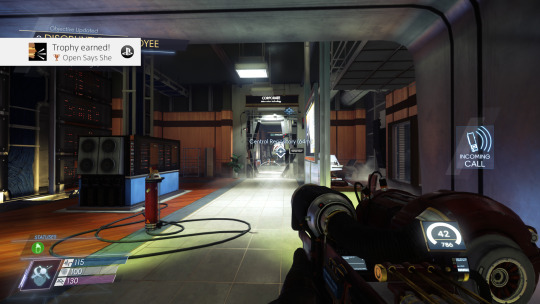
Ever since Bioshock Infinite crashed and burned last generation, I’ve had little hopes of a high quality immersive sim of a similar quality. Prey’s original release had seemingly come and gone with little fanfare, in part due to the controversy kicked up about it having nothing to do with the original 2006 game. After watching a livestream of the beginning hour of the game, however, my curiosity was piqued and I picked the game up.
Prey can be summed up as Bioshock with a healthy dose of Dead Space. The Talos 1 space station has been infiltrated by a mysterious alien race called the Typhon. As Morgan Yu, you must explore the derelict station and uncover the mystery behind the station, its few survivors, and the mysterious alien race whose research of gives you the ability to use psychic powers.
Probably the aspect that most impressed me about Prey is the scale of the entire station. Where Bioshock and Dead Space generally contain the player to separate paths and segment levels, Prey at one point gives you access to pretty much the entire station to explore. Talos 1 is a massive labyrinth of tunnels, pathways, sealed and blown off walls that often require some tricky platforming or thinking outside the box to figure out how to traverse. Spacewalking outside of the station further complicates things, as you can choose to exit out of an airlock and float to a different one from outside the station, further letting you appreciate just how huge the whole thing is. Quests in the game will often require you to go back and forth between different corners of the vessel, forcing to learn very quickly how to navigate the whole thing.
Searching Talos 1 is crucial too, because you’ll be using every single resource you can get your hands on. At no point did I ever feel like I had an abundance of ammo, health items or crafting materials, often needing to scavenge every single corner of every room just to scrape by. It’s a balancing act that I feel Prey straddles fairly well, at least until later in the game where I could shotgun most Typhon to death while mind blasting everything that came my way.
Prey isn’t inherently a scary game, but it does just enough to set you in a constant uncomfortable mood. Typhon skitter, hide and camouflage as normal objects, jumping at you once they get close. Typhon repopulate vacated zones once you stray too far from them, so you’re often forced to sneak around just to get the jump on the nastier baddies. Effective lighting and sound design make the empty hallways, stores and stations of the once bustling space station appear eerie and haunting. Audio logs, computer files and environmental story telling do a great job of building up and immersing you in the world of Talos 1, where the equivalent of a city population had its fate irrevocably altered by the science experiments of two foolish scientists.
Zero expectations going in, pleasantly surprised coming out. Pls let Arkane studios do its thing and don’t mess up a sequel, Bethesda.
Final Fantasy XIV: Shadowbringers - Disappointing
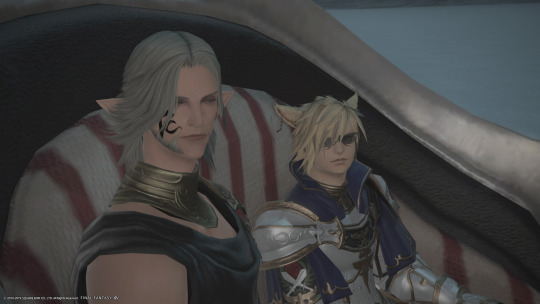
I love Final Fantasy XIV. I’ve been playing it since its original failed 2010 release, through the growing pains of A Realm Reborn, the peaks of Heavensward and the pitfalls of Stormblood. I bonded with my fiancé through this game. I used to actively recommend this game to friends. Stormblood started a change in my feelings about the game, but Shadowbringers solidifies those feelings of worry and concern. When discussing Final Fantasy XIV, there’s two major aspects to delve into.
First is the game’s “face”, the tangible content that players see and interact with. The story in Shadowbringers is probably the most well-received so far, with lots of dramatic moments, likeable characters and an engaging narrative. While I have my own reservations about it, like the pacing in parts slowing down the an unbearable crawl, I’m largely fine with it. But a game, specially an MMO, is more than just the story. Shadowbringers stars the least interesting dungeons yet, with only its two endgame ones being even remotely interesting. Endgame raids continue to be glorified trials, a carry over from the previous expansion, that use the story to justify stringing together an otherwise disjointed series of boss fights. The same, tired series of content staples: dungeons, trials, 8 man raids, 24 man raids, treasure maps, beastman quests, wrapped around the same daily and weekly limitations designed to keep you playing day in and day out. Many praise the consistency in the amount of content delivered with each patch, but as someone that’s been playing for such a long time, its hard to get excited over doing the same thing as before but with a new coat of paint, which is the feeling I get when playing Shadowbringers.
All of this is without getting into the combat, which received another refresh with this expansion. Tank roles were largely homogenized to the point where outside of specific skill nuances, they largely feel like the same job. Healer roles were also homogenized to a degree, with expanded healing kits but massively reduced offensive skills. DPS role balance remains all over the place, with players often scratching their heads at what the intent behind some of the job changes are. Where before I could tolerate shallow battle content by being competent at my chosen role, the skill ceiling feels like it’s been massively lowered. The content itself hasn’t changed to suit these changes either: Tanks play like DPS jobs that have to press a few buttons to survive busters. Healers continue to ignore their slow casting spells in favor of skills that are off the global cooldown while pressing their single nuke button to attack. DPS continue to do the pattern introduced in Stormblood of building up a resource gauge, spending it on a burst damage window then building it up again. It feels like the dev team is stuck in a creative rut, where the need to make the game easier to play for newcomers takes priority over actually expanding on the roles.
Which leads to the second aspect to discuss: the game’s management.
In the last live stream for the game, it was announced that players would get one less dungeon during the game’s “main”(X.0, X.2, etc) patches, which follows the last’s expansions decision to remove one dungeon from the “off” (X.1, X.3, etc) patches. The justification for the decision was that it would free up resources and development time to create new, different kinds of content for players. While it remainds to be seen if this will end up being true, Final Fantasy XIV has a spotty and often maligned history with new types of content being released in a rushed, undercooked state, often lacking features that were expected of it. The “Ultimate” series of raids have been credited as being a result of this cut, but content designed for the 1% of the best players in the game isn’t a replacement for the type of things I would regularly play.
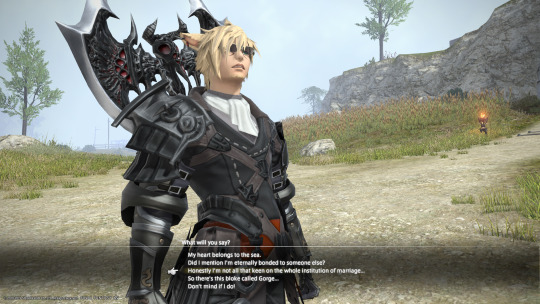
On its own this wouldn’t be such a big deal, but the XIV team has, as of its last expansion, decided to start drip-feeding the content released in each expansion over the course of months. Rather than releasing everything at the start of each patch, as was the norm before, certain features and modes are being pushed back in an attempt to fill in the otherwise empty months between patch releases. While fine in theory, their justification for it has been flimsy at best, and the end result is that players now burn through the smaller bits of content that are released each month at a much faster rate. As of writing, the next content update for the game is in February, with the game receiving its last significant update in October. In the interim, there have been smaller updates for a new PvP map, a new crafting mode that players finished within a week of its launch due to it being the only new thing to do, and another update for its much criticized “Blue Mage” job. If you, like me, weren’t interested in those updates, you’ve had nothing new to do since October. If you were interested, then you were forced to arbitrarily wait for the content to be released before being able to try it.
By making individual pieces of content the “focus” of an entire patch, they’re massively reducing the shelf life for how long it can keep player’s attention. The much awaited Ishgardian Restoration came and went in patch 5.11 with barely a splash, as players had long since cleared and gotten bored of the dungeon, trial and raid released in 5.1. 5.15′s update came with a new PvP map, forcing players into that map instead of the variety of ones already available. It feels like the management is making shortsighted decisions to make it seem like the game has a lot of content, but releasing content that doesn’t have the depth to carry the game for long periods of time on its own.
Again, I love Final Fantasy XIV. I want to have reasons to play this game as much as I used to do. But as time goes on, it feels like the game keeps being taken in a direction different from its focus when I first fell in love with the game. While I still see myself playing the game for the foreseeable future, it’s a bit of a shame that the expansion poised to change up the status quo just ended up being more of the same.
20XX - Surprised

It’s been 16 years since the last Mega Man X game, and the gap for that specific style of runnin’ and shootin’ platformer has yet to be filled by another company or Capcom themselves. So like most ideas these days, an indie studio went up to bat in their attempt to fill that niche, but with a spin. 20XX is a game I actually knew I wanted.
See, around the time Mega Man 9 came out, I used to day dream about a hypothetical game in the series featuring online coop. I would picture Mega Man, Bass and Protoman, controlled by different players, runnin’ and shootin’ up baddies as they went through the level. Mega Man 10, despite being an excellent game that I like a lot, did nothing to really improve on that standard formula. So when my fiancé pointed my attention to 20XX, which proudly advertised its online play features, I immediately coerced her into trying the game with me.
20XX plays like as expected. The core gameplay is as MMX as expected: You can choose to play as expies of X and Zero, who must defeat 8 bosses and then one final level. Levels are procedurally generated, with the difficulty of the layout and enemy placement increasing in difficulty the later a level is chosen. Boss fights reward you with either their own signature power, or your choice of upgrade items that increase passive stats for that run.
Where I didn’t expect inspiration from, however, was Binding of Isaac. 20XX is designed to be played over and over again, with a special currency unlocking new items, upgrades and even permanent unlocks that you can find in each new run of the game. You start the game with only a handful of items to find, but the pool can vastly increase the more you play. It’s a genre mashup I never expected, but improves on my original idea of simply “Mega Man, but online”.
It took a solid 10-20 attempts before my fiancé and I successfully cleared our first run of the whole game. It may not be the same as another fully fledged Mega Man X title, but until Capcom gets around to that, it definitely scratches that same itch.
BlazBlue: Cross Tag Battle - Surprised

After the whole” no dub” debacle with BB Chronophantasma, I took a long break from the series (and fighting games in general). I saw the initial reveal for this game, as well as the buckets of DLC characters offered post release. With the recent 2.0 update, I finally got around to giving it a whirl.
I had way more fun with this game than I really expected to. For as long as I’ve spent playing BlazBlue, I would invariably resort to one or two characters due to the complexity of playing different characters in that series. Here, because the inputs across the entire cast are mostly shared, I could pick a team of any two characters I like from across four or five different series and have a good time. Characters who I’d originally really wanted to play but were too complex for me to handle were now accessible for me to pick up and play. Even characters who I regularly used before I could now control with relative ease.
Would I pick BBTAG if I wanted a deep fighting game? Probably not. But I can appreciate this game as the Marvel vs Capcom 2 of anime games: a great way to kill time with other anime game loving friends.
Ciconia When They Cry Phase 1: For You, The Replaceable Ones - Surprised
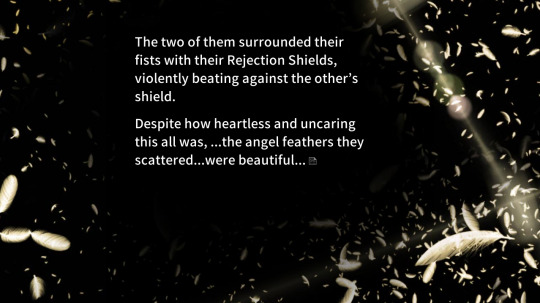
I don’t love everything that 07th Expansion releases . While I loved the series that came before it, I remain apathetic to most other of their releases. So for this one, I decided to intentionally keep myself in the dark, which wasn’t hard all things considered. I had my reservations going in, as I expected a similar style of supernatural story as the two other series. Because I discovered Umineko later in its lifespan, I was also wary about paying for a large up front cost for all of its later episodes rather than getting a package deal.
To say the end result is excellent is an understatement. While still very much a mystery game like the others, Ciconia sets up an international conspiracy involving characters from many different countries and nationalities. The Gauntlet Knight has taken the role of the military’s main fighting force, a position that can only be taken by younger children who can handle the mental stress of the Gauntlet weapon. The resulting clash in ideology between these children and the older generation forcing them into a war between nations they want no part of, as well as the machinations of the shadow society pulling the strings, drive the major plot beats and setup questions that and answers the player can only guess at for the time being.
Ciconia is very much a game of this generation, one that carries many of the themes, struggles and societal topics that we are actively experiencing in our current generation, making the whole thing hit closer to home than I expected it to. It’s honestly refreshing to see this game feature such a varied cast of nationalities and even religious beliefs. While not all of the huge cast get equal amounts of screen time, I’m sure everyone will get their due as the later episodes come out. I’m eagerly looking forward to the next chapter.
Death Stranding - ????????

I also stayed as much in the dark as I could for this one. Knowing how Hideo Kojima designs games these days, I wanted to get as pure a reaction to the inevitable weirdness in this game as possible. Bring on the mega long cutscenes and pretentious storytelling, I’m here for it all.
But in the end, the game isn’t actually as weird as I expected it to be? Sure there’s a baby glued to your chest that lets you see invisible undead monsters, but that’s not any weirder than Metal Gear’s weirder aspects. The vast majority of your playtime is spent delivering packages from point A to point B as Sam Porter Bridges, delivery man extraordinaire. And while admittedly I found the core loop of finding ways across huge expanses of uneven terrain oddly satisfying, it isn’t enough to carry a game as long as Death Stranding, even with the many gadgets and tools they drip feed to make going back and forth easier.
This is where the story and cutscenes would fill in those gaps in the gameplay, but even those are oddly few and far between. As it turns out, getting mocap for A-list celebrities is actually kind of expensive, so most of the game’s interactions are relegated to mail messages, small interactions with hologram projections and indirect exchanges with other players by liking structures, items and vehicles they’ve played around the world. Cutscenes vary in length from short affairs to megaton movie length, but they’re so few and far between that you might play for hours without reaching the next one. It’s such an uneven experience that I’m not sure what to think about the whole thing.
As of now, I’m not sure how far into the game I still am. I’m still interested in the game, as I do enjoy the normal feeling of seeing all my delivery stats go up and my number of Likes increase. But the more I play, the more I lose the drive to reach the end of the journey. Reaching the next major plot point is less appealing than just going on a walk or a drive and enjoying the game’s admittedly pretty sights.
The Ugly
It’s not you, it’s me.
Assassin’s Creed Odyssey
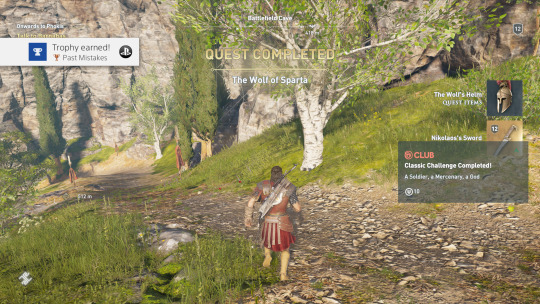
Odyssey is for all intents and purposes a sequel to AC: Origins, a game that radically changed the formula for the series. It’s well documented that Ubisoft wanted to expand the audience of the series, even with the risk of alienating older fans. And alienate they have, as Odyssey doubles down on the live service game aspects and Witcher 3 influences and skims on the things that made the series unique in the first place.
I could probably write an entire post just on the ways Odyssey retcons series lore, ignores series conventions and is just not a well-designed game in general. It remains the only mainline game in the series that my fiancé and I have put down and not come back to. I can only hope whatever future game is released in this series is a return to form rather than another experiment in creating a mediocre facsimile of better games.
The Last Guardian
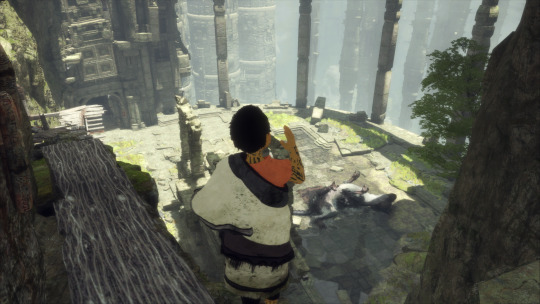
A decade after the release of Shadow of the Colossus, Fumito Ueda finally released his much delayed sequel to the masses. And boy does it feel like a game conceptualized and developed since the 2000′s.
Of all the faults I found while playing this game, I think my biggest gripe is how boring the whole thing is. Where Ico had its shadow demons trying to kidnap Yorda to break up the platforming, and Shadow of the Colossus had its clashes with its titular massive beasts, The Last Guardian spends hours forcing you to guide its rather mundane, unresponsive dog creature down samey looking hallways, corridors and passages. No real conflict or much of interest occurred in the entire time I spent playing the game, making slow progress as I struggled with the controls for both the boy and his dog. I’d much rather just go back and replay SotC for the umpteenth time.
Kingdom Hearts III
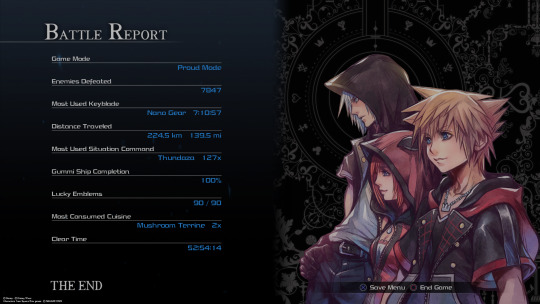
Like The Last Guardian, Kingdom Hearts 3 is another long awaited third (sort of) game to a popular series by Tetsuya Nomura. Like Final Fantasy XV, the game Nomura got booted off to work on this, KH3 feels like a rushed, unfinished project pushed to release to meet a financial deadline. Playing through the game, you can’t help but feel the general lack of polish, missing features and just general clunk that you wouldn’t expect from a major release in this series. There are many largely unbalanced gameplay features that players go out of their way to not use, in order to keep up the flow of combat and not make the game a complete pushover, which happens even on the hardest difficulty at the time of release. This is without talking about what a huge mess the game’s climax is, which rapid-fire resolves many of the series-spanning mysteries and questions in an attempt to just wrap up the whole thing before concluding, not giving each plot thread the weight each resolution deserves.
With the Re:MIND DLC on the horizon, SE seems to be looking to fill in those gaps, with multiple playable characters, more story bits and an expanded ending world. I don’t feel a particular need to pay more money to fix something that should have been there from the start and I felt like a beta tester for.
6 notes
·
View notes
Text
Favourite Games of 2019
I don’t like making ranked lists anymore. So here’s a bunch of games old and new I played in 2019 because I was busy catching up due to not playing FFXIV as much as in previous years.
Ciconia When They Cry Phase 1: For You, The Replaceable Ones
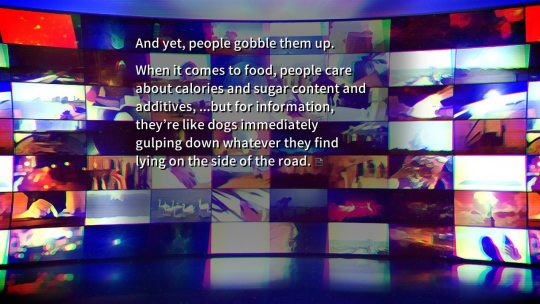
I think going in, and even starting to play it, I felt like maybe the game would abandon the WTC mystery game conventions. It ended up not doing that, because the game leaves you with far more questions than answers at the end. The A3W World (“after World War III”) is still trying to deal with political issues and social issues that existed prior to World War III. A global stalemate exists due to the military implementation of the Gauntlet weapon. Eventually things happen where different countries need to deal with a shortage of resources, territorial conflicts, etc which sets off a chain reaction to World War IV. However, the children who grew up in the A3W era, settled into new ideologies and views of how society currently works are at odds with what the older generation wants and requires of them. Along the way, they need to deal with other groups and conspiracies in order to maintain the Walls of Peace.
So in essence, R07 still crafts a mystery for readers to figure out, but it isn’t a murder mystery. It’s an international conspiracy mystery and I am more than okay with that. I think this chapter required a lot of worldbuilding to set that kind of story up and coming out of Phase 1, I understood why the first chapter wasn’t exactly like Umineko’s. I thought that it was handled well, despite some of the purple prose (but if you’ve played a R07 game before, you’re likely used to it). I also thought he really tried to introduce and incorporate themes including gender, generational differences, societal tiers, geopolitics disguised as sports events (possibly mirroring the 2020 Olympics in Japan), etc. as well as he could throughout the story through the game’s cast. Even if the game meanders a bit (and it definitely feels that way towards the start), when it actually starts to roll, I felt compelled to keep reading.
And truly, the game has an incredibly large cast of characters. The TIPS section handles introductions well, and while some cast members don’t have as much time in the spotlight as others, I can see them getting their time eventually in subsequent chapters. Clearly Phase 1 exists to focus more on the children from the Arctic Ocean Union (the “AOU”) as evidenced by the additional stories unlocked at the end of the game so hopefully other chapters have the same amount of character backstory for the other factions. I also genuinely enjoyed that the big international cast of characters allowed for many different types of designs with characters with different types of hairstyles and hair texture or characters wearing hijabs and still managed to make them retain adorableness or a sense of style. I do not recall seeing it as often in Japanese media and I’m very happy to see it here.
I think Ciconia Phase 1 is a very good start to this subseries’ planned four episodes and I hope to see more sociopolitical commentary. It feels as though R07 looked at everything happening in Japan and social media/how news is consumed and decided to write a four-part SFF series about it. I’m eagerly looking forward to the next chapter.
Bloodstained: Ritual of the Night
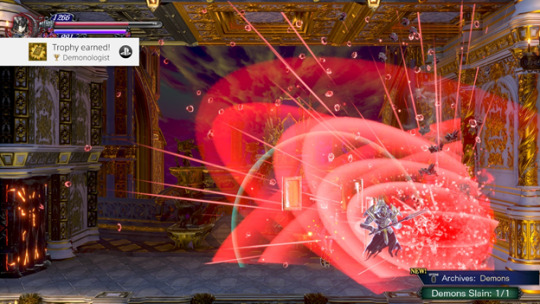
I backed Bloodstained when it got put on Kickstarter a few years ago. It was shipped to me at… possibly the worst time since Shadowbringers was coming out very shortly after. My fiancé and I played ours for a short bit, felt very positive about the game, then dropped it to play Shadowbringers. We didn’t return to it until maybe September/October? Both of us ended up getting our Platinum Trophies for it so we both played through everything the game had to offer.
Bloodstained is a good experience, but not without its issues. I played on PS4 and I’ve had a few outright crashes or some glitching into walls early enough that I couldn’t come out of them again due to not having the required skill to try to get out of it. I also felt like the game meandered or had a bit of padding in its earlier stages). Later on, you realise you have to put in the farming work to have a better and faster time not unlike its Igavania counterparts, but I did feel like the drop rates prior to actually working towards higher luck stats/drop shards were low enough almost to the point of unfair or deliberately wasting my time. I also felt as though there were too many weapon types; with adequate shard use and shard grinding eventually you can settle into one weapon type that suits your playstyle or eventually use the gun for everything when you get the special hat quest reward).
However, I’m speaking about this game as someone who platinumed it which requires a lot of farming and synthesis. As a player going through the main campaign, I think the maps are adequate. The backgrounds are very lovingly crafted, and the music is absolutely one of the best of the year. Boss design is also fun and rewarding, requiring the player to learn how all the different weapon types work, adequate backstepping and closing in, and boss patterns. If you suck, the game will show you that you suck very quickly and deliberately. Essentially towards the end, I felt as though Bloodstained tried very hard to cater to fans of the metroidvania style of game, and the classicvania style of game. I personally don’t think it completely succeeded but for a first time experience of trying to combine the two into one, it did its job with preparation for another game.
I also feel like some criticism was lobbed towards the game’s narrative for being told in library/book entries, and while I understand that (I actually couldn’t open all of the books for fear of my game crashing), I don’t think elaborate cutscenes and continuous dialogue would work well with this game’s flow. Bloodstained prioritizes gameplay elements and player exploration over anything else, and to be honest, I’d rather it happen that way than with long elaborate cutscenes. I also felt as though I got more out of the game because I’d played the 8-bit prequel as well.
Overall, Bloodstained is a passable experience. I’m glad I played it, and I’m glad I put the work in to try to make the game a better experience. I got what I wanted out of the game for as much as I backed it and I hope they try again with a similar formula because this is a very good first step.
The Touryst
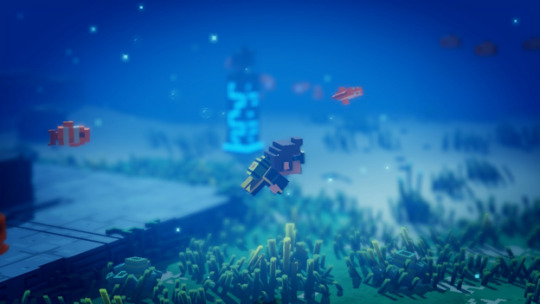
Sometimes when I see a game with voxel graphics, I feel pretty compelled to pick it up because it looks so darn lovingly rendered and it usually ends up being fun. The Touryst does a good job with its graphical style and visiting new islands is a complete delight because of it. It looks like a game with style, and performs super-well on the Switch. It’s also one of the freshest games I’ve played in a while.
Basically you’re playing a blocky dude with a moustache who just wants to have a good time but when he gets to TOWA Monument, he’s told he has to find monument cores to unlock the world’s secrets. And then you can do whatever you want. The different islands have their own little personalities: there’s an island called Fijy which is volcanic, there’s Ybiza with a bunch of dudes chilling on the beach and passed out on their chairs, there’s Santoryn which is just Greece, and a few other places that are essentially recreations of real-world places.
As you explore, there’s a lot of stuff to do. A variety of things to do. There are puzzles and mechanics that don’t necessarily overstay their welcome, you can play footy, you can play spelunker, you can take helicopter rides, you can take pictures, get stuff for a museum, surf, play rhythm games…. It’s your vacation, do what you want. It’s a little like Vegas. Unlike Vegas, you can use your ever-increasing money and diamonds to get new moves for your moustached character to reach new objects.
As a little game where you can do whatever you want little by little, and makes for a smooth experience, I’m glad I picked up the Touryst after asking another person what they thought of it. It has great puzzles, lots of stuff to do and explore and see, and ton of minigames for whatever mood you feel like you’re in. The game is fairly short, but I’m very glad the holiday doesn’t overstay its welcome.
A Short Hike
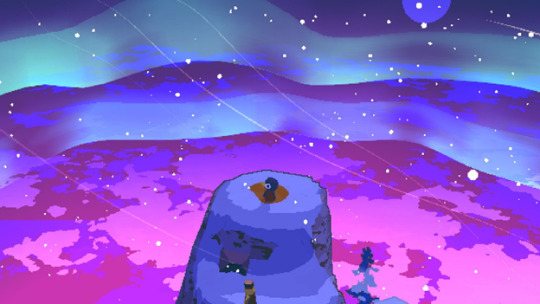
A Short Hike places you in the shoes of a bird who is utterly determined to walk to the top of Hawk Peak to get signal for her phone. I totally understand; sometimes you’ve gotta do what you gotta do.
But the game allows you to undertake that journey however you want to. You can go right away and finish up and get that darn signal. Or you can take your time and we’ll build that bridge when we get there. There are different types of terrains to explore if you opt to take the scenic route… and it’s rewarding to do so. You can find treasure, you can water a flower, you can talk to the Animal Crossing-esque characters to do some sidequests, you can do whatever you want.
I’m sorry to say that when the game introduced fishing, I spent a lot of my time doing that. Fishing ruins me. The completionist in me wanted to fish. But the whole thing is that you don’t have to do any of this. If you want to finish the game, you can absolutely positively focus on that and the game doesn’t pressure you for it.
And that’s one of the things I like about it. It’s just whatever about the whole ordeal. I don’t feel like I’m completely and utterly missing out if I don’t decide to do something. Even the task of getting Golden Feathers to progress is fine since you only need eight for it, and the game easily gives you enough rewards to get four or five before sidequests or exploration is factored in.
Sometimes you just need to take a walk and kind of think of nothing just to clear your head. And A Short Hike accomplishes that very well.
Worldend Syndrome
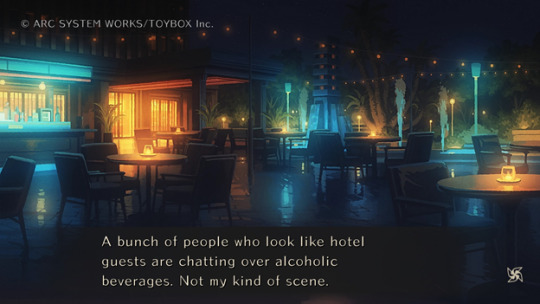
In my effort to try to find other games to play in 2019 because I’d fallen a little out of love with FFXIV, I realised that taking baby steps with visual novels and bite-sized games would be the best idea to try to get back into traditional games (particularly since I was, and am, still questioning whether I like games as a hobby or not). On a whim, I decided to download a boatload of visual novel demos one night and tried a bunch of them out. Worldend Syndrome’s demo didn’t exactly grab me until perhaps halfway through the demo when I a) realised that this demo was long af, and b) nothing appeared what it had seemed as I kept going through it and the characters were enjoyable.
So I decided to get the game and dragged my fiancé along for the ride. It’s one of those standard decision-making/pick which girl you want and go down her route VNs but it didn’t really feel skeezy or ecchi other than one particular point in each girl’s story where you get confessed to. You go through the VN as an unnamed protagonist who is visiting his cousin over the summer, and you and your friends get dragged into a school club whose focus revolves around folklore. The town the protagonist finds himself in is haunted by the Yomibito, spirits of the undead who look exactly like regular people but are eventually driven mad enough to kill.
One of the things that drew me to this visual novel was its assortment of animated backgrounds. They colourful and gorgeous. Every CG looks nice and coloured well, and the backgrounds for each area you visit are so beautiful and makes every single location easy to settle into. The cast is also surprisingly decent, where I expected to hate a few people but I ended up being okay with them because they were written well and weren’t as tropey as I had expected. I was also very pleased that the character that you were roleplaying as wasn’t skeezy when put into situations where he could have been, and that he treated the girls very well (though I won’t deny that there are some spots where behaviour was questionable but it doesn’t happen as often). Because the characters were written adequately enough, the game’s true ending route comes together very well and very naturally to a point where I could seriously believe that every character got along with one another to make sure the emotional impact of the mystery was satisfying.
In order to finish Worldend Syndrome, you have to do each route. A few characters’ routes don’t get unlocked until halfway through the game or even until the very end. The game also remembers everything you’ve done when it autosaves the system data on the world map, so if you need to reload a save to figure out someone’s schedule or if you mess up, it’s relatively easy to come back to something you’ve missed. I’ve played a lot of multiple route VNs before and Worldend Syndrome is easily one of the better VNs that allows the player to skip through to something they’ve missed or skip through previously-viewed text for another route.
As it is, Worldend Syndrome doesn’t really try to do anything spectacular, nor does it try to stand out like other visual novels of 2019 have (ie: Ciconia, presumably AI but I only tried the demo and I hated parts of the script, sorry). It does its job and tells its story which has a very good payoff in the end.
Judgement
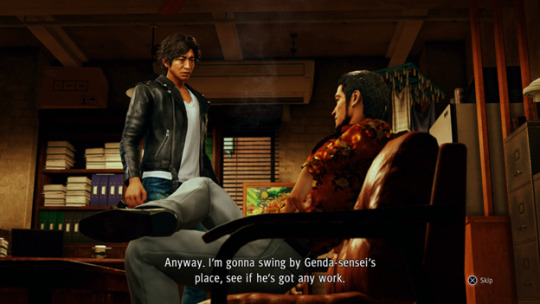
I bought my fiancé Judgement earlier this year, as I had retired from playing Ryu ga Gotoku after Dead Souls/Ishin, and he was still playing the series religiously. I watched him play through part of it and I felt compelled to get my own copy because the combat looked nice, and the characters were compelling enough that I felt comfortable picking it up.
Judgement follows former lawyer Takayuki Yagami who is now a detective. His tale is one of redemption and conspiracies, reminiscent of some Phoenix Wright games (which this game gives clever nods to when the protagonist is in the courtroom). Yagami is more serious and down-to-earth than Kiryu is so the tone of the game feels quite different than other RGG games (or at least the ones I’ve played).
It still feels like a regular RGG game where you’re still wandering through Kamurocho, you’re still getting into fights with randos and Yakuza dudes, you date girls, you go to buy food, you play minigames, etc. But it isn’t as big as a standard RGG game; because you stay only in the one area, the cast is smaller, you get a job board to get your sidequests from, and the story itself is fairly short and sweet. I actually prefer that as a lapsed RGG player since it’s easier to get back into the games this way.
Judgement, however, disappointed me just a little in how little you spend in the courtroom. You’re given opportunities to present evidence, do some suspect tailing, use your smartphone to catch a cheating husband, or use a drone to search for evidence. I felt like when you had to use the drone to search for evidence, it ruined the pacing a little. The tailing missions are also reminiscent of Assassin’s Creed, and no that isn’t a good thing! Due to this, I felt like Judgement was not necessarily a great detective game but it did a decent job of trying to mold the RGG experience to a different main character.
Yagami can… fight… for some reason so he can beat up whatever randos come up to him on the streets. He’s actually more acrobatic than I remember Kiryu being in previous RGG games. He can kick off objects, he’s hard to back into a corner, he can do wall-flips, etc. It’s also much easier to earn XP where it’s all in one bar so you can do whatever you want to fill it up like play darts and just put stuff into his lockpicking. As a lapsed fan, the streamlining feels okay. The streamlining for combat also feels good because if you fights go on too long, the popo can come for you and you’d get fined, so emphasis is on finishing fights cleanly and quickly.
Overall, as a lapsed RGG fan, the way Judgement looks and feels and wraps up its twists and turns was really exciting for me. It may not have as many things to do as other RGG games, but honestly I think being a leaner experience was better and thus didn’t make the game overstay its welcome. I also am eagerly awaiting RGG7 since I enjoyed the demo a lot and I think the new protagonist can carry the series the way Yagami carried Judgement.
Cadence of Hyrule
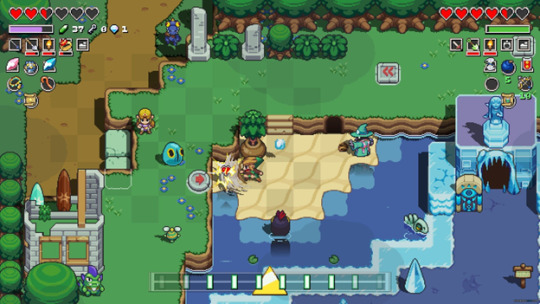
Sometimes, after my fiancé and I bought our Switch, I’d wake up, go brush my teeth, and return to bed just to see my fiancé awake and playing Cadence of Hyrule. I was perplexed as it’s been ages since he’d willingly played a Zelda game, and his hands are super-huge for the joycons so he doesn’t like using them much.
You can easily say that Cadence of Hyrule is just a Crypt of the Necrodancer reskin with Zelda stuff all over it, but feels pretty clever in that it uses stuff from roguelikes and a rhythm game and makes the A Link to the Past world feel incredibly fresh. Bosses, especially, feel very fresh. Enemies move according to the rhythm and have a unique pattern that’s easily memorized so you can fall into the rhythm and take advantage of. If you’ve played Necrodancer, you’ll probably feel at home in this aspect, especially since the maps are also randomised (which leads different playthroughs feeling fresh).
The Zelda feels comes from recreating tunes from older Zelda games in puzzles, the magnificent sprite art, the great Zelda remixes, a simple-enough story, and a standard set of things to find in each procedurally generated dungeon. You also find a variety of traditional items like the bow, the bombs, boomerang… and a spear? It’s a nice blend of Zelda and Necrodancer.
The caveat is that it takes a little getting used to, since you’re not exactly used to not being able to freely move in a Zelda game. But when you do get used to it, it feels good. Everything is pretty expendable and if you die, you don’t feel like you necessarily lose a lot since you can accrue it all easily enough again. It’s unpredictable and that random roguelike nature is something that makes the Zelda experience feel fresh.
Spirit Hunter: Death Mark
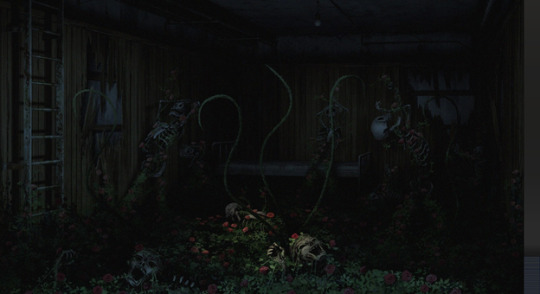
My fiancé and I were trying to find spooky games to play for Halloween that wouldn’t make me squeamish because despite my profession dealing with analysis of body parts and human body fluids, I can’t see that kind of stuff on TV or in games in a realistic sense. It grosses me out. At least when it’s in front of me, it’s already out and off someone’s body and in a fume hood/biosafety cabinet and I didn’t have to see how it happened. My fiancé picked up Spirit Hunter: Death Mark on a sale we went through it together.
Death Mark is a tale about horror-themed urban legends and a curse that needs to be broken. People get marked with a crimson bite mark in the game’s H City and they eventually develop amnesia and die. A group of people live and gather at a spirit medium’s mansion (who is dead upon arrival). The only hint to break the curse in this mansion is a little talking doll named Mary. The protagonist eventually goes through several mysteries in an effort to break his curse and stop others from dying.
Death Mark does some surprisingly well-crafted worldbuilding. Each spirit you deal with has a well-told backstory, sometimes especially ghoulish (particularly the bonus post-game episode, the first episode, and the one episode with the telephone booth). The game excels with psychological horror and the enemies involved in each boss battle assist in making the player feel that way as well. The backgrounds also lend well to this as while they are simplistic, the shading and colours used help to execute a sense of dread. One particular chapter harkens back to Japan’s Aokigahara, and the backgrounds used connect very well to that particular location so that it feels super-eerie.
Regardless, Death Mark relies a lot on its text to establish its atmosphere and as someone who reads stuff like R07 VNs and other regular VNs with a lot of text, I was okay with that. The localization was well-done, albeit with some issues that would have been caught in editing but overall it carried the story very well.
There are boss battles prior to the end of each chapter, where you must use each item you find in your exploration segments. You need to use specific items in a specific order (even with the correct party setup) in order to achieve a good ending for that particular chapter (and thus eventually the game). I thought this was an interesting mechanic and while it got a little tired depending on the spirit, it showcased how creepy some of them can be on your screen.
Unfortunately, Death Mark does not have a variety for its soundtrack and it’s almost disappointing that the same piano tunes and boss themes played repeatedly as I felt it detracted from the experience.
Otherwise, I felt like Death Mark was a short and sweet horror experience that played into urban legends and folklore experiences. I loved the little vignettes that eventually ramped up to a central story point. I hope the sequel is good when we get around to it.
Sekiro: Shadows Die Twice
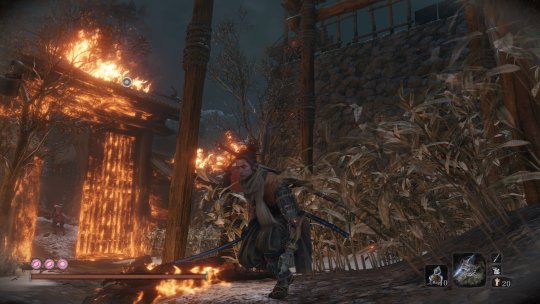
So my fiancé and I are doing this thing where we’ve started buying one copy of a game so we’d both own it together and go through it together. Sekiro and Man of Medan were two of those games this year.
Sekiro isn’t really like Souls. Eventually you’ll come to learn that very quickly when the game throws a boss at you and if you try to play like Souls, you’re not going to get the job done. It will show you that you never learned how to parry properly and you’re going to have to go back and learn it. Or if you didn’t grab a prosthetic that will make the job easier, you’re gonna have to do that too.
The game is interesting in that you aren’t exactly whittling down health bars all the time; you’re striking properly so you can overwhelm their posture bars, find an opening, and go in for the kill. Enemy health bars are essentially secondary to that posture bar. You have your own posture bar so you’ve got to learn how to parry properly. Sometimes you need to parry complete combos in order to deliver posture damage back to an enemy. It’s all about getting into the flow and rhythm of combat. And you must beat bosses in order for you to get a stat boost, so being able to beat a boss lies in your skill, and not necessarily your level/equipment.
Sekiro is Souls-like in its storytelling and worldbuilding. You can run around rooftops and areas to find secrets off the beaten path. You go back and forth between areas and speak to different NPCs to find out their backstories. The plot is also told via NPC conversations with the main characters. At first it’s a little dry but the story opens up eventually. It also has some great voiced NPCs for quests (one quest in particular had voicework that made me feel so sorry for the character that I was like “we need to get the proper item for this guy please don’t make him suffer”).
It feels rewarding to put in the work in order to beat the bosses, make it so you don’t resurrect as often to make people sick, and meet whatever standard Sekiro is throwing at you. It lets the player know that they’ve met that standard, and then throws another boss phase at them so you have to get even better.
Owl I’m looking at you.
Super Kirby Clash
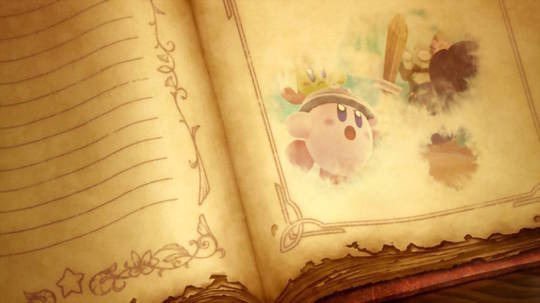
My fiancé and I bought a Switch together this year (which, outside of dinner and movies and clothes, etc. was one of our major purchases together). We downloaded a few demos to try the control scheme out, including Super Kirby Clash. I am aware that this game is probably old, but hey it’s still going and it’s still being supported and I’m catching up.
I’m probably putting it here due to bias, but I think It’s really cute and the hats are super-adorable. I love getting new hats and new weapons for my little Kirby. It’s fairly standard as far as a “mobile experience” is concerned and playing it a little when I have the time to and hacking away at it little by little is rewarding when I get a new hat or new gear. My fiancé and I played it in multiplayer as well, which felt a lot like Kirby’s Return to Dream Land.
It’s pretty inoffensive and I haven’t paid real-life money for anything in it, and I still feel like I’m progressing. So as a Kirby game with light RPG elements (ie: something I’ve wanted for years and years), it’s nice to finally see realised.
Monster Boy and the Cursed Kingdom

An artist I commission very often from convinced me to move this game further up in queue than I originally had it when we were talking about games we were playing after finishing Shadowbringers’ main campaign.
Monster Boy and the Cursed Kingdom is the spiritual successor inspired by Wonder Boy III, with the formula being modernized for a new era. It feels fast, and it looks soooooooo pretty. The tracks are bumpin’ too. It’s also a little tough but with every difficult section successfully platformed through, you feel really good about it.
You play as a plucky boy named Jin whose uncle is an insano who turns everyone in the kingdom into animals. After you experience sweet freedom as a human boy platforming across things easily for like 15 minutes, Jin’s uncle turns him into a pig. Whoops. From there the platforming gets a little harder and you need to learn how to manipulate different forms and different spells in order to get across various sections.
Different animal forms give you different skills. Pig form allows you to sniff out secrets literally, snake form lets you cling to walls and go through tiny passages, frog has a sticky tongue for swinging, and lion form lets you go through obstacles. You need to use these forms well to platform well enough to get through each area and finish the game. Being successful at platforming in this game feels good and fulfilling and satisfying. As you unlock more, platforming experiences get more and more complex with more obstacles put in your way, so in essence it feels like the opposite of a standard metroidvania. Playing both Bloodstained and this in one year felt like playing polar opposites. That said, the checkpointing in Monster Boy is really good. Game Atelier knew what they were doing.
The bosses by contrast were really easy and it’s nice to take the time to look at the art for each boss. All of the effects are also super-nice. Playing Monster Boy on a 4K TV is quite a visual treat for its boss sections, its town section, and its platforming sections. The colours are off-the-charts. Each animal sprite has its own set of unique animations: the piggy farts and looks like >_>, froggy looking at flies, etc. And the music is so good. If this game were a 2019 game I’d definitely put its soundtrack on my list, but it isn’t. It’s a nice blend of new and old stuff and it’s a delight to hear in-context as encouragement to keep going when you fail a platforming section.
Monster Boy and the Cursed Kingdom is a faithful representation and homage of the old Wonder Boy games. It’s filled with references and secrets and awesome art, and I’m glad to have been convinced to move it up my queue for this year.
Most Disappointing Game: Final Fantasy XIV: Shadowbringers

I love Final Fantasy XIV. It’s brought me closer to so many people in recent years and I’ve met so many more through it. Playing this game means so much to me and I want the best for it for years to come. It’s one of the reasons why I’m so critical about it. If I hated this game, I would stop playing and honestly, I wouldn’t care about its future. I will say this before getting started: I like Shadowbringers’ story so far (we aren’t going to be finished with its story until 5.3). I don’t think It’s necessarily as consistent as Heavensward, but I think Shadowbringers’ story is the most Final Fantasy story we’ve gotten since perhaps FF10. Truly, it’s the best we’ve seen for the series this decade.
I had a lot of hopes and hype for Shadowbringers. I hated Stormblood, for a myriad of reasons: social reasons, gameplay reasons, and narrative reasons. The direction Shadowbringers was going and all the trailers made it seem like it was going to be fresh and exciting and new. My fiancé and I (and a few others) swapped servers+data centers in advance of the expansion for a fresh start, to boot. I watched the Job Actions trailer over and over and tried to decide what I was going to eventually main and gear up because I didn’t really have a main in Stormblood due to the combat changes and how easy things became for certain things.
During a live letter, they mentioned that they’re changing how things work in battle, and that’s when I became a little cautious. I was hoping for the best leading up to release and then I saw the scholar/healer changes and got very worried. I changed mains in Stormblood because playing Scholar was freaking horrible at the start of Stormblood.
I eventually had to change mains at the start of Shadowbringers because I was not having fun playing Scholar. For people who didn’t bother to level a healer at all, the writing was on the wall for healers during Stormblood. Essentially, it introduced an age of healing where you barely ever used your GCDs to heal. You mostly used OGCDs and preplanned shields. 90% of the time if you wanted to be a good healer, you’d mostly DPS. I don’t think I’ve cast a GCD heal at all in SB and ShB content unless things were going super-wrong.
The healing changes introduced in Shadowbringers made us think that things were going to change, that things were going to be harder to heal. I had my doubts, however, because all fights are scripted and if they were to introduce a substantial change to incoming damage, they would have to make it so most people (casual, midcore, hardcore, less experienced newbies, experienced folks) would be used to It and could handle it. There was no way they were going to introduce more difficulty given that subscription numbers were increasing.
And so, healers during Shadowbringers got some damage skills taken away, but in their place, they were given more tools to heal with:
- White Mage came away from this as a very well-rounded healer at launch. It had its damage spells, it had a damage spell with a stun, it finally had long-standing and easily useable mitigation, it has substantial MP recovery, and it has a damage spell that rewards you for using three GCD heals to make up for damage lost. White Mage still making out like a bandit in 5.1.
- Scholar felt dramatically different and didn’t feel as solid as it used to be. It had most of its damage tools taken away, the usefulness of its fairy was decreased because let’s be honest it was super-overpowered, it got one of its fairies and its AoE esuna taken away, and it was given its PvP move to act as an AoE that doesn’t have another effect. I had to completely unlearn everything I did as scholar in the last 5-6 years in order to play current scholar. Current 5.1 scholar is overpowered as heck and I don’t feel as satisfied to play it in SB/ShB content.
- AST LOL. All the cards are balance. MP regen is what. Heals are what. Everything is just what. Other fun skills were removed. That said, I really like AST just because it feels like I have to work twice as hard to achieve the same effect the other healers bring to the table.
So eventually with all of these changes, we had assumed that healing was going to be harder. It wasn’t. It’s the same experience and all we’re doing is pressing one single button all the time. I barely have to heal in dungeons. I barely have to heal in raid unless my party members step in stupid. I just can’t bring myself to play healer every single day anymore, and I love healing in this game. Or I loved it back when it was more dynamic. I just press one button over and over and over and over and over and maybe sometimes another but I just press one button a lot. It’s really sad and it makes me miss old Cleric Stance of all things.
I like Shadowbringers’ story. I felt rewarded playing through it as someone who’s played the game for years and did everything when it was in-content. So for me, it was like a good reunion. There were a lot of points where the story dragged or felt rocky. I felt like the start of the 5.0 campaign was utterly boring and poorly paced. It picked up again, then slowed down again, then picked up again, then got REALLY BAD, then picked up again for a good finish. I don’t think it’s as consistent as Heavensward’s 3.0 campaign, but it was very solid and made up for the 4.0 campaign.
However, story is only 20% of the experience for me. The rest of the time, I need to actually play the game. I actually liked the levelling and crafting changes and new skills they brought in during 5.0 because leveling a crafter never felt easier. I felt like I still had to work hard but the payoff came quickly and my macros still worked as well as they did from during Stormblood. I also used my Stormblood melds and Stormblood equipment for the entire levelling experience and had to make concessions for some of my macros as time went on. I still had to know what my skills did, basically. The 5.1 crafting/gathering changes kind of make me want to craft less since I don’t feel like I have to solve a puzzle anymore and to be honest, everyone crafts now so you make far less money than you previously did. The desynth changes also made it so that most of my markets tanked since what’s the point of gathering half the materials when desynth makes those materials easily accessible. I’m not saying to gatekeep at all, but I feel like the experience should have been a little harder (ie: like the Ixali experience where you had to learn what your skills did or desynth shouldn’t be this easy to keep the market fairly balanced). My server is a crafting server so I am more impacted in general from this. That said, I don’t have anything to spend gil on so it doesn’t matter, I guess. I just feel far less inclined to participate in what was one of my favourite pastimes in XIV.
I mained Ninja which got killed in 5.0. I was already dealing with the servers moving from East Coast to West Coast, so adding a bunch of stuff to squeeze into your TA window in 10 seconds in Shadowbringers utterly killed the job for me. 5.1 Ninja throws me off as someone who played this game since the time Ninja was introduced, and I can’t make myself play it. The current opener is the Doton opener (which is something I didn’t like in SB at all) and I can’t always rely on my tank to bring the thing to my Doton. That, and making it so you do different things per every other or every third TA just makes the job a little unpalatable for me at 80. I’m one of those people who wants TA to go. I don’t like that Ninja’s become the TA bot in recent years. I can still do well with it. People still throw buffs at me, but I don’t find enjoyment in the job anymore and I hope we get a proper retool in 6.0.
I switched back to ranged. Thankfully Bard hasn’t changed as much since SB (though I still prefer HW Bard like a weirdo), and Dancer is one of those “I worked too damn long today and I just wanna do the mindless brainless rotation” jobs. I miss old Machinist oddly enough. It felt really good when you played it well and pulled off a decent wildfire. Now it’s a little easier and I don’t feel as fulfilled playing it. That said, it’s probably the best incarnation of the job since it’s sad little introduction in 3.0.
Even tanking is substantially easier and that’s a mostly good thing. It sucked going into a low level dungeon and having trouble keeping aggro due to the level syncing and your DPS’ stats. Now you can just turn your stance on and go to town without losing any damage potency like you used to. I kind of miss swapping stances after I’ve established aggro though, because you could tell the difference between a good tank and a bad/less practiced tank if they didn’t bother to swap stances in a fight. Tanks came out of this expansion very balanced, though. They might need some work here and there (warrior I’m looking at you), but overall, they came out the best out of the three roles.
Other than that, you have monks not knowing what they should be, samurai continuously getting buffed and nerfed, black mage staying consistent, red mage being lol, summoner getting changed to the point where now it’s overpowered, among other DPS changes. DPS overall don’t have as much synergy so you can take any job you want to into raid and it’ll get the job done. That said if you want to do as much damage as possible, you’re generally going to take the same few classes into the raid if you’re less educated about them. And I feel like the lack of synergy or utility between classes or even the loss of something like mana shift makes the whole experience a little boring. It’s very “f you, I got mine” or the onus is on the player for their own personal burdens and no one’s really helping each other unless you’re a dancer, trick attack bot, dragoon or bard.
I really hope the other pieces of content are substantial but what I’ve seen aren’t exactly what I had in mind. Boss refights with an alternate version is really neat but I didn’t really want that for this raid tier. I wanted something more original given what we had to deal with in Omega. I don’t really care for the Nier Automata crossover because, again, I wanted something original to the XIV lore and the First. I think doubling down on Blue Mage is a bad idea and while some folks like its party-based content now, I can’t bring myself to keep doing the content given that it’s clear they don’t know what to do with it (or didn’t know what to do with it). With one dungeon coming per patch I have to question what’s happening internally or what they’re working on. I know SE is weird internally and I really hope that the kind of stuff I’ve read in previous postmortem articles isn’t happening.
Either way, I’m really disappointed that I want to stop playing XIV so much when it’s the most popular among my friends and followers because it’s so dissatisfying to me and it’s the most accessible that it’s ever been. I hope things get better eventually but going by what I think they have in store and their old reliable formula, I don’t have hope. I’m tired of the formula and I feel like it needs a shakeup. Overall, I’ve been less happy playing FFXIV than I’ve ever been and it makes me feel really sad.
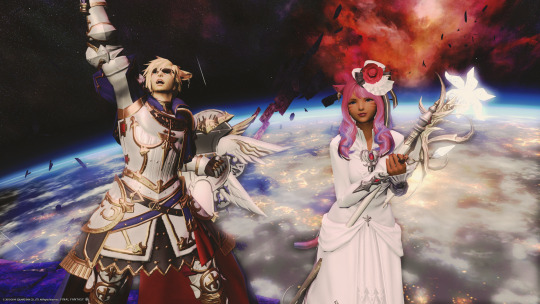
#goty 2019#ciconia when they cry#bloodstained#the touryst#a short hike#worldend syndrome#judgment#cadence of hyrule#spirit hunter death mark#sekiro#super kirby clash#shadowbringers
20 notes
·
View notes
Text
How to Play FF2 w/o Hitting Yourself
The game truly is balanced enough to facilitate you doing everything naturally after the beginning. You just have to do a little bit of work at the beginning and then let it flow like a river. Let your hair down, etc.
The best thing to do is to stop hitting yourself with one exception: when you get Minwu, cast Sap/Anti/Faze (same spell, just different name depending on the version) on Maria and Firion to increase their MP. Hitting yourself and leaving a rock on X or B is boring and it artificially inflates your play time. Don't do it. Leave everyone in the front row if you want their HP to increase that badly.
You don't even need to bother increasing MP with Guy; he's a hitter, he hits things. You can give him a spell if you'd like and increase his MP to 100 with Sap but I generally don't see a need to do it. His stats are not conducive to spellcasting to me, and I used to level up his MP and give him magic until I realized that his stats aren't for that at all. You CAN, however, give him buffs. Sometimes he’ll be a potion dispenser but there’s nothing wrong with giving him buffs to use at the start of battle.
So:
Firion: The most balanced guy. Magic stats are on par with physical stats so it's best to make him whatever you want. I go with making him like a paladin or something. I usually gave him swords and lances. The biggest risk to Firion, if you were raising him as a paladin in the NES version was that giving him a sword would destroy his Spirit stat (and his intelligence stat) since they lowered those stats by 50! Blood Sword lowers it by 100. That risk doesn't exist in the PS1 version and beyond, so it isn't problematic to do so. Giving him a lance in the NES version would lower it by 40 which isn't as bad as the 50 but it's still a dramatic drop.
Maria: The highest intelligence, the worst attack, the worst HP growth, the highest agility. She's the best out of the three suited to be a Black Mage-like character. I think it's kind of obvious as to where to take her here. I stuck her with Staves and Daggers. In the NES version, daggers and staves would give a -5 penalty to Intelligence/Spirit but that's WAY better than hte -70 that the bows take off. None of these penalties exist in the PS1 version and beyond, but I usually stuck to daggers and staves.
Guy: Highest strength, HP. Has high stamina. Has the lowest Agility stat (meaning that 95% of the time he'll take the last hit... and if you're a spellcaster you don't want super-low agility here). I guess if you wanted to give him spells, give him buffs that are unaffected by Spirit/Intelligence like Haste, Protect, Shell, etc. Some may not with that since he'd probably be the last character to complete an action during a round and you'd probably need the buff at the beginning of the round, but it's up to you. I usually stick him with Axes or barehanded with a few buffs.
Don't make everyone a jack of all trades. That's the worst thing you can do, since you'll be spending a ton of time levelling everything up instead of actually playing the game. And that's boring. Give everyone 1-2 weapons to concentrate on and that's it. No more otherwise you'll end up spending too much money on stuff you don't need and spending too much time levelling up weapons that you don't need to work with. I usually class everyone right at the beginning (ex: Firion is my paladin-like character, Maria's my Black Mage, and Guy is my monk/axe wielder/buffer; it's more effective that way, and it makes the game dramatically easier for me). Level up weapons to Lv 2 at the beginning. Some go to Lv 3 but you don't need to. If you're playing the GBA/PSP version, though, things will level up faster than expected, so I guess you'll have an easier time with it.
When you first start playing, just buy Fire/Ice (you could buy thunder but I don't see why you'd immediately need it since not a lot of enemies at the beginning are weak against it), Cure get them to Level 2-3. I've seen people say get them to level 3 and then progress, but I don't feel like it's necessary in the GBA/PSP versions of the game. So after you level up your spells a little bit at the beginning, just play the game normally. The game's balanced enough that you don't need to grind things out or hit yourself. After that you don't have to worry about stats at all because you've classed everyone and the game's balanced appropriately to keep everyone in check since you're accustomed to using everything in a class-based way. Buffs are your best friends for life, and Guy can be good at using them since buffs aren’t affected by the Spirit stat.
Play the Snowcraft minigame. There's a real good cheat out there on how to instawin every time and you'll get tons of money every time you play it (ex: play it once and write down where the cards are, when you're finished the game, say you want to play again, but then cancel the game. When it asks if you wanna quit, say no, and repeat cancel the game/no i don't want to quit options 31 times, and it'll reload the first game you play so you can redo the first board again). You can get some decent armour and some money from the game and it's easy enough to not have to do the cheat.
Could go to the swamp/peninsula of power near Finn and kill the enemies with magic to level some class-specific stuff up and get some cash. Use said cash to go to Mysidia to buy stuff. Then resume the game like normal. Don't have to hit yourself or grind anything after that. I personally hate doing it, but I know some people who can’t go bck from doing it.
And when all else fails just cast toad on everything after you get it, I guess.
I mean, SaGa/Legend of Legacy kinda uses the same levelling progression too, but with some tweaks, so that's why I'm used to it now. FF2's system is just a barebones version of it. I just hate grinding in any RPG since I feel like it wastes a lot of time, so I tried to make FF2 easier enough to prevent myself from doing it. Since it worked out for me and since it's worked out with other people, I guess the method works provided you aren't playing the NES version. FF2 is just one of those games that gets better on nearly every re-release.
1 note
·
View note
Text
Chrono Trigger 20th Anniversary Playthrough Part 3: “My Mommy’s Lunch” Edition
Last time, we encountered Marle-san and now we are tasked with showing her around the fairgrounds.

Guardia Millennial Fair

We ended up bringing the little girl’s cat back to her, but other than her calling it a “kitty” and Marle saying the Crono’s nice instead of “sweet”, there isn’t much difference here.
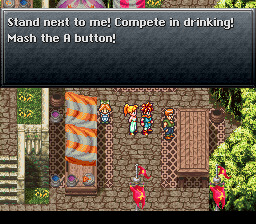
YEAH! We’re sticking it to “THE MAN” by calling it “DRINKING”. Take that, 1990s censors!!
Anyway, you win 5 points from this.

I can’t help but to feel like this dude has a Russian accent based on how he’s written here.
This textbox has a gigantic footnote in the script for some reason:

Ahem...
“The Japanese version's way of speaking about Crono makes him look like a passionate person rather than one who suffers from an inferiority complex.”
Huh? What was the Woolsey version, again?
“You’re awfully competitive, aren’t you, Crono?”
I feel like they’re gleaning WAY TOO MUCH out of that one!
Next we go to the dancing area.

God, I feel the same way about this translation! If I could, I would make the same expression!
This next box has a gigantic footnote, too. Like, two lines’ worth.

This NPC is classed as an OLD MAN. His mom is probably not with us anymore, unless he’s casually making fun of his wife.
But the footnote makes this one:
“I didn't realize at first that the bundle was his lunch in the NA version. I figured he was carrying his lunch with him, since he's obviously not sitting down. The old man with the lunch comically notes that his "mommy" made it for him. This is echoed when he complains and whines in the trial of Crono.”
Is this for real? He’s SO close to the lunch that even I, as a seven-year-old, was able to figure that out! I haven’t looked at the script for the trial yet, but good lord. Speaking of which, we’re trying hard NOT to get Crono convicted, so I’m not going to make him eat the lunch. The footnotes for eating the lunch consist of “lunch is bentou (kind of like a boxed lunch)”, and with respect to Marle calling Crono a pig: “Not literally pig, but you know what she means.” No, I don’t know what she means because these footnotes make me feel, as a reader, that you’re calling me an invalid incapable of parsing language!
Anyway, I’m going to do that thing that I do every playthrough: fight Gato.

I mean, GONZALES.

Gato Gonzalez’s Song


I need to check the Woolsey translation again...
They call me Gato
I have metal joints
Beat me up
And earn 15 Silver Points!
That Woolsey translation... makes sense to me? It can sorta go with the song, too? The literal translation doesn’t makes sense in English vocal music at all, because some of it doesn’t work with syllables unless you’re speaking Japanese (particularly the “point--s” bit having to come from “point-su”). Plus that first bit makes no sense. What about 15 points?!
If lost - Woolsey Translation:
You’re so weak
And I’m so strong
I punched your lights out
Now run along!
If lost - Retranslation:
You~’re weak
I~’m strong
So you’re
A ne~w~b!!
LMAO WHAT. *checks footnotes*
Internet jargon dictates that a 'newb' is simply 'new' and lacking experience, while a 'noob' or 'n00b' has... serious maturity issues, to put it nicely. HEEL PLZ!!!1!
lol what. I don’t even want to know. I give up. I already know this is crap.
If won - Woolsey translation:
I lost
You won
Here’s 15 points
Now wasn’t that fun?!
If won - Retranslation:

FIFTEEN POINT-SUUUUUUU
What a mess. And Gato’s name makes sense since the robot literally looks like a cat. I guess it wasn’t as obtuse since Gonzales is Spanish?
So I’m just going to do all the stuff I usually do.

That isn’t a sentence, Johnny Yong Bosch.

NO. Why would I sell it to a faker like YOU?!
I usually like taking Marle to see Crono’s Mom, but it’s special this time because the dialogue is probably going to be different.
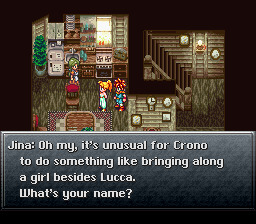
(For the record, the Woolsey translation implied that Crono doesn’t have that many close friends, and complements Marle’s prettiness. To be fair, not a lot of people -talk- about Crono at all, so the Woolsey translation sorta makes sense.)
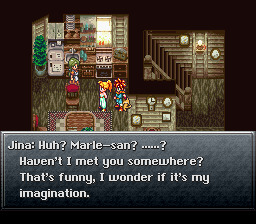
MARLE-SAAAAAAAAAAN!!!
I’m dying.
Additionally, we can totally rest while Marle’s there with us. She probably slept on the floor like Crono’s Mom does.

I felt like going to the woods, but then I realized that taking Marle to the castle wouldn’t matter since the dialogue isn’t that different. On the way, though, we learned Aura Whirl.

SORRY. I MEANT SPIN AURA.
Let’s go back to the festival.


I CANNOT... WHAT IS THIS.

The “Marle wants candy event” goes about the same way as it did in the original translation.
Stuff starts heating up during the invention unveiling, though!


It... it... sounds like the invention of the century, even tough the name sucks.
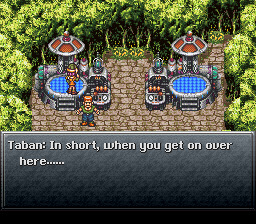
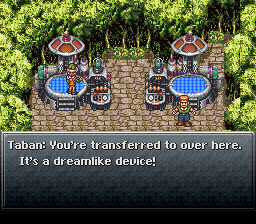
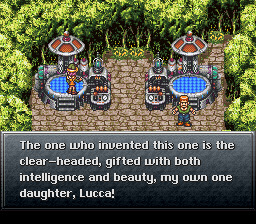
So in the English version, Taban struck me as treating Lucca like a daddy’s girl. The apple of her daddy’s eye, if you will.
The translation went like this:
Step right on up, any of you who have the time and the courage! Our «Super Dimension Warp» is the invention of the century! To use it, jump up here... and you'll get teleported here! It's the masterwork of my beautiful daughter, Lucca.
You could argue that the retranslation added unnecessary superfluous stuff (and I certainly think it did), but I guess it bashes it into your head that Lucca is definitely the apple of his eye?
Also: “DREAMLIKE DEVICE”!!!!!!
It’s worth noting that the NPC dialogue in this area is relegated to the device as opposed to Lucca’s ostracism. And it’s a bit odd, I guess? In both versions, you have NPCs in different areas who don’t speak very nicely about Lucca and her father at all. Even the one NPC from last time who said “THAT BLACKSMITH FATHER” seemed to imply that Lucca’s family isn’t well-liked due to being incredibly eccentric.
In some ways the “HER GLASSES ARE GIGANTIC” and “SHE CAN SEE THE BACKSIDE OF THE MOON WITH THOSE” comments in the Woolsey translation makes sense, but I guess it would also make sense that the only THREE people who even came to the demo would comment on the device only. So you’re either going with literal story or maybe minor character development. I liked the dialogue taking time to explain stuff about how the townspeople felt about Lucca and her family, so I’m not too enamoured with the retranslated dialogue.


Give me a break.
So, you don’t actually have to try the machine out yourself. You can just talk to everyone and the game will proceed to Marle trying the device out.

CRONO SO HAWT


A Strange Occurrence
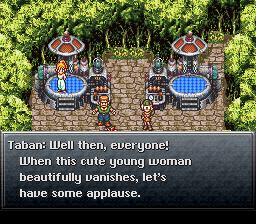
(The Woolsey translation says to applaud when she reappears, which makes more sense.)

He turned into that one dude from FF8!!!
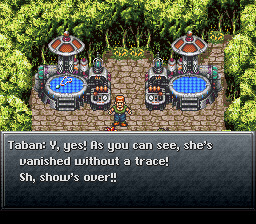
(In the original English version, Taban sounded more confident, professional, and in-charge. Now he’s reduced to whimpering like a sucker.)
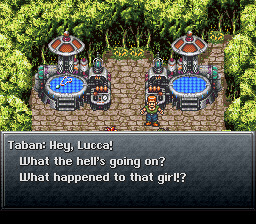
Yeah, what the hell, cuz we gotta make people swear like in the Original Japanese Version.

She’s channelling her Inner-Hojo in this version. In the original English version, she clearly says that it was the pendant that did it.

THERE ARE TOO MANY ELLIPSES IN THIS AND I AM GOING TO BANG MY HEAD AGAINST THE WALL. She sounds so unsure of herself, and not every scientist who knows their shit talks like this! Who wrote this?!
The original Woolsey version went:
She’s so familiar! I KNOW I’ve seen her somewhere...
And even if you try to retreat with Crono, the tone is so different. Is it because she’s a girl?
Original Woolsey Translation:
Crono! You brought her here, YOU get her back!
Retranslation:
H, hey, Crono! You brought that girl here! Where do you think you’re going!
The tone differences with just a few words and stuttering is amazing.
Let’s help her out.

Chrono Trigger
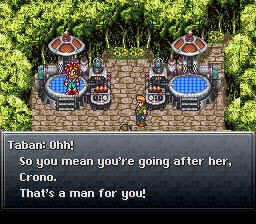
SO MANLY. Nothing about being a “fine lad” here!


Too many words!
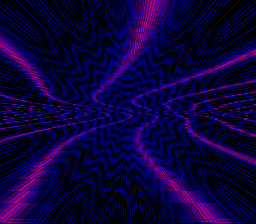
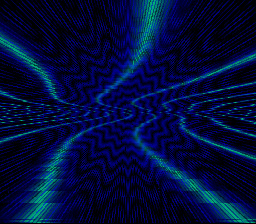
Shhhhhh, I think this screen is cool.

I have no idea where we are, but they use these assets a lot, so we’ll be seeing them again and again in different places.
We get ambushed, so we need to lay the smackdown on some...

Jarry#s? Dude no. They’re blue imps. They look like imps. Please.
????? is a pretty straightforward and linear map.
We also encounter a ...

Ma...ru... ma... I GIVE UP. It’s a Roundillo.
Let’s exit out to the World Map.

Wind Scene

So hazy. It’s like the Industrial Revolution up in here.
Where did we exit out from?

THE WHAT
You mean Truce Canyon. Let’s see what the original Japanese was...
トルース村の裏山
“Back Hills of Truce Village”.
Are you really going with that? Are you really? Someone help me. How do you get rid of a mountain to make a landscape that’s basically flat, anyway?
Where are we, really?
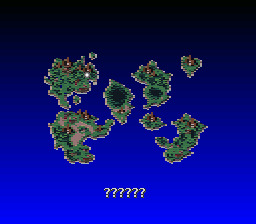

In fact, let’s check the chapter title, since that should be different in this translation. The original Woolsey translation title was “The Queen Returns”.
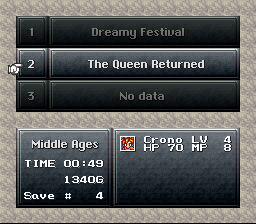
That seems okay. Let’s check the actual title in the retranslation script.
“The Queen who Returned“
I can only imagine the veins popping when they realized they couldn’t fit the whooooole title into the little box. :)
I think I’ve had enough for today. Next Time: What is a crepe?
4 notes
·
View notes
Text
Chrono Trigger 20th Anniversary Playthrough Part 2: The Swordsmith, Bosch
The feedback I’d gotten on the last entry was fairly positive, though a lot of people said to just play the game so: 1) I can get through it faster, and 2) just so I can point out the stupidest things. So I’m just going to point out some of the stupidest things instead of writing something equivalent to a walkthrough. Everyone’s played Chrono Trigger before, and since we’re playing this one straight and not making the story up as we go along like I did for Final Fantasy 4, I’ll just point out dumb stuff. Today on Chrono Trigger: I lied; we’re not going to the fair just yet.

What I usually like to do is go through the forest first. For kicks, and NPC conversation.

The Secret of the Forest
The forest dungeon is pretty straightforward. Chrono Trigger’s battles take place on the field as opposed to a separate screen (this also allows you to evade some battles if you don’t feel like fighting them, but I don’t run from battles cuz that’s dumb). You can position your attacks any way you want and some AoE attacks take advantage of that. After battle, you earn the usual XP and Gold, but you also earn “tech points”, which allow you to learn new skills for your allies. We’ll get to that in a minute, though.

Caps. is short for Capsule, which was replaced by “Tab” (presumably short for tablets) in the Woolsey translation. Now why couldn’t this just be “Power Cap.”, I don’t know. We will never know.

Battle 1
There isn’t much to say about battle other than you can gain a few quick levels here, though you don’t really need to do it. But you’re usually running through here to get somewhere else real quick so you might as well do some exploring.


Enemy names got retranslated to their original counterparts in Japanese.
Beetle (Woolsey Translation) became Scarabee sorry, Scarabée (スカラベー), with the liner notes in the translation script being “It's French, apparently.”
Hetake in the English version got changed to “Mosstie” (モスティ), which is pretty dumb considering that Hetake is a type of mushroom. I don’t know my mushrooms or anything, but neither make sense.
Oh, and...
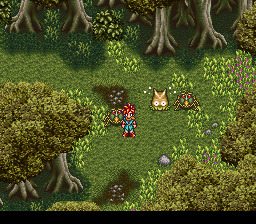
I’ve always liked dumb crap like this. Little skits between battles and not taking everything super-seriously makes for a lighter mood. I appreciate sillier stuff than melodrama and attention to little details like this makes me feel like some of the devs on the team wanted to have fun with the world as opposed to straight-up communicating a story.



We earned enough TP to learn Cyclone Spin Slash. I have also noticed that they changed the Lightning to Sky element (I don’t have anything against that change, actually; it’s more accurate and is easier to note that is it the opposite of Dark).
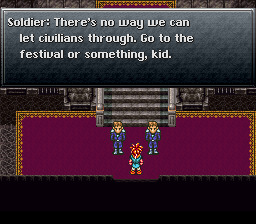
The dialogue in the castle is more or less the same. In fact, I think the retranslation is a bit better since it sounds tougher.
So let’s do what the soldier says and go to the fair.

Guardia Millennial Fair
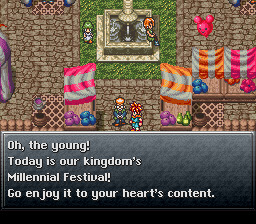
One, that first line is not necessary. Two, the “have fun!” line in the Woolsey translation was sufficient enough.

Well, we didn’t know that Taban was actually a blacksmith so this is nice. But the way this sentence is framed makes it seem like the girl hates blacksmiths! That blacksmith father!!! “with her father, who is a blacksmith” would’ve probably been a better way of describing Taban.

Guys, secret facts, but I’m pretty prostar at this. Though I think elaborating on the distance aspect in the Woolsey translations than the timing is more beneficial for people who haven’t played these types of games at a fair. That said, you’ll realize if you time your hit well after a few tries, the instructions make a whole lot of sense.
But the biggest reason why this entry exists is because of this:
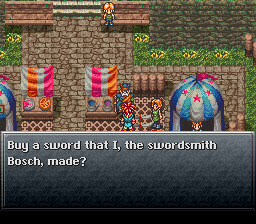
Bosch? Who the hell is Bosch?! What the crap is this?
No, I know his name in Japan is ボッシュ , but come on! Bible allusions aside, Melchior is just a better name and ties into the fact that he’s a special character later on. Naming him “Bosch” because it’s the Authentic Japanese Version is kind of a weird localization decision here. Really makes him sound like an ordinary man. And no, this isn’t a name selected to disguise himself.
As far as I am concerned, this man is an IMPOSTOR.

NO ONE IS GOING TO VISIT YOU. Someone throw this bro in jail!!
Additionally, all of the racers got retranslated to their original names and...

WHO ARE YOU PEOPLE!
(For reference: the original names were:
A. Steel Runner, B. Green Ambler, C. Catalack, D. G. I. Jogger. And they were way better.) Additionally, the translation notes have this written in them:
Seems to be some wordplay here, as the first part resembles a verb for 'abandon' or 'neglect' and also a term that refers to a sumo throw-out-of-ring move and to sudden reversals. I haven't paid much attention to the racers, but this one may tend to have come-from-behind wins.
Yeah, I think you’re thinking too hard.
Now I am fairly peculiar and I never visit the Tent of Horrors during the first part of the game, but I was a bit curious and...
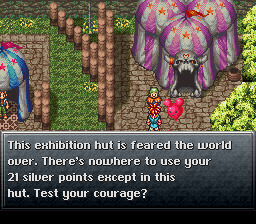

“THE EXHIBITION HUT”! A name that the retranslator came up with because “this place doesn’t have a name”. I have to say that “Tent of Horrors” is kinda clever, simply because of the whole “hut is feared the world over” thing, and probably because... Norstein Bekkler doesn’t seem to have a body. Speaking of which, Bekkeler is taken directly from ベッケラー, but the change is so small and reminiscent of something like Kurea that I don’t think it matters.
I did not bother to check in with any minigames in the hut because I’d rather do them later on.
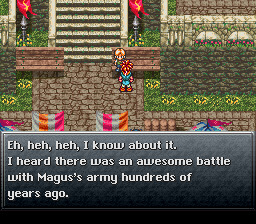
This is a really small thing out of context, but when you go back to the Woolsey script, the child’s character and tone changes dramatically. In the Woolsey script, the child says:
What’s the big deal? So what if we won a war against a Wizard hundreds of years ago?
...I suppose Woolsey wanted to make the child seem very insolent, given that all of the older folks seem to be grateful in terms of remembering the war. It’s a strange change, though. The child in the original version sounds like he was engaged with all of the tales of the war, and it makes sense that he’s attending the festival, so I am unsure as to why the tone change was added.
OK. First screen done. Let’s move on to meet Marle.

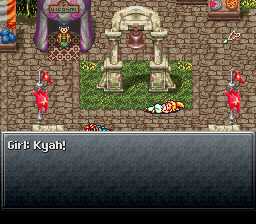
It is entirely possible to just go around Marle to get to other places on the screen, but let’s just bump into here anyway since the game won’t progress if we don’t. Also, in Woolsey’s translation she sounds more indignant (”Hey!!” instead of a “Kyah!!”).

I guess I took the screen after I made the box disappear, but the retranslated dialogue is:
I, I’m sorry! Are you okay?
While in English, she just gives us a straight “I’m so sorry! Are you Okay?” I think the stuttering is kind of funny since it doesn’t mesh with her character at all. She seems less apt to sound like that and more apt to say what she wants.


In fact, it kind of annoys me that the stuttering in the retranslated script carries on for several text boxes. The stuttering was rewritten to “Oh no!“ and “uh oh!” in the Woolsey edition.

Why is it important? I think it’s nice that the original translation slightly elaborated that it had sentimental value to her. Now if she had said “it’s very important to me”, then it would’ve made sense. Because there is no way that she could know that the pendant is actually VERY IMPORTANT at this stage in the game.
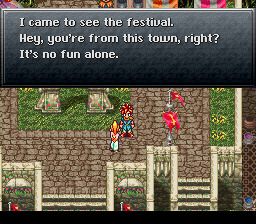
Anyway, Marle tells us her name, and we’re free to go with her.

But we aren’t going to go so quick. I have yet to play through this section because I have been busy!
By the way, if I had declined Marle’s offer to walk around with her, in the Japanese/retranslated version, she says:
No way! I thought you'd help out a frail little girl, please. <3
While in Woolsey’s version, it turned into:
Oh, come on! I don't know anyone around here! Please!
Woolsey’s version plays more to Marle’s tomboyishness, while the original version makes you want to pity her, plays more to her maybe disguising herself, or maybe she has a crush on him, I don’t know. Either way, the original verison is pretty weird for Marle to say since everyone has been talking about how much of a tomboy she is or how much of a free spirit she is. It sounds a little out of bounds for her to be playing around with her princess act. Oh well.
So next time, we’re hopefully going to be warped back in time after we smack Gato around for a bit.
3 notes
·
View notes
Text
Chrono Trigger 20th Anniversary Playthrough: That’s the feeling I’m getting.
This year marks Chrono Trigger’s 20th anniversary. I don’t really think I need to explain why I like Chrono Trigger, or why it is a fairly significant game historically-speaking. However, from the posts I have written on NeoGAF on the subject:
I think Chrono Trigger is a beautiful game, and reading about how it was conceived right down to how the developers felt about it afterwards makes me feel like the game had a lot of thought and attention to detail added to it in order to make the player feel like it was truly the realization of the Dream Team’s… dream.
I can easily recommend Chrono Trigger to both new RPG players and veterans. The background art, by Yasuyuki Honne, is incredibly appealing because of its attention to detail and beautiful use of colour (something that will become recognizable in many Monolith Soft titles and Chrono Cross). The Toriyama art, is essentially an excuse for—and this is truly the case, actually—Sakaguchi and co. to play with the whimsical nature of Toriyama’s universe, with characters that stand out, and still look rather unique in terms of the colour palettes used for them, the designs, and the characters’ identities (ex: humans, robots, animals, etc). The spritework is detailed, the animations are so detailed and wonderful to watch in action. The Mitsuda/Uematsu/Matsueda soundtrack demonstrates so much compositional synergy, catchiness and beauty throughout. And the story is just utterly delightful and tragic at the same time. Everyone who worked on this game should be proud.
But the battle system is truly what shines in this game. Dubbed “ATB 2.0”, Hiroyuki Ito & co. amped up the familiar ATB system found in previous Final Fantasy games (starting with FFIV) and developed it into a system that takes into account party synergy, combo attacks, timing (helping make the speed stat being one of the most important stats in the game rather than sheer power), the importance of healing, both difficulty and ease, and enemy positioning for linear, group or single attacks. It’s a beautiful system. There is never any “right” or “wrong” party because each party member brings their own special abilities (everyone but Magus has a healing spell, for instance), and players can customize their parties for efficiency, favouritism, etc.
The beauty of Chrono Trigger truly lies in its accessibility to newcomers and veterans alike. People can play through it without any problems to get through the story, but veterans can play through it to amp up the difficulty to test themselves by using parties that aren’t tailored to speed (because truly, speed is an asset in any game that uses ATB to an extent).
It’s one of those games that you would consider as “timeless”; at least, that’s my opinion. Others certainly disagree, but many would agree that if you are remotely interested in the genre, Chrono Trigger is a must-play for narrative or even systems purposes.
To mark this year’s 20th anniversary, I would like to replay Chrono Trigger. I haven’t had the time to replay it in a few years and I certainly wouldn’t be opposed to doing a playthrough again. And to be honest, I think I’ll find this fairly therapeutic given my recent apathy towards newer games in general.
I’m doing this with a twist, however. I have decided to play the retranslated version of Chrono Trigger. Yep, that one. The one with the completely literal translation where Marle Marledia-sama asks for a crepe. It should be fun.
Or kill me inside, I don’t know yet.
So, let’s get started!
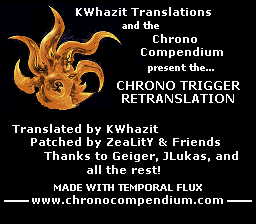
This translation was done by Chrono Compendium. It’s a cool site to surf when you want to learn more about CT’s development or find interviews for the game. Some of the essays on speculative matters are decent reads, too.
But, uh, the Chrono Trigger retranslation is something else, guys. Just… you’ll see. Going to make a point that this playthrough is moreso to showcase the translation than showcase menus or glitches or statistics. I wanted something to laugh it while playing through CT again, and I hope people get something out of this too, even if it isn’t going to be based too much around mechanics.
Just a little note on the music: I will be using the SNES version of the music in links, but the PSX version of the soundtrack and the DS version of the soundtrack are a little different in terms of quality. At this stage, the DS version is the best version overall, while the PSX version is the worst. This is evidenced in multiple versions of Undersea Palace, but I’ll talk about that much later on.

A Premonition
When I was a kid, I found Chrono Trigger’s title screen to be a bit unremarkable. I still kind of do, but I get the minimalism behind it, and the C in Chrono Trigger is still cool.
There’s also a Short Demo that plays if you leave the game on the title screen for too long. It’s really neat and it showcases a lot of stuff about the game like the maps, the areas, the enemies, how the battle system is oriented, etc.
The PSX/DS versions of the game has this cutscene instead. It was super-cool to see when I was a kid since you never got to see a lot of the art in motion before.
So anyway, Chrono Trigger! Hit any button.

You are brought to screens where you can pick battle modes, and a screen where you can pick Crono’s name. You can either choose to Wait (time stops when you’re choosing options) or make it Active (constantly flowing, even when you’re choosing options). I’ll be choosing Active because I’m not a scrub.

I am also keeping Crono’s name and everyone else’s default name. It’s going to be funnier later on. Sorta thinking that the team wanted to get the Chrono name in there, but just couldn’t do it.


The game starts, and we’re greeted with seagulls flying over a bay, and a balloon cannon or balloon fireworks going off above what looks like to be a community fair. It’s at this point that I’d like to mention that I really like Chrono Trigger’s sound effects. The balloon cannon is super-loud and it’s a neat sound effect, but a lot of the battle sound effects are very satisfying. A lot of the audio design in the game is super-cool.

Morning Sunlight


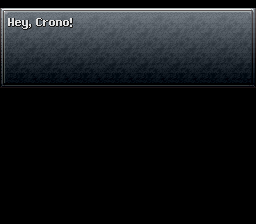
We’re greeted with these three screens (sorry, Tumblr doesn’t like formatting multiple pictures on a line, so we’ll have to deal with it). It’s also at this point that I’d like to mention that I really love クロノったら getting localized to “Good morning, Crono!” It bums me out that the DS version didn’t use it, despite being added to promotional material. I knew it wasn’t going to be used here just because of the nature of this translation, too. But it feels more organic and paints Gina Jina to be more of a mother figure than her razzing Crono a lot like she does in the DS version and in this translation.
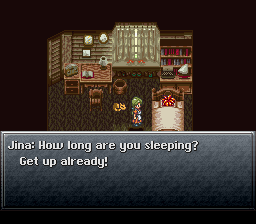


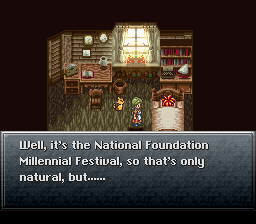

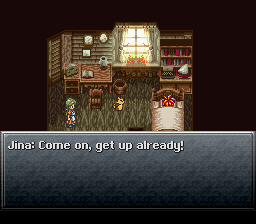
Even this dialogue is different. Where Gina used to be a bit nicer to Crono by saying something along the lines of “Come on, sleepyhead! Get up”, she’s a bit harsher over here. In fact, this dialogue doesn’t necessarily speak about just Gina, but also Crono. The dialogue in the Woolsey translation paints Crono as just lazy. The retranslation sort of doesn’t offer much, and if it does, it probably that he’s more impressionable (ex: don’t party too much when you’re in the moment, etc). It’s semi-understandable because Woolsey’s translation was in an era where games were moreso marketed towards children and young adults, so a line of dialogue representing drinking too much would probably not reflect well.

Peaceful Days
Anyway, the fun starts here:

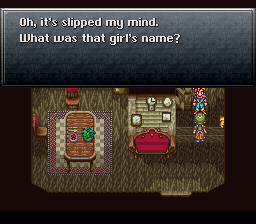

“YOUR CHILDHOOD FRIEND WHOSE NAME I DO NOT REMEMBER. YOU KNOW, THE ONE WE’VE KNOWN FOR YEARS.” Woolsey’s translation implied that Gina didn’t know who Lucca was, or that Crono met her fairly recently, so it makes sense as a prompt for a name change. Saying that Lucca is Crono’s childhood friend and not remembering who she is makes little sense considering that Gina doesn’t seem to have memory/recall problems! Woolsey’s translation also has a slight connotation where… Gina seems nicer? Her lines of dialogue in that version is peppered with “dears” or ameliorated words or speech mannerisms.
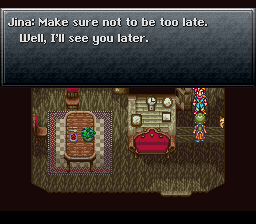
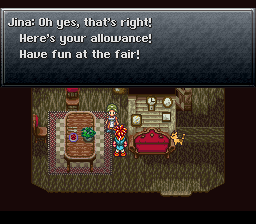
Anyway, she gives you cash (200G) to spend. We’re not going to use any of that but it’s nice to have.
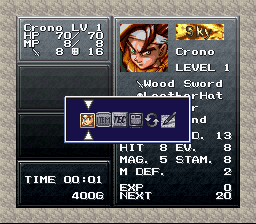

This is the menu. The all-familiar menu. The menu’s colour can be changed to different colours (I like to use blue), and you can change the battle speed and whether or not you want the battles to be classed as Active or Wait at any time. We’ve all played FF and CT, we should know that. Crono ends up being one of the fastest people in the entire game. I used to have conversations with another NeoGAF poster about party builds and he used to argue that giving Speed Tabs to the faster folks like Crono to get their speed up to ** is more efficient than giving Speed Tabs to slower members. I used to disagree, and I still disagree depending on the type of playthrough that you’re doing, but in the event of a speedrun, it’s definitely viable to give Speed Tabs to the faster party members. So guess what? We’re doing that. Crono is one of the most overpowered members of the group and giving him the proper equipment and enhancing his stats will make you better off.


This is the world map. Crono makes funny animations telling you to get a move-on if you linger too long. We can also zoom out to see the entire world, and it’s something we’re going to do per-era. I’ll be honest: the primary reason I knew about Pangaea when I was 7 was legitimately because of Chrono Trigger. It led me to ask questions as to whether or not our real continents can do that. And quick trips to the library and reading books about Continental Drift told me that it could! Super-cool!

Different chapters also have different names. We’re in Chapter 1. The more “literal” translation of the chapter title is like… “Setting out! The Dreamy Millennial Festival!” like an anime title. The retranslation can’t fit all of that in with the font it uses, so we get “Dreamy Festival” instead. Woolsey’s translation simply goes with “The Millennial Fair”.
The real meat of the retranslation is the NPC talk. A lot of us know and make fun of the crepe line, but the NPCs in this game are so wordy that it’s just… oh my god, you have to see this.



You need lotsa boxes of dialogue for this. Where the first translation only gives us two boxes of dialogue (“It’s hard to believe that Guardia is 1000 years old, and our King is the 33rd descendant to the throne! But how can he rule his own kingdom when he can’t even control his own daughter?!”), this translation uses the original three boxes of dialogue with a TON of words in it. Some of the dialogue is superfluous whereas the original just gets to the point and slightly makes a political message. Additionally “the current King Guardia, our king now in other words, is the 33rd” has way too many words and could have been trimmed.
This is the point where some folks should probably learn the difference between a translation and a localization. Where this patch was created to add details that were missed in the original translation and to fight the cruel 1990s censorship, it also adds stuff that we just don’t need, or stuff that simply doesn’t work in English at all. I don’t get the rationale.
And then we have this:
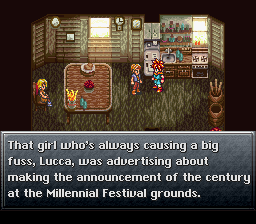
…which was shortened to, “That brat, Lucca, said she’s made the discovery of a lifetime.” One is slightly more polite while the other is brash. I can go either way on this one, but the retranslation is a little wordy, even if the tone is fine.
But the best part of this retranslation so far is this:
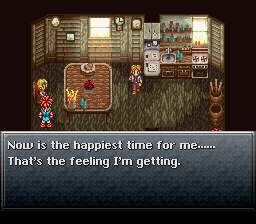
WHAT????
This was translated to, “I’m so happy I could scream!” which makes sense. The Japanese translation is more reserved in its emotions, but that last line is pathetic. I laughed for a while after reading that one!
I visited the item shop in Truce, and the Poyozo Doll says some slightly different stuff. The first English translation was basically “Visit our stall in Leene Square!” vs “Currently at a stall in Leene Square!” in this version. Both lines have different connotations. “Currently at a stall” doesn’t necessarily imply that you’re selling something or that it’s your own stall, while the former notifies customers that they should shop at the fair instead.
Let’s go to the Inn. The Inn costs 10G for one night and we don’t need to stay there. Plus we can sleep for free at Crono’s (also it’s no longer “How about a snooze?”; it’s “Rest?” which is okay).
Anyway, back to the inn:
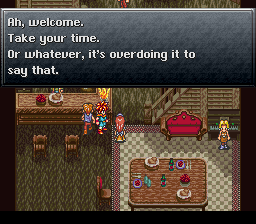
Huh? I don’t understand this one. Overdoing what? What are you talking about? Is this a crazy person?! (Woolsey translation: “Come on in! Take your bloody time…! I’d rather serve you than go to the fair, anyway…” This mostly implies that she’s pissed that she has to work on a national holiday which sucks. The retranslation seems to imply the same thing, but the wording is so oddball that it ends up making less sense.)

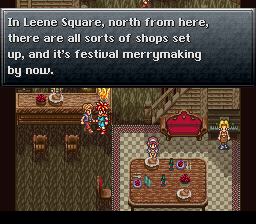
This one makes no sense, either!
The festival’s what since this year? And I think it’s missing a comma. The SNES translation is: “Well get going, then!! You’ll have to wait a thousand years for another Millennial Fair!” I like the SNES translation’s version simply because it turns into a small joke about the game since this limitation won’t exist for Crono shortly. In turn, it becomes slightly darker reasons we’ll find out in subsequent updates. The second dialogue box in the retranslation sounds like it’s word vomit.
If we answer that we have been to the fair, he’ll say:
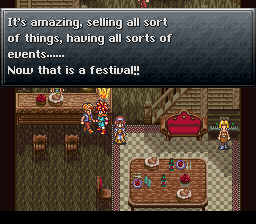
…I don’t know anymore, you guys. All sort of things, all sorts of events! Sounds like a drunken ol’ good time.
I decided not to buy the young woman a drink to play a song that we’ll hear soon anyway, because we need ALL DA Gs.
Earthquake Guy in the inn is more or less the same. In the Woolsey translation, if you answer that you don’t remember the earthquake, he calls you an airhead. In the retranslation, he simply says that you’re a carefree kid. Airhead reference is probably better because I can’t even miss a 4.0 earthquake over here.
FYI, the earthquake was actually an important event in prerelease since it destroyed Zenan Bridge. In 600 AD, Zenan Bridge is destroyed by Guardia troops to prevent Magus’s troops from attacking any further. This is why the reference to it being “an omen” is made in the retranslation. In Woolsey’s translation, this context wasn’t there, so it makes reference to “the big one!” instead. Since Zenan Bridge is left intact in the official release, the ominous suggestion makes little sense and was probably left in by accident.
Oh, and FYI…
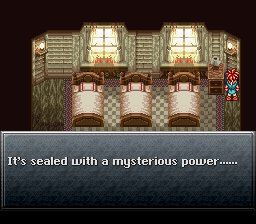
Two sets of ellipses is common for the Japanese version of this game, so the retranslation has left this intact. LOL.
If we check out the Mayor’s House, it’s a bit of a mess. The dialogue in this entire area is wonky and wordy as hell. You’ll know that if you talk to the first NPC you see:

ADVENTURING KNOW-HOW
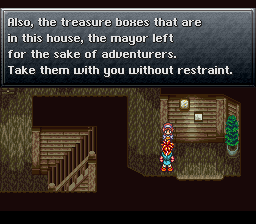
TAKE THEM WITH YOU WITHOUT RESTRAINT.
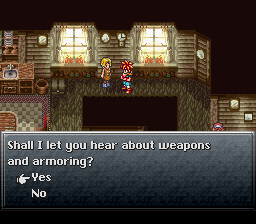
Like, stepping into the Truce Mayor’s Residence in this version is like… it’s out of hell. That’s what it is. It’s hell. That armouring quote is out of hell. It’s a general word to describe armour in general, but no one cares. Armour works, even if literal meaning is to describe body armour.
Armouring Lady [Woolsey Translation]: Weapons include swords, bows, and guns. Some weapons can only be used by specific party members. You’ll find a variety of armour for the head and body. Finally, there are numerous accessories with unique properties and effects. As you gain Power, swords will inflict greater damage. Bows and guns get more powerful as your Hit rate increases.
Total text boxes: 5
Armouring Lady [Retranslation]: We call them all weapons, but there are a variety of them. Like katanas, bows, and pistols. But everyone has their strengths and weaknesses, and can’t use any weapons but those suited to them. There are three types to armouring. The ones you put on your head, the ones you put on your body, and accessories. You can’t equip armouring either except for the ones suited to your body. Next, in accessories, many of them have special powers, so you should try checking out a variety of them. Also, for katanas, if your power increases, your attack power also increases, but for bows and pistols, it’s a LITTLE different. What you need is hit rate; the more increases, the more powerful damage you’ll be able to inflict.
Total text boxes: 6
ARMOURING aside, I think it’s obvious that I think the retranslation is unnecessarily wordy (and I think there’s a run-on sentence in there). Some of the sentences could have been shortened and/or merged.
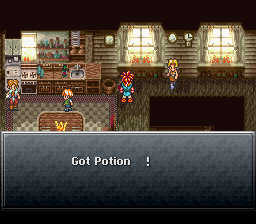
And treasure boxes have a looooong space between the acquired item and the exclamation mark for character limit reasons. It doesn’t look very nice!
Save Spot Faker Dude is also wordy:
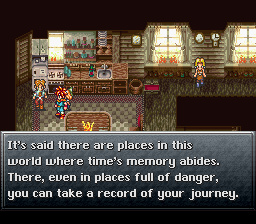
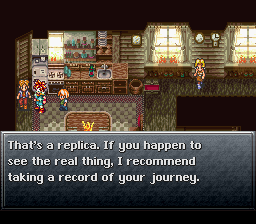

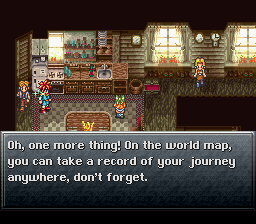
(original translation: “Scattered throughout this world are places where you can save your game. Save whenever you can, especially in unfamiliar or dangerous areas! That’s just a replica. Record your journey whenever you find the real McCoy! You’ll find more of them in riskier areas. Also, remember that you can log in anywhere on the World Map!”
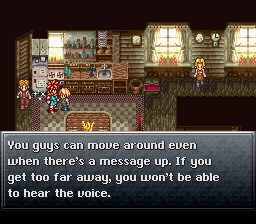
I am reading, not hearing voices.
Shelter Lady and Little Girl Who Tells You About The Y-Button are also more or less the same.
Skill Soldier is slightly different. Since his dialogue is gigantic and better accompanied with images, I’ll just link these because I think people will know what I mean by it being incredibly wordy. It’s ridiculous, and some parts of it make little sense in an English context.

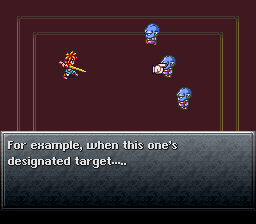
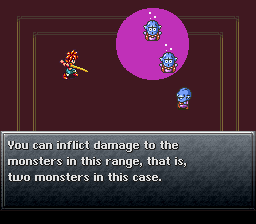

I don’t know who could look at that and think it’s golden in English.
Talking to the mayor is more or less the same outside of the last line: “Ho ho ho. Zealous youngster! All right, a present from me. I hope you use this to ready yourself with some equipment or the like.” The last sentence isn’t in the Woolsey version, and it’s a bit unnecessary.
The Status Effect Lady is also a bit wordy, but the lines are more or less similar to what’s in the Woolsey translation. Additionally, “Revives” are called “Athena’s Waters” in this version which isn’t much of a surprise.
Retreat/Statistics Dude is wordy, but the same material is conveyed in both translations. Though this part is different:

In Woolsey’s translation, those numbers became 10 and 10%.
That said, Chrono Trigger explains what stats are and how they’re used pretty well. Not a lot of games seems to go out of their way to do that for a lot of people (and thus a lot of people don’t seem to know what stats really do, so I liked this as a kid and I still like it now. It tells you what weapons need hit % more than attack power, what a number translates to in terms of a percentage, etc.
Let’s leave the Mayor’s House and go to Lucca’s place. Lucca isn’t home, but her mom is.


If what’s Lucca? Why does every line pertaining to Lucca in this translation make no sense, whatsoever? The last line is missing in the Woolsey translation since I suppose that it made it sound like Lara didn’t care for what Lucca did much.

This is Lucca’s room. I can empathise with all the books on the floor. I know that way of life very well.
Anyway, all of Crono’s neighbours are assholes, so let’s move on to another town. Who wants to celebrate with these bozos?

Green Memories
I told you that we can listen to this music for free at any time. Let’s head to Zenan Bridge since there’s some NPC talk over there.

Zenan Bridge has a very nice background, even if the foreground isn’t much to talk about. A lot of people who did the art for this game went on to do art for Chrono Cross, and Monolithsoft altogether.
Anyhow, we are here for the NPCs:
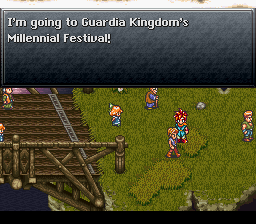


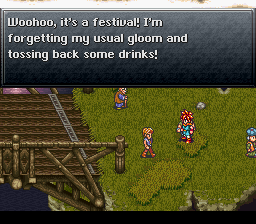

I keep getting the feeling that the main reason for the retranslation in general is to be able to re-add every conversation that related to drinking back into the game and “stick it to the man”, so to speak. Every time I go to a bar in this retranslation or if I talk to a lot of the NPCs, I feel like nods to drinking are incredibly deliberate even if they were supposed to be there originally. Maybe it’s because it’s an odd tone shift to me. CT was a game that didn’t give a fuck and felt like a carefree type of game, so I guess the deliberate nods to drinking is weird.
And I’m saying that and you guys know that I drink!
I guess the four NPCs that stand out are:
Old man [Woolsey Translation]: “Always wanted to go to a 1000th anniversary!” (I think this is simple and dumb enough to fly well.)
Little Girl [Woolsey Translation]: “Yea! A festival! Let’s get crazy!” (Girl sounds like she’s drunk off her rocker and she’s a kid. I’d go with the retranslation on this one.)
Merchant [Woolsey Translation]: “I’m opening a stall at the fairgrounds. Why don’t you drop by?!” (The retranslation makes it sound like he’s applying for a permit to do it. This other translation makes it sound like he’s already done it and is going to open one now.)
Man [Woolsey Translation]: “All right, everyone! Let’s have some fun!” (Drinking is edited out. Retranslation sounds like something I’d say, so I can’t be against it.)
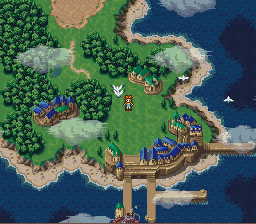
We are going to Porre. It’s a small town, about the size of Truce (the town part of it, anyway). The citizens don’t look much different from Truce’s, either.

House-sitting. It’s called “house-sitting”. In the Woolsey translation, he sounded like he volunteered for it, but in this version it seems like he doesn’t want to do it. I’d defer to the retranslation on this one since it sounds like everyone who is anyone except for Porre’s mayor is going.

Hell no! I can stay at my house for FREE.
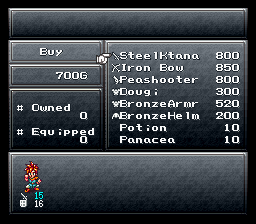
I ain’t buyin’ anything. It’s too expensive and we can get weapons for free later on. Also, I miss the word “Tonic”. It always sounded like Crono had a drinking problem and drank love tonics, and it was funny. Trying to figure out what a Dougi is, but I’m going to assume that it’s the Karate Gi. Some of these item names are really long, too. They don’t look that great, and I think we might have been slightly better off with the shorter names since the icons speak for themselves here.

Where’s the JERKY?! I always thought that as stupidly funny. Just like the soda. Laaaame.


Whenever I read a dialogue box in this retranslation like this, I always feel like we’re standing here for 100 years every time I see 2 sets of ellipses.
Additionally, the options for the Poyozo Piano Player are shortened in this retranslation since “Play a sad one, Joe!” was just a Woolsey addition.
Let’s go to the mayor’s house.
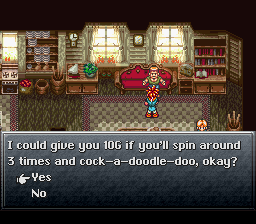
Let’s answer no. (Also, this would explain the spinning.)
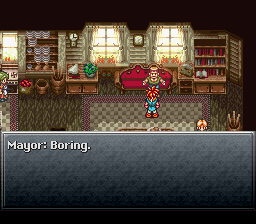
The Woolsey translation slightly changed this to “Bo-oring” as though he were saying it in a sing-song way. I’d agree with that one too, since the mayor seems like a carefree jackass.
(I still answered “yes” the second time because I love money. The dialogue, while different, is thematically the same.)
There are two bad pieces of dialogue in this house. The first comes from the mayor’s wife:

Moving away isn’t… it’s just… it’s dumb. Okay? It’s dumb. Moving away where? The better phrase to use is “slipping away”, and even then you need a “from ____” after that.
The second piece of dialogue comes from the mayor’s youngest daughter:

…I don’t know where to begin with that one. Not every child has a lisp, and while I get where they were coming from in trying to make this sound super-cute, it kinda looks a bit dumb.
I always like taking the ferry at this point, and since there’s some conversation in the ferry area, let’s check it out.
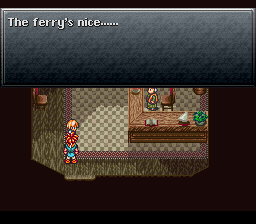
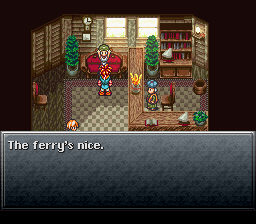
It’s like that one part in FF7 where the kid repeated everything his older sister said. It’s actually not like this in the Woolsey translation since the two say different things, yet talk about the ferry favourably. Here, they sound like they’re part of some sort of Ferry Cult.
…shit, there is a Ferry Cult, isn’t there?!

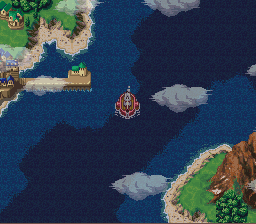
Here we discover that some of the landmasses aren’t that far from each other, and that there’s a house in the middle of nowhere.
The NPCs here are better than the ones in Porre.
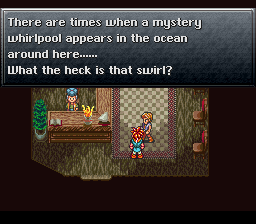
This is more or less the same. But the answer is totally because there are different water levels that cause it. SCIENCE.
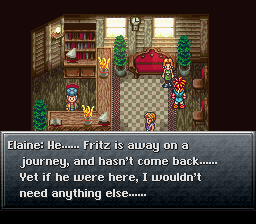
Elaine’s dialogue in this version is a bit off, since it sounds like she’s a whimpering sack who can’t function without him. The Woolsey translation is more like: “If only Fritz would return. I would ask for nothing more! I guess he’s forgotten me.”
I think that’ll be all for today. Next time (if there is a next time): “We will totally get to the Millennial Fair Factory soon enough!”
I don’t know what I’m going to do with this playthrough yet. I think I might simply highlight the most outrageous lines of dialogue and talk about why they’re so weird. I’d really like to spend a bit more time talking about the game since I genuinely like talking about the game part of the game in any playthrough. It should be cool. I’m not sure if I’ll continue being in-depth because I have some stuff to do lately, but I’d like to point a few things out from time to time!
I would love feedback, though. If people like me explaining mechanics and pointing funny stuff out way more like I did in my FF4 playthrough, I’d be up for that. I haven’t done the the 600 AD section yet, so if I must make changes, that’s where I will implement them. Thanks for reading~
4 notes
·
View notes
Text
Paper Mario: Sticker Star Impressions | Incredibly Flat and Flimsy Paper
Originally written June 2013.
I started with Paper Mario incredibly late. I didn’t play the first entry on the Nintendo 64 until my late teens when I’d luckily stumbled on a copy for $10. I didn’t have a GameCube, so I played The Thousand-Year Door after I’d gotten my Wii. Simply put, I’m not really a Mario fan because I hadn’t had very much exposure to the series as a preteen and thereafter (for example, I’d only played Super Mario 64 on this year). I liked the NES and SNES games when I was a child, yes, but not really the games afterwards due to underexposure.
With that said, because my genre of choice is RPGs, the Mario RPGs should appeal to me. I don’t like Super Mario RPG, and I think it has aged poorly. Both the Paper Mario games and the Mario & Luigi games are markedly better than their predecessor, and narratively, visually, and mechanically, they’re both incredibly stellar series. While the Mario & Luigi games are generally consistent, Paper Mario seems to have gotten stuck in a rut after the highs of TTYD and the lows of Super Paper Mario. Unfortunately, the rut continues with Paper Mario: Sticker Star. With that said, I’m not necessarily comparing the game with its predecessors, but rather, I’m evaluating it as an RPG in general. I’m all for RPGs taking a fresh approach and using another formula as opposed to using the same thing time and time again. Provided it has good execution of that formula.
Essentially, Paper Mario: Sticker Star does not seem like it is purely an RPG. It is more of a platformer with very loose RPG elements, if we can call them those (ie: battles, battles on a separate screen, hit points, money after battle, some skills). It is not the game I had wanted. Sticker Star eliminates the drive for the player to stick with the game in general. Without the base D&D-esque elements, there is little desire for the player to be enticed with respect to their stats on a level up, which skills they will learn, or which stat they should allocate extra points into for statistical changes. Personally, I get a kick out of that sort of thing, and since this game had not provided that satisfaction, it immediately fell short of expectations. There is no means to manage the character which you are role-playing as other than choosing which/how many abilities he uses or keeping his HP up, nor is there any sort of quasi-micromanagement in terms of equipping armours or weaponry. You are no longer “role-playing”, but rather you are simply controlling a character’s movement like a platformer. The role-playing involvement is of little-to-no consequence. You increase your HP by finding health upgrades on the field. You find different skills (not “new skills”) littered throughout the environment with little regard to field cohesiveness and background cohesiveness.
With respect to skills, I truly do find it irksome that there is legitimately a lack of significant growth to the skills you acquire. By significance, I mean “meaningful”. For example, you would find the worn-out jump in the first town in addition to the regular jump. But then you would also find the Shiny Jump, the Iron Jump, and the Hopslipper right after that in World 1-1/1-2. Regardless of the fact that the Iron Jump and Hopslipper are their own categories, why would you give the player mid-level and stat effect-esque jump right off of the bat instead of introducing them in terms of character growth or a compelling fashion to make the player experiment with it? Not to mention that the Jump and Hopslipper aren’t necessarily that different in terms of damage-dealing outside of their execution (ex: max 5 vs max 10 (and this one is halved)). This isn’t necessarily strange balancing, but odd design which leads to these attacks feeling somewhat insignificant to the player. Especially when you can use these stickers only once per battle. However, I completely understand that a lot of people would find this issue nitpicky, but in terms of skill progression and growth, the lack thereof bothers me.
Regarding battles, while the structure, pace and design of the battles seem like a good idea on paper, in terms of execution they are a bit lacking. In battle, you may use one or more stickers per round. These stickers may only be used one time only. Post-combat, you are only rewarded with money, which are used for goods and services more stickers. In turn, you fight more enemies in order to be rewarded with more coins in order to purchase more skills for your player character to use. This is just strange design in an RPG because there is very little compelling need to attack enemies. There is no need for your character himself to participate in battles because it doesn’t factor into your character’s experience and increasing hardiness for battle. Without having to manage equipment, skills, BP, FP, etc. the combat becomes incredibly rote and unrewarding.
Due to not having many RPG basics to manage at all, this effectively becomes a platformer with the RPG elements of encounters and purchases. Even then, the player is not required to partake in these RPG elements unless desired. In particular, the game is designed as a slower-paced platformer with purchasable power-ups to use within battles that act as slower-paced platforming experiences with timed-button presses. There is little challenge to this system, and your character’s stats matter very little (in fact, there aren’t really apparent stats outside of the base power of the stickers, which I legitimately find disappointing because I like doing the math for things like this).
The puzzle-esque boss battles are actually not too bad, and the final boss wasn’t bad, either. I just wish more fights in the game were like the final boss as opposed to being the way they were. I do feel disappointed that enemy variety was lacking, but this seems to adhere to the concept Miyamoto had of only using characters that are part of the platformer games as opposed to original concepts to drive an RPG forward. The Mario series has a plethora of characters to utilize, and thus it’s a perfectly fine idea to stick with these characters… provided that they are utilized properly. I’m a little surprised with the poor execution here, because the writing can definitely carry these heroes and villains forward. Instead, we get a sub-par drive to defend the good (all those toads who are almost indistinguishable) and fight enemies (who seem to have little personality).
For those who find narratives compelling, Sticker Star applies some lacklustre storytelling, or rather, a bare-minimum with respect to the narrative. Outside of gathering comet fragments and stopping Bowser, there is little drive to push you further towards your goal. There is little tension-building and tension-release. This is facilitated via the lack of multiple towns, the lack of a variety of NPCs, shallow settings, and just having a paper-thin objective for the player to aspire towards. The problem here is that the world itself consists of setpieces that Mario and his adversaries must dash around in. None of the areas feel significant to the plot, not enough for the player to learn much about them. The lack of characters leads to a lack of character development. No one necessarily develops because there generally isn’t anyone to develop. Mario is a silent character, and in typical silent character fashion, his emotions or actions are played off of another character. This is why partner characters, other party members, or NPCs in general make silent protagonists work extremely well. Kersti doesn’t seem to cut it, nor does she seem to work well with Mario in general. This, in turn, makes the atmosphere of the game rather weak.
With respect to the dialogue, this is executed quite well. I generally love the PM/M&L localizations. The humour and wit always shine through. I just wish dialogue were more abundant.
Let’s balance this out with something I did like: The visuals. I can’t talk about 3D because due to my eyesight, I cannot see 3D very well (or even at all in some circumstances). Outside of that, the visuals are rather spectacular. The gyro control in this game for the shiny stickers is quite a nice touch. All of the field and battle assets are very nice to look at, and the UI looks very lovely. The animations (ex: knock around animations, scene animations, etc.) look great, and the framerate is rather consistent.
The music is also great. I get the feeling that it’s by Masanori Adachi and Kiyoshi Hazemoto. It sounds like their style. I appreciate the bass and brass instruments throughout the entire soundtrack, and the melodic nature of the soundtrack was a bit of a drive to keep me going. Music like Boo Night Fever, the second phase of the final boss, and the credits theme were peppered with the right amount of percussion (and right mixing on the percussion), elegant and melodic bass, and beautiful brass.
Thus… Paper Mario: Sticker Star is more of a spectacle-based and slower-paced platformer with semi-RPG elements than a full-blown RPG. While it has its ups with the presentation and dialogue, that is not enough to save it in my eyes. It definitely isn’t my cup of tea at all.
Am I faulting the developers for experimenting? Hell no; I love Breath of Fire: Dragon Quarter, don’t I? Am I faulting the execution? Yes. Some of this stuff is okay to good ideas on paper (though to be fair, I was initially skeptical when I’d heard about the game’s mechanics in the first place), but in terms of execution, it makes a lot of missteps in terms of essentially following the basics of the basics of RPG construction in D&D roots, inadequate tension-building and release, making battles essentially meaningless, cultivating a dull atmosphere, reducing characterization to a nonfactor, lacklustre character writing, reducing the amount of player agency with respect to character customization, and essentially making its world structure rather boring due to a lack of worldbuilding and adequate NPC characters to carry it. This game simply lives out its welcome before it has a decent chance of sinking in and finding its pace.
It’s quite a shame, because I generally love IntSys’s work. They know exactly what decent balancing, stat factors, and game mechanics work and what don’t. It’s disappointing that they did not use all of the knowledge they possessed with respect to these qualities in full-force in a Mario RPG.
Pros:
+ The final boss was good! I love how the game gave me the game I’d wanted at the very end of the game.
+ The music is excellent
+ The game looked good. Gyro for shinies.
+ The dialogue/localization was superb.
Cons:
-Lack of adherence to general RPG basics
-Feels more like a platformer with loose RPG elements than an RPG at heart (Personal con)
-Battles are too easy and are forgettable
-There is little to no reason to participate in battles at all
-Stickers are strewn about willy-nilly, disregarding area aesthetics
-Little to no character development due to a lack of significant NPCs or varied NPC/PC characters
-Due to the overworld design, field areas feel a little small and disjointed
-The overworld itself feels rather unimaginative.
-Lack of player agency with respect to character customization; cannot equip new gear and result in it affecting your character’s potential in-battle
-There is little to no reason to utilize the money you acquire because many of the stickers strewn about the world are more than necessary, and because the battles are not that difficult.
Neutral:
o Feels more like a platformer with loose RPG elements than an RPG at heart (Personal con)
o Poor excuse for skill progression (this is a personal con)
o The puzzles aren’t that difficult to figure out (but this is a personal stance)
o Puzzle bosses were alright.
2 notes
·
View notes
Text
Azure Striker Gunvolt/Armed Blue Gunvolt Impressions | Greased Blue Lightning
I finished Azure Striker Gunvolt/Armed Blue Gunvolt the other day. I ended up beating the game twice for the true ending, finding all of the crystals for the true ending, S/SS/A-ranking a lot of the missions, and doing two of the special missions. I played a lot of the game since its release, so I think I feel a little more qualified to write impressions for it now as opposed to a few days ago when I'd only gotten the normal ending and didn't do the special missions.
I think the game's going to be divisive when the west gets to play it. After hearing what 2ch had to say about it, and actually checking it myself, the reception seemed fairly positive a few days after release because they're talking about how to speedrun it and get higher scores. Point is: if you don't like time attacking or score attacking to get higher ranks in platformers or maybe some arcade games, Gunvolt is not going to be for you. I just think it's a little dumb to advertise it like a Mega Man game when it doesn't really work like one. It has elements, but it certainly doesn't work like a Mega Man game. And that's probably what's going to hurt the game since that's what people are expecting.
The intro stage is not a proper introduction to the game. They throw you into a semi-tutorial stage and you somewhat get the feeling like you're supposed to play it like a MMX or Rockman & Bass intro stage. And that works, but it's slow and meandering and boring. I think it's an implicit way of getting the player to use dash more and just hit enemies a few times but run as they're using their Lightning Ring to get through the stage faster (ie: you seem rewarded more for being able to get things done faster as opposed to beating up all the enemies in one stage). But it doesn't work very well as a stage that introduces mechanics and tells the player how to use them correctly in order to facilitate how fast the game should play.
The boss stages are essentially gimmick stages. They're also set up in different halves like Mega Man 8 or the later MMX games where the second half of the stage is completely different from the first and there's loading times to separate the two. The stage's gimmick typically appears in the latter half of the stage, and these include: water rising so that you can't use your lightning ring and you can't stay underwater too long in general because you're electric, using the Lightning Ring to see because the stage itself is dark, and using springs to get across a stage while trying to find items like medals or the crystals. I think the gimmicks work fairly well because much of them are designed around Gunvolt's abilities (though I guess bear in mind that I thought the gimmicks in another game that evokes the days of yore, Shovel Knight, were badly implemented). Some of the gimmicks test your abilities to ration out the Lightning Ring, some of them test out whether or not you're good at wall jumping while evading enemies' 8-directional attacks while avoiding water and not using your Lightning Ring too much, some see if you're good at dashing, etc. So you're usually bound to using GV's full arsenal as opposed to straight-up platforming. There are platformers that do gimmicks right and some that do gimmicks wrong, and I feel like Gunvolt doesn't do them very wrong. There are some misses, but as far as I'm concerned, they work well in the confines of a time/score attacking scenario.
The weapons aren't utilized very well. You don't get different elemental abilities after you beat bosses a la Mega Man (hence GV's main arsenal is his voltage and guns). You get some different equipment, though, like different guns to equip sometimes. These guns have different directions. One shoots like a beam (and you can charge it), one shoots in all directions and shoot out another shot to assist in tagging enemies further away so you can tag enemies easier, one can have its shot ricochet up, etc. Some of these guns also have different amount of times you can tag, so some you can use to tag enemies just once, three times, or five times. They're all useful in different situations, especially if you're going for S/SS ranks. But if you're progressing through the game normally, I'm pretty sure you'd go for the beam and the spread shot instead and just use those. The weapons should have been utilized much better in-game for people who are casually going through the game.
Dash feels good, whether you're double-tapping to dash or you're pressing the button to dash. There were some cases when I was using the button to dash, but it felt okay to double-tap to dash. There are times when I didn't like to double-tap to dash in MMX, so this isn't bad. Most of the time you don't want to get hit because you'll lose your kudos points which would make your score for the level lower than expected if you lost the points, so you're going to find yourself dashing/air-dashing/double-jumping a lot. When you finally get your double-jump ability, it's essentially a godsend.
The sound design in the game is neat if only because the music changes based on what you're doing. If you suck too much, you'll invoke the Song of Diva. If you get 1000 kudos, you invoke another song by Lumen. There are eight vocal songs in all. Overall, the stage themes are very good.
The special missions that you can unlock can be a little difficult since they're remixes of the regular stages with a boss at the end (which isn't a boss from those stages that are remixed), and there are no checkpoints. Mess up on platforming or die, you have to start all the way back at the beginning. The enemies are a little tougher and there are more of them/they're placed in different spots. They're interesting, I guess. They're just extras for beating the game, and I don't think they have anything to do with story content. You can argue that having no checkpoints in these stages are good thing since checkpoints rob you of your kudos points.
The bosses are essentially attack-and-evade types of bosses. Some of the bosses towards the end (or at least, one in particular) are a little harder since you have less space to evade with, but otherwise, they're pretty simple. They have three parts to their health bar and their AI changes once you eliminate one of those parts. When they get to their second part of their health bar, they introduce new attacks, which again, you dodge and attack when you have an opening. When they get to their third and final fraction of their health bar, they start using their special attacks, which can be avoided if you're good at dodging (they use a special attack right off the bat, and can use them again throughout the remainder of the right if you take your sweet time eliminating them). For the most part, you're getting rid of them with your Lightning Ring after tagging them a few times, but the most important factor in the boss encounters is to not get hit otherwise you'll lose your kudos if you're score-attacking.
The quests are just there for the sake of being there, I think. I ignored most of them and I didn't feel like I lost out on much. I might do them one day, but I didn't feel like they were necessary and they didn't seem like something I should focus on.
It also some issues like:
The shop system is crap and the interface kinda sucks for it. It doesn't tell you what equipment you have and what you don't unless you're making an upgrade+ accessory.
Item acquisition for shop build is stupid. The only way to get items to forge new equipment with is to finish stages and then select them randomly. If you get medals from the stage and rank higher, you can get more items. Since items are given to you randomly, it's hard to focus on what you want to upgrade and what you don't want to since you're not going to get the ingredients you want.
The dialogue during stages and boss fights are intrusive and unnecessary. This is apparently getting cut for the western release, so that's okay. It sucks and I turned it off as soon as I realized that it was problematic. When a lot of the dialogue is getting in the way of an enemy's animation, it's time to take it off. There are a lot of effects going on onscreen during bosses too, so it's not like you're going to pay attention to the dialogue anyway.
The story's... ummm... not so good. But I kinda expected that after some of the character introductions.
I beat the game at Lv. 38 because I went back through levels for ranks, so I think you can beat it under that level. But I imagine that it gets easier to rank up provided you're at a higher level since it wouldn't take as long to defeat enemies. That kinda renders some of the difficulty with respect to ranking high a little null. I wish it were balanced in such a way where if you are at a higher level, you're generally expected to get levels done faster and well and not futz around, so the requirements for ranking should be higher.
The credits theme sucks because it loops over and over for as long as 25% of a Ubisoft game credit roll.
When you're S/SS-ranking, you want to dodge checkpoints as much as possible to maintain 1000 kudos points so you can get a higher score. That said, for someone who's just playing the game to get through it, some of the checkpoints might feel a little misplaced, particularly in the fourth stage and maybe in the last four main-game stages.
It's a bit silly that you have to beat the game once to be able to beat the game again on the same save to get the true ending and the actual "clear" marked on your save.
Wish GV were a little more versatile, but if this game gets a sequel this problem could be fixed. I'd appreciate if he could duck or slide. It seems like the levels were designed around the fact that GV can't duck (since there would be "stairs" or elevations" and then an enemy at the top so you consistently find yourself in a situation where you jump and shoot before proceeding, which slows you down and makes some of the stage design predictable).
The enemy diversity in this game is just terrible. There are some stages where you can find some enemies that are exclusive to that stage, but quite often you'll find yourself fighting against the same gunners over and over again or the same flying machines repeatedly. It ends up making progression through stages a little one-note because you already know how to deal with these enemies in different situations.
Checkpoints rob you of your kudos points to factor into your score. I think that decision is a bit of a double-edged sword. You keep your score if you die which is good for people casually going through the game. But if you don't jump over or avoid the checkpoint entirely and you're reaching or have reached 1000 kudos then you get all of those points towards your score when you didn't want to do that. Generally for score-attacking, you don't want to lose your kudos points.
The last four main stages (especially one of them) are designed in an oddball fashion. One specifically is reminiscent of the intro stage where you're made to fight a boss multiple times. In this one stage you fight the same miniboss three times and then you do a stage boss refight. It wastes my time, especially since the minibosses are two stage fights and they prolong the stage for little reason.
Regardless of my issues with it, I really liked Azure Striker Gunvolt. I like platformers with time attacking and speedrunning, so this is mostly up my alley. The game looks good, its backgrounds look great (though sometimes you can argue that when effects are happening during some boss battles it can get a little busy), and the soundtrack's generally very good. I haven't seen soundtrack details put up in the soundtrack database yet, but I'd love to get one eventually if they ever release one. The game also sets itself up for a sequel, so if it ever does get a sequel, I hope they make a lot of improvements. I'd love to play another game like that.
I guess my advice for those looking to get it this week is to treat Gunvolt like its own thing and not like Mega Man. It is not Mega Man, and it's a bit silly that the marketing somewhat embraced the fact that "Azure Striker" sounded like a Mega Man game. Temper expectations and see if you want to go through the game for $15.
For what it's worth check out the Japanese Twitch stream videos to see if Gunvolt is something you want to play.
2 notes
·
View notes
Text
Dragon Quest VII (PS1/3DS) | Like a Box of Cereal
Dragon Quest VII is kinda like a jumbo box of cereal. It’s waaaaay too much for you to eat, but it’s good for you. And it’s expensive because boxes of cereal cost like $3-6 in Canada.
Dragon Quest VII is the only non-MMO DQ game I hadn’t played until now as we didn’t have a lot of money for PS1 discs and a lot of rental places around here didn’t bother to rent out a lot of PS1 games. So basically for the last 8 years or so, I’ve been trying to catch up on PS1 games I missed out on. DQ7 is one of those games.
DQ is one of those series that I thought was cool when I was a kid because I loved how the games looked, but it’s also one of those series that kind of fell off my radar until my mid-to-late teens when I started playing some of the JP-only games and DQ8. I still have a lot of catching up to do for the series, but for the most part, I’ve played at least all of the mainline ones as of now in some form excluding DQ10. In recent years, I’ve become fairly disgruntled with the role-playing game genre as it seemed to have veered in directions that I didn’t care for or contained subject matter that is no longer directed towards me. So going back to DQ7 feels like an interesting window into time.
I started DQ7 on the PS1 last year when I got a copy of the game. I probably started it at the most inopportune time since the fall is usually when I get pretty busy. I thought the intro music was very nice, and the soundtrack was fairly decent. I think a lot of folks know about this but DQ7 is one of the longer DQ games, if not the longest. I’ve heard that it took 100-120 hours to finish, though considering how much time I’ve dumped into RPGs since childhood that doesn’t feel like it’s a bad thing.
The intro takes up a lot of time in the PS1 version. You’re constantly going between areas on Estard Island to gather information and actually open the game up. That isn’t necessarily a bad thing to me since later on, you’ll start to appreciate what the game did by asking the player to get to know Estard Island and its people. Not only that, but it’s also a way of conveying the Hero character’s coming of age in terms of questioning the surroundings around him along with his buddies Kiefer and Maribel. It captures a “let’s go on an adventure” feel in terms of trying to figure out your neighbourhood surroundings. It’s almost akin to exploring your area in a suburb since you know everyone and there isn’t the threat of immediate danger. It implicitly tells the player that the Hero’s living in an area where ignorance is essentially bliss since there’s only one single island in the whole world at this point. By doing this, it contrasts a lot with the second area of the game where everything, including the colour of the sky and backgrounds used are changed.
I feel like parts of the first area and the first puzzle dungeon are paced pretty well. It goes into detail about how the Hero can read text that Kiefer can’t, that the ruins are so off-limits that the Hero and Kiefer going into them essentially opened Pandora’s Box, and that the game’s dungeons can consist of gimmick or puzzle dungeons (and even then there aren’t a lot of puzzle dungeons). It successfully introduces the concept of the shards and by making you quest in the dungeon for representative pieces of equipment for each of the spirits, it makes one aspect of the final dungeon in the game a fairly nice callback.
In terms of structure, I like the vignette-style of storytelling. I didn’t try to do one vignette a day and just played whatever I could. They feel like little games in one and almost every single quest you do in the game feels utterly meaningful. I give a lot of flak to games that include sidequests or portions of main quests that are only there for the sake of being there. I use the phrase “quests of the sake of quests” in a lot of games that have throwaway sidequests or fetch quests because they don’t necessarily mean anything to the player in terms of a grand scale.
DQ7, by contrast, has a ton of little quest strings for the player to experience, some of which come back later on in the game to follow-through on in many ways. It maintains DQ6’s dual-world perspective but instead of distinguishing between real and dream worlds, it distinguishes between past and present instead, which makes the world feel fairly larger than it is. It’s similar to the feeling that a lot of the games that involve time travel evoke.
The original PS1 version added some neat things to the series, like the how the series tried to use 3D technology to be able to rotate the camera while still maintaining a top-down feel, and how it handled the wonderful cursor memory. It may not remember every selection you’d made, but when you selected something in a submenu, it’s there anyway if you decide to go into the menu (and most of the time you’re going to likely select the thing you selected before). It makes battles go even more quickly and smoothly. It’s something that DQ8 doesn’t have and if I’d played this game before DQ8, I’d feel that battles would be slightly slower. You are also able to assign tactics to your party members, and was also the first game to show the player a playtime count. There is also the Talk option to talk to your party members at any time.
Dragon Quest 7 is a game about literal worldbuilding. You’re not just worldbuilding via NPC dialogue and quest text; you’re literally (re)building the world. It takes its time getting the player acquainted with the world little-by-little because you can only unseal a portion of a continent one at a time. Many NPCs feel memorable or at least have some information that they can afford to the player without making the NPCs feel unnecessary. One example is the character whose soul was placed in a cow by accident, but when you go to the present, you’re met with some crazy dialogue and the fact that the descendants can speak to cows somehow. It isn’t just the main characters and main NPCs that make up the world in this game, but rather, DQ7 becomes more and more like making its world’s people matter just as much as the game’s PC and important NPCs themselves. This is put on focus in the ending where you are made to revisit the towns again and are able to speak to the NPCs.
It may not be the best and most eloquent way of worldbuilding, but it works, and it feels genuine and organic. Often the stories intertwined to make light of the bigger picture and the bigger stakes at hand. There are a lot of memorable vignettes like the Coastal/Marle de Dragonne portion, the Loomin section, the Eri/Zebbot part, etc. DQ7 is a pretty sad game. The game ends fairly happily, but many of those sections in the past and present are written fairly well and somewhat emotionally.
Long story short, I got up to Dharma Temple and leveled a few classes in the PS1 version until I got the 3DS version for my birthday a few months ago. I decided to put the PS1 version aside and just plow through the 3DS version.
The 3DS version has a few differences but overall, the game itself feels the same. Those who completed the PS1 version would know more about the differences between the 3DS version and the PS1 version later on, but I’m pretty sure they kept almost everything the same outside of minor details. For instance, hybrid skills no longer exist, but since advanced classes learn the skills anyway, you don’t need them. Therefore, you take far less time to level classes up. The intro dungeon was streamlined and made much shorter so you spend less time trying to get to the meat of the game in terms of battles. Overall, the meat of the dungeons feels the same. The cursor memory is thankfully still there. Enemies are now visible on the map as opposed to being random encounters (outside of one dungeon), for better or for worse. Additionally, it feels like they lowered the level required for you to progress your classes in various areas, so sometimes you have to wait to progress your classes. Overall, the game is just as balanced as the original game, at least up to the point I had played. It just feels like it’s easier since you’re getting into battles more often. The 3DS version’s arranged music is very good, though it’s best to put on a pair of good cans to hear it. It loops better than I’d expected it to as well. Many of the cutscenes work out to be so much better in context because of better scene direction which makes the writing feel more emotional (with one of the concessions being that NPC models smile when they’re yelling at each other or are being completely serious). I do think it’s a shame that the Dialac portion of the game had some additional story content cut out, because I think the added stuff worked well in the spirit of telling every NPC’s story as opposed to concentrating on the important NPCs’ stories.
The past adventures/recent adventures parts in the 3DS version’s menu make the game easier to pick up and play if you’ve taken time off from it. Additionally, shards are easier to find since they’re now visible on the bottom screen map, and you get an indicator for it which goes off if the shards are in an area you’re in.
The movement speed on the world map feels faster than the original game’s, though I wonder if it’s because towns feel bigger with respect to scaling on the map. Though when you’re on a ship, it doesn’t feel as fast so it feels scaled appropriately. That said, the world map can be pretty disorienting, especially with the first camera setting than the second.
One of the biggest shames is that DQ7 has no Miiverse community so I couldn’t take screenshots. There are a ton of areas and scenes that look amazing in the game, and I couldn’t connect to Miiverse to take any screens at all. Some of the downloadable stuff is neat, and recruiting monsters for the Monster Park is kinda neat. I like the PS1 version’s Immigrant Town better than the 3DS’s, though. It feels easier to get monster hearts for some monsters and easier to find Metal Slimes because of the monster shard dungeons to play for lottery tickets and get some treasure. The Monster Park is unlocked much earlier in the game than the PS1 version, too, which makes it more useful than the original version’s (ie: you can get monster hearts much earlier!). The Internet Tavern works nicely in that you can upload your data/shard to get shards from other people. You can also get event shards from Square Enix.
I don’t like how the encounter system in DQ7 works. Enemies appear onscreen, but the problem is that they occur so often that it’s generally hard to get out of trying to fight battles with them. I don’t like running from battles in RPGs, so I end up fighting them and I disappointingly level up more (which is not conducive to leveling up your classes sometimes). Enemies follow you around if you aren’t overlevelled and they’re pretty fast so half the time they feel unavoidable.
That said, battles are fairly fast. You don’t have to stand around and wait for characters to animate like in DQ9 because everything happens fairly quickly and there aren’t super-elaborate animations. Text scrolls really quickly, and the cursor’s memory helps in making battles flow much faster. This was my first time with the Japanese spells, so it took a little bit to get used to them. That said, going through them with the Japanese names, the newer spell translation for the English versions fit so much better with the spirit of the original Japanese names. Enemy spell, attack, and idle animations are really cool to look at too.
Someone I know brought up the idea of the game probably having enough content for multiple games, and I’d definitely agree with that. I would agree with her that it’s best served as one cohesive game, even if it feels much longer than it should be sometimes. Towards the end, I felt as though some quests weren’t necessary until I actually did them since they’re short enough. I ended up enjoying the Terra Spirit and Wind Spirit’s segments a lot, with the Wind Spirit having some of the neatest dungeon design I’ve seen in that era. I did feel like the Wind Spirit area needed some expanding, but I was glad it went out before it jumped the shark so to speak.
I was surprised at a certain point that the game wasn’t finished considering how long I’d spent with it already. In any case, it felt a lot like going through the greatest hits of the game and getting to know NPCs that I probably forgot about halfway through (since I’d been playing the game for a few months) all over again. Some may like that and some may not, and I definitely understand where people would come from if they don’t.
I ended up liking the game a lot. When all is said and done, it’s one of my faves in the series on the basis of liking the vignettes and how the game handled its worldbuilding along with the 3DS version’s scene direction. I have to say that it felt like a very refreshing game because in recent years, I’ve been slogging through a bunch of stuff that’s fairly less-than-desirable which did have a role in my increasing dissatisfaction with the genre’s multiple directions. Dragon Quest VII reminds me of what I liked about the genre in terms of why I liked the first few RPGs I’d played as a kid. It balances simplicity with its complex concept of worldbuilding, and it’s something I’d come to miss a lot in recent years. I’m fairly happy I played it at long last.
I still have to go through DQ6 SFC since I haven’t done that yet and since other people brought up DQ6 in conversation a while back I might as well go through it and view it in a post-DQ7 lens. I haven’t played the add-on scenarios yet and haven’t gone into the postgame, but since I’m going to move onto Ao no Kiseki Evolution, I think I’ll put those on the backburner.
(I also finished with 85:19 due to playing a lot of Lucky Panel and screwing around with some classes/what people were good at + leaving the system idling, so it isn’t as long as I thought it’d be. If I didn’t play a whole bunch of Lucky Panel, I would’ve finished somewhere in the 7x:xx range.)
2 notes
·
View notes
Text
Valiant Hearts Impressions | An Excellent Way to Commemorate the 100th Anniversary of World War I
The last time I’d read about new facts relating to World War I was last semester while researching information to share with my classes with respect to health policies and emergent diseases/the geographies of disease spread in that era. With every recent war, technology seems to be developed faster, not necessarily for benevolent purposes, but—as we can tell from the use of chlorine as a poison gas during WWI—more or less technology was used to try to one-up the enemy army. Because of the nature of the trenches influencing how closely troops were huddled up against one another, and their exposure to negative environmental elements, disease ran rampant. Especially since they were using clothes drenched with urine to mitigate the effects of the poison gas before the use of gas masks.
What’s also horrible about this fact is that chlorine gas was weaponized by a chemist named Fritz Haber. He is mostly known for the Haber Process (synthesizing ammonia for fertilizers and explosives, and won a Nobel Prize for it in 1918). This prevented many from experiencing famine since it speeds up farms’ harvesting processes. He is also known as the father of chemical warfare for the use of chlorine gas during WWI (and he also assisted in the development of gas masks). It’s a fact that’s fairly briefly mentioned in his Nobel Prize profile, and the fact that his wife protested his work (which conflicted with her pacifism) by taking her own life with his service pistol after its use during the second Ypres battle. Additionally, his son committed suicide in 1946 due to being ashamed of his father’s legacy in chemical warfare. It’s an underlying fact that war affects everyone. While it brings profit and additional technology to some, it brings pain for many. It also highlights the fact that some scientists were struggling with the concept of belonging to the world during times of peace, and wearing fealty to their country during times of war.
Personally, I’ve had a huge interest in history ever since I was a child. If I hadn’t gone into science, I would have probably gotten a history degree and probably taught history like a few of my closer cousins. But as you go through school for so long, you realize that everything is connected. History affects science and science affects history; there is no such thing as segregation of various disciplines in school because it’s generally best to learn all sides of the equation.
It is honestly for this reason why I was so interested in playing Valiant Hearts. Valiant Hearts is a puzzle-platformer that uses World War I as its backdrop. This is fairly atypical, as much of the content of World War I is dealt with in SRPGs, and World War II has far more notoriety in a spread of different genres (particularly the shooter genre).
Essentially, Valiant Hearts begins with a narration detailing Franz Ferdinand’s assassination being the spark that led different sides to the war amidst rising tensions. At first glance, the player should realize that the all of the playable characters are representative of certain events during the war. One character is exiled to Germany despite being married and living in France for a long time. He and his father-in-law are both conscripted into the German and French armies, respectively. Other playable characters from some nations in-between and overseas also depict their perspectives of war based on their countries’ stance on the war at the time.
While most war games seem to portray the main character as someone who completely and utterly changes and affects the war by being the lone gunman to take a military leader out or carrying out a successful espionage mission, Valiant Hearts basically carries the player through the game involving characters that the war happens to. This makes every single playable character significant as they represent a different face to the war, some of which who don’t want to fight, some who are neutral, and some who are in the war for revenge. The cast also runs through a gamut of age groups and genders (which is a little more meaningful considering gender inequality and the fact that the Great Wars themselves have assisted in elevating women slightly due to becoming breadwinners and having to work in manufacturing and farming to maintain the nation’s military strength). Even if the characters weren’t representative of the Canadian troops at Vimy Ridge or the presence of troops from India to fight for the British, these stories were still involved due to being playable segments with the main character helping these troops along.
The game itself plays like a 2D puzzle-platformer/adventure game. Some stages involve dodging bullets, artillery, and mortars. Other stages involve solving crate puzzles or disguising yourself to blend into a crowd to obtain certain items required to advance the narrative. There are also a few vehicular dodging sections (set to the tunes of popular chase music so if you know the pieces, it’s fairly easy to dodge things). Some of these puzzle sections require the player to use their dog companion. Pressing L1/LT allows the player to go into a clever greyscale mode to choose options for the dog to perform when appropriate. The puzzles themselves aren’t very difficult, but they’re well-designed without being incredibly complex. Some of the neater puzzles in the game require the player to pay attention to what enemies in a separate comic-like frame are doing so that they can carry out the task assigned to them. The game’s boss battles aren’t too bad (they’re essentially puzzle bosses), and I guess the main “villain” that the game gives a face to is more of a commentary on class and rank in the military. At the same time, I felt like the game’s “villain” wasn’t actually the game’s villain. The game truly made the war out to be the main villain of the game, and I think it was executed successfully, particular in the ending stages of the game.
Each character has their own ability to get through the game’s puzzles. Emile can dig through dirt or brandish a soup ladle. Anna is a nurse who closes wounds via a rhythm game which some may like or dislike since the timing can be a little finicky. Freddie can cut through wires with wire-cutters. You can also pet the dog if you feel like it, too.
I think the art style employed was great. I remember thinking to myself that this was one of the most “French” games I’ve played because of the blend of dialogue, how characters animated, and the art. They’re clearly inspired by Bruce Timm, but they also have the mark of Hergé on their sleeves. I also enjoyed that the characters like a few children, one of the characters’ brother, and the dog who can be named as “innocent spectators” or the war have their eyes drawn in, while the ones who are directly taking part in the war or those who are adults have their eyes covered. It’s as though either they no longer what to see what they’re constantly being greeted with, or the eyes themselves make them look vulnerable. And certainly, this is the case, as different cutscenes are presented to the player where men are choke on mustard gas, or they’re surrounded by bodies in the trenches.
The most admirable thing about Valiant Hearts is that it doesn’t glamourize war. The artstyle and some of the music involve might bring levity to some aspects of the game itself, but when it comes down to it, it also balances it out with the sobering reality of war with its colour choice, the deliberate placement of dead troops as you run through an area of gunfire, cutscenes depicting characters stunned with someone getting shot (particularly in the last area of the game detailing the French army mutinies during 1917). This is also supplemented by offering the player the chance to read historical entries per chapter, and allowing them to find different collectibles that seem worth it in the pursuit of knowledge. Each new find comes with more historical information for the era. I eat this kind of stuff up, and even learned some new things in the process of picking these collectibles up.
Not once does Valiant Hearts request the player to willingly kill a person with intent. Artillery is used to clear puzzles or get through obstructions, but it isn’t used to glorify battle. For the most part, the characters are knocking enemies out, with some electing not to kill enemies because it isn’t worth it.
I found that some of the levels’ designs were fairly neat, with one particular area standing out in my mind. Unfortunately, it is three-quarters of the way into the game, but I’ll at least say that it handles the lights-out/blackout level trope incredibly well with perfect pacing and great sound design. There is another section where you’re setting bombs up underground, but while the player knows that it might not be a good idea given something that happened previously, your player character doesn’t know that.
The music is also employed with a great attention to detail. The piano melody is well-known, but it’s mostly used in chapter separations or the menu/pause screen. For the most part, the music consists of well-known tunes like the Star-Spangled Banner and The Flight of the Bumblebee, and original tunes that are either simple, yet sombre piano tunes or more upbeat brass tunes matching everything about the era or the musical culture for the respective area. The pre-credits theme for the ending is one of the best themes on the soundtrack despite being a sombre piano theme since it executes the mood of the scene fairly beautifully.
Overall, given that this is the 100th year anniversary of World War I, Valiant Hearts is a poignant reminder of everything that November 11th stands for in Canada, and what the First World War Centenary stands for. It reminds players of not only the military toll that war takes, but also how it affects civilians, or tears families apart. It does this with historical accuracy and attention to detail to little facts that culminate into communicating to players what the era was like. It’s a story human emotion, not necessarily the story of someone making and pushing a change in war. While the gameplay isn’t anything to shout about, the visual design, the audio design, the music design, and the approach to war is certainly something players should experience.
1 note
·
View note
Text
Kero Blaster: Short and Sweet
Kero Blaster comes from the mind of the creator of Cave Story: Daisuke “Pixel” Amaya. The original build of the game, titled Gero Blaster, was based on Amaya’s comics which he drew in college where he was a frog and his girlfriend was a cat. His girlfriend was kidnapped by aliens and the frog had to run and gun his way to her rescue. It was originally going to be for iOS (which Nicalis thinking of bringing it to 3DS). Amaya decided to scrap the entire game and thus Kero Blaster (with some remnants from Gero Blaster) was born.
The worst thing about Kero Blaster is that it probably has the shadow of Cave Story hanging over its head. Cave Story is ten-years-old at this point, and it assisted in bringing some indie games to the forefront, or at least ameliorating indie development in some people’s eyes. Pixel developed the game in five years, and he released it for free. Later versions would be on consoles and would be enhanced ports sold for profit. Some people going into Kero Blaster might be going in for a Cave Story 2 as opposed to a game on its own. Admittedly, Kero Blaster is shorter and might not have as much structural ambition as Cave Story, but it’s a solid product on its own with plenty of replay value in its own right.
Kero Blaster follows a frog who is an employee of Cat & Frog Company, where his profession is in “custodial sciences” and it’s his job to go out and clean up teleporters that have gone offline. His boss is this angry purple cat wearing fashionable sunglasses, angrily spouting squiggly lines at the player. It is in the first few scenes that the player realizes that while the character and environment designs might look simplistic, there is utter depth in that simplicity. Many environments seem to feature a fair attention to detail, with more detail than the original 2004 version of Cave Story. Little things like furniture, references to other games, greenery, etc. are strewn throughout the game. While the character design may look simple, within the first scene of the game, the player will realize that there’s an astounding amount of good character animation. This makes some of the characters more expressive and having more personality than expected. It may be fairly minimalist, but it carries many of the scenes without superfluous dialogue. It fits with the game’s environmental design and whatever dialogue there is.
The start screen is a fairly brilliant introduction to the game. I know comparisons have been drawn to Mega Man X in that it shows you the potential of the game in terms of what the player can do. Unlike MMX's title screen, you're actively doing everything to see what you can do with the blaster. Sure it aptly demonstrates the actual title of the game, but at the same time, it's effective in the player learning how to control the game (and also test out controls if you've remapped them).
Regarding the controls, the control, handling, and physics are pretty solid, with the jump momentum not feeling like it's inadequate or completely broken. Having played the game with both a controller and a keyboard, both control schemes work incredibly well. Part of this reason is because the controls are fairly simple: you have directions, jump, fire, and weapon switch. Holding down fire lets you fire continuously in the direction that you started firing shots. It’s pretty straightforward and doesn’t necessarily tax the player as much as expected. Jumping is varied as you’d expect: tapping on jump results in a smaller jump, holding longer results in a longer jump, and momentum-built jumps allow you to cross larger distances. The water physics feel good and predictably slower. The double-jump feels pretty decent, too. Unlike the game's demo "Pink Hour", I found that the platforming was easier. I don’t necessarily feel like I’m trying to jump with pixel-perfect jumps, so it’s far less taxing on the player than expected.
Most of the combat in the game relies on not necessarily trying to match your enemies' attacks or their heights, but it's normal run and gun standards of using the right weapon and dodging as fast as you can. New enemies are introduced at a decent pace and it's not too hard to learn how to dodge and strike. The four main weapons work fairly differently and they have different ranges and work very well in different situations. Much like in Mega Man, you'll find yourself using weapons at different times to get through stages more efficiently. I found that the weapons were well-balanced. You begin with a short-range peashooter and you can upgrade it to make it stronger with coins you find as you defeat enemies and venture through levels. You end up acquiring even more weapons with different capabilities like a beam wave (evolving into a neat spread cannon), a bubble gun, etc. Each weapon is useful to clear paths in different ways.
I never felt like the game was wasting my time and I appreciated that it trimmed fat that could have been there (ex: levels being too long, more upgrades than required, etc). It was fairly easy to get the upgrades if you needed them. The game doesn't even waste your time with respect to checkpointing, either. If you die in an area, the game checkpoints at every screen so you don't waste your time doing the entire area all over again unless you game over. And even if you game over, you get to keep your weapons and upgrades. You can save and pick up at the most recent checkpoint without starting over again. In essence, it’s more likely the case that it blended the lives-based game structure with modern checkpointing very well.
The music is very good. It's a shame that the soundtrack that came with the game's soundtrack bundle isn't that great in terms of audio quality, but the soundtrack in-game is very catchy. The samples used for each theme sounds great and the melodies are composed well-enough to linger in your memory, right down to the final boss theme. I'm very pleased with the Building, Stage 5, Stage 1, and Store themes, simply because while they're simple in terms of melody, the samples used are pretty clean and the bass/percussion stand out.
I think Pixel did a good job with Kero Blaster, and I'm glad he's experimenting with a genre that isn't Cave Story. While some may avoid this game for not being another Cave Story, I think they'd be missing out on a game that doesn't overstay its welcome and has some of the most solid platformer controls of the year.
1 note
·
View note
Text
Time and Eternity | Palette Swap: The Tea Party Game
Intro: Why are we doing this?
Time & Eternity was supposed to be an ambitious project for Imageepoch. The idea was to combine 3D environments with hand-drawn 2D sprites to create a cohesively-flowing RPG reminiscent of an anime. Now, innovation is excellent. It’s something that every game designer should aspire to doing. This allows us to experience many different things in video games, whether it’s ATB, Trinity Sight Systems, monster rearing, etc. However, there are certainly some cases where the game design and certain ideas may seem okay on paper, but their execution is simply heavily-flawed.
Enter Time & Eternity. One of the most flawed games I have had the misfortune of playing. The promise that Imageepoch had put forth of creating a game that felt like a player-controlled anime with hand-drawn characters roaming a 3D world never became fully-realized, and in essence, the idea is incredibly limiting for players in execution. There are a lot of good ideas in the game, but all of the potential it has is subsequently squandered due to its shortcomings, insipid narrative, unlikeable cast, and unbalanced performance.
Imageepoch’s initial idea is interesting, and in the hands of a better developer, it probably would have been neat. Even with that said, the hand-drawn animation aspect of it looks interesting for a few seconds until you realize how poorly-flowing the animations are, how jarring they look in the context of gameplay, and how limited the animations are. These small numbers of animations are repeated constantly, and they have short loops. The running animations also have short loops, and they’re simply awkward to look at in motion because they look incredibly unpolished. The defining idea for this game is pretty half-baked in execution. Satelight (Macross Frontier) did the animation for this game, with designs by VOfan (Bakemonogatari) being completely squandered in favour of looking like something incredibly low-budget. It looks awkward overall, and even though it’s one of the game’s selling-points, it certainly doesn’t achieve what it has set out to do. Those wishing to play something reminiscent of an anime in terms of aesthetics should really think of playing the plethora of other games that essentially do the same thing.
Repetitive Narrative and Annoying Characters
In terms of a narrative, Time & Eternity follows Zack, a young man who has not even had his first kiss yet. At the beginning of the game, he is to be wed to Toki, the Princess of Kamza. As you can suspect, things go wrong, Zack dies, and Toki attempts to travel back in time to discover why these things are happening. Zack somehow follows her through time and occupies the body of her pet dragon Drake. He also discovers that Toki has another personality dwelling inside of her in the form of Towa, who’s far more aggressive and physically stronger than Toki. Thus, all three characters attempt to figure out who ordered the attack on their wedding, and try to live happily ever after in the end. The story’s pretty by the numbers. The key word for this game, though, is repetition. The wedding repeating time and time again is one of the draws for this game. Every time Toki/Towa and Drake/Zack fix the issue with their wedding, whether it’s assassins, the undead, etc., another problem arises. While this is an interesting idea, it’s rather awfully-managed, especially when taken in conjunction with other aspects of the game that can also be considered as repetitive. The game uses tired tropes, clichés and jokes over and over, hoping that players and spectators would eventually find them funny. Whenever the game tries to be serious, some jokes are scattered throughout the scene, but those jokes are simply awkward and ill-timed. Truly, there is something awkward about the story planning and scenario planning (and I was astounded to see that the story planner was Shoji Masuda (Emerald Dragon, Over My Dead Body PSP)). Nothing about the narrative seems cohesive at all, outside of—oddly enough—the repetition.
In terms of characterization, I think I have to say that this is one of the most unlikeable casts I have come across in any RPG, ever. Some of these characters are character tropes dialled up to 100, with the voice acting following suit. I’ve heard many of these voice actors before, and these are certainly not their best performances by any means. Regardless, every single character is vapid. They consist of one-note personalities with very little depth. Whenever the narrative tries to recognize some sort of depth for the character, a joke or a trope is recycled in order to maintain the one-dimensional personality that the character has. For instance, the main character Zack/Drake is a complete sex-raving lunatic. The only thing that seems to come out of his mouth is sexual innuendo, or a desire to make it with either Toki, Towa, or one of their friends. I certainly don’t mind my share of innuendo, but when it’s just constantly being brought up in conversation, there’s only so much I can take. It gets really annoying and obnoxious, to the point where I just want to strangle the character to make him shut up.
Most of the men in this game, to be honest, are pretty much like Zack to a degree. Ricardo endlessly flirts with Toki/Towa, and he’s basically a creepy stalker. One of the characters who you meet later on puts you through a trial where the best answers to the questions are the most perverse ones. The list can go on and on, really.
Additionally, Toki is supposed to be demure, quiet, impressionable, and submissive. She isn’t very worldly and simply wants to be an obedient housewife for Zack, and thus she seems like the perfect yin to Zack’s yang, like every other clichéd anime. Towa, by contrast, is the complete opposite, preferring to take the initiative. She’s more dominant, and she tends to get shit done. She’s also a tsundere, which goes without saying. Out of the cast, she’s perhaps the most likeable one, but the bar isn’t exactly high for that.
Toki/Towa’s friends don’t fare better either. Enda’s the loli girl who’s very loud and obnoxious at times, Reijo’s the uptight rich girl with a sad little past, and Wedi’s the busty glasses-wearing girl who trips a lot. And all these people do for most of the game is sit at Toki/Towa and Zack/Drake’s house and have a tea party while periodically sending you on fetch quests or talking about how Toki/Towa should have a shower and Zack/Drake gets the idea to sneak in and try to watch her (while failing until the end of the game where you do a sidequest to get the shower scene you’ve always wanted). They also involve themselves in the story a little bit, too, with each arc corresponding to one friend, but even if these arcs try to give these characters some depth, they end up being rather forgettable and you’re still stuck thinking that these characters are simply one-dimensional.
Someone Please Hire a Better Cartographer
Okay. The story’s a bit of a bust. But what about the gameplay? Well! The rest of the game… is… not that great. This game is developed by a studio who purport themselves as the Saviours of the JRPG. As such, I assume that their perspective is to go back to traditional RPG game design while trying to attempt new things and build on those traditional game designs. However, everything that the developers have tried to include in this game is incredibly half-baked.
The world map is point-and-click again. The towns, are also point and click. The areas in the town is point and click. So essentially, city traversal is done via a menu. Most of the time, you’ll go through areas looking for people who want to give you subquests. Additionally, you can go to shops, which are run by the most soulless-looking NPC ever, who says the same voice clip repeatedly.
But never fear! There are dungeons to explore! And fields! But these have their share of problems too. The issue with many of the field and dungeons is that it’s plainly bad dungeon design. Now, then, the field HUD is composed of the minimap, and a little gauge on top of the minimap indicating when you’ll have an enemy encounter. This is almost reminiscent of that mechanic in The Legend of Dragoon, except this gauge fills rather quickly, and you’ll find yourself using items that slow down this gauge rather often. This is because the dungeon/field design is too big for its own good. Pathways are very large. The dungeon designs tend to be rather linear with the exception of field environments. The problem is that while most of these areas are too big, they have absolutely nothing of interest for the player. They’re large fields with literally nothing in them except little treasures sprinkled around here and there.
The map designers presumably tried to remedy this by introducing green crystals around the dungeons in order for players to quickly teleport themselves to the areas that they need to return to for a sidequest. However, this doesn’t exactly solve the issue that there is absolutely nothing of note or value in the fields to begin with, and thus it doesn’t warrant any of these dungeons to be as large as they are designed. I almost want to compare it with some of the dungeon designs in older RPGs, where certain maps are large and that provides the illusion that the dungeon is too big, or that enemy encounters are too frequent. Now, Imageepoch probably missed that point entirely, and designed a system where enemy encounters are naturally frequent with fields that are too big simply for the sake of being too big and looking like a spectacle. This, in turn, creates dungeon/fields that simply feel like a major slog, and too lengthy to boot. This is simply bad dungeon design and there is no other way to describe that. None of these dungeons do anything remotely interesting.
The minimap tells you everything you need to know about the dungeon, as does the game’s dungeon map. It marks where every crystal (save, warp, exit, teleport) is, where every treasure chest is, where every sidequest NPC/boss is, and the zones where you can go to for certain enemy encounters for sidequests. This means that there is little to no exploration involved on the player’s part.
Additionally, many of the landscapes are recycled. Many of the assets are, at least. Half of the time when I was streaming, people had to ask whether or not I was on a new map. This is because while most of the maps are different, they use the same backgrounds and assets, only with a filter applied. For the casual viewer or player who doesn’t really pay attention, they could swear that they consistently go through the same areas repeatedly, despite the areas being “new”. So basically, it boils down to feeling like the game has 4 main dungeons, when the reality is that there are more dungeons than that, but they’re all palette swaps of each other. This makes the game feel even more repetitive than it should.
Character Duality Done Inadequately
Within the dungeons and field areas, you control either Toki or Towa depending on which level you’re at. On odd levels, you can control Toki. On even levels, you can control Towa. There is an item that you can use to switch characters whenever you want in the event that you need one over the other for a boss fight or a Memory Site, but these items are in limited supply. They have different dialogue reflecting of their personalities in story scenes. There was another game that did something similar to this “dual souls residing in one body” thing, and that was Last Rebellion… which was also pretty bad. I liked how Last Rebellion handled this aspect better. Switching characters was something the player could do on the fly, and each character had their own advantages and disadvantages.
Similarly, both Toki and Towa have their share of differences. For instance, Toki is more adept at fire/earth spells, and she is more proficient at firing her rifle. Towa, by contrast, is more adept at lightning/ice spells, and she’s more skilled with a knife. These two have different animations and animation times for certain things (ie: Toki will take longer to cast spells she’s not adept at casting, and her knife combos aren’t as fluid as Towa’s are). In the end, though, these differences don’t even matter. Both characters end up learning the same spellset (outside of the higher-level elemental spells which they have affinities for), and you learn the same Time Spells to alleviate the different animation times for the weapons for which the girls aren’t proficient with.
Like Punch-Out!! But Not Really
The battle system is something reminiscent of Punch-Out!!. Basically, twitch responses are required in order to dodge enemy attacks, guard against attack, parry attacks, and time your own attacks. There is little change to the battle system over the course of the game in order to make it more difficult or more complex, even when you finally acquire Time Spells. Almost every single enemy you encounter is a palette swap. Even in some dungeons, where an enemy may be introduced for the first time, or a new palette swap is introduced for the first time, you might get another palette swap of that enemy later on in the same dungeon. These palette swaps tend to have the same AI, or the same attack patterns, where it’s easy to predict their next move or their initial attack. They might have been maybe 10-15 enemies in total throughout the whole game, and the rest of them were probably palette swaps. You’re essentially fighting the same enemies ad nauseam, mashing the O button in order to get enough SP to cast a OHKO spell. It’s very monotonous and it doesn’t make for an interesting experience at all.
Now, the battle system could have been interesting, if only it had not gotten trivialized at 2-3 hours in, where you acquire spells. The game has a skill tree, which looks a lot like a job tree, because of how everything is named. Every sidequest, main quest, and every battle will give you a certain amount of GP (gift points) to unlock new “jobs” on the job tree. Jobs aren’t equippable; they simply give you new skills to use. To be honest, I don’t really like this. Every new job basically unlocks one or two new skills for you to use, and you’re not really switching jobs or anything. You’re just combining the assorted skills you’ve unlocked into a deck and using them willy-nilly. Additionally, in order to learn some skills you’ve unlocked by unlocking the job on the job tree, you need to be at a specified level. Most of the time, you’re going to be at that specified level when you unlock the skill. But you have to wait until you level up next time in order to finally learn that skill. It’s pretty silly that instead of unlocking the skill right when you unlock the job, you have to wait until you level up the next time to actually be able to use it as opposed to unlocking it right on the menu as you unlock the job. It’s strange skill progression.
So, when you learn spells, it ends up trivializing the entire battle system. Spells are incredibly overpowered in this game, and typically, they can one-hit kill enemies. Later on, sometimes you’ll need two casts to get rid of enemies quickly, but this can be easily resolved by a split-second buff cast, and casting a higher-order spell. The game further trivializes the battle system by allowing the player to cast Time Spells. There are three major ones: one that speed up time for you, one that rewinds time, and one that freezes time. All of these spells can allow the player to get even more of an advantage that they don’t need. You can easily cheese the final boss with these spells if you really wanted to. The spell that freezes time can grant the player the time they need to cast spells that require a longer charge time. The spell that speeds up time can grant the player the time they need to cast more spells in succession. Finally, the spell that rewinds time can be used to fire two spells in succession as well. Because of how the spells trivialize the twitch-based Punch-Out!!-esque battle system design of the game, it renders the game incredibly easy, even on Normal Mode. Additionally, there is a mechanic called “Chemistry”, where you can combine two spells in order to cast status effects on enemies. For instance, if you cast Stone, and then Flare, you can burn the enemy. Or if you cast Lightning and then Ice, you can cast Silence on the enemy. This renders the game even easier than it already is.
Even without spells, the game’s battles aren’t very difficult to get through. Most of the time, you’ll find yourself dodging every attack, and coming out of battles barely scathed. With that said, it was irritating not being able to cancel an attack into a guard because the animated portrait just didn’t work that way.
There are a few boss battles that allow free movement, but even then, it feels like the character is moving as slow as molasses, and cast times tend to be incredibly slow. The hitboxes in these battles also seem to be inconsistent, where sometimes you think you’re going to be hit, but you aren’t… and others where you don’t think you’ll be hit, but you are.
Even the Sidequests Are Like Palette Swaps
In terms of sidequests, they are nothing more than mere fetch quests, and even they are repetitive. Most of the time, you’ll be doing fetch quests for the same NPCs throughout the game. And most of the time, they’ll be asking for the same thing. Find 7 of these hamsters (three sidequests like this), find food for my baby/wife (multiple times), take this cake to people, talk to this person, take these writing utensils to this person in the dungeon, bring my son back home because he’s a vampire now, etc. They’re pretty one-note, and they’re all incredibly repetitive, because you’ll probably be doing the same sidequests per chapter. Sometimes you’ll feel the need to do them because they grant more GP than regular battles do. To be honest, because they’re repetitive, it’s probably not best to do them.
In terms of the Affection system, it’s incredibly shallow. If you order Drake to use buffs in-battle, you’ll increase Toki or Towa’s love stat. This affects the Affection meter for both girls. This doesn’t really mean much in the first playthrough, but in the second playthrough, it will affect whether or not you can get the true ending. You can also increase the love stat by talking to Toki/Towa at home during the tea parties, or by going to Memory Sites in dungeons and selecting the proper options (which will usually net you a picture for your gallery). This is also linked to getting lunches from Toki/Towa which you can use in battle to restore HP. Overall, this mechanic is pretty half-baked, too, since there isn’t much you have to do in order to make both girls affectionate towards Drake/Zack.
Soundtrack Snoozer
Finally, the music. Yuzo Koshiro is my favourite composer of all time, and he contributed to the soundtrack for this game. Some of his compositions are rather decent, such as Garden Field Theme, Toki Battle Theme, Towa Battle Theme, and Archipelago Field Theme. Some of the compositions are rather bombastic, and the battle themes are good at trying to make combat more bearable. But all the other tracks on the soundtrack are either forgettable, or downright terrible. It’s honestly a complete surprise to me, considering Koshiro can do so much better than this. There’s not much else to say here other than to say that I’m incredibly disappointed with the soundtrack overall. There aren’t a lot of tracks to begin with, and because everything in this game tends to be repeated, you’re going to hear the same tracks over and over to the point of just getting sick and tired of them.
Addendum: I'm still very astounded that it seems like Koshiro (and the other composer who did four tracks) phoned it home with this soundtrack. Like everything else, tracks get recycled, so you hear them ad nauseam to the point of growing very weary of them. Typically, when you see Koshiro headlining a soundtrack, you know it's going to be amazing. But this is so off-the-mark, and it dismays me to have to label a Koshiro soundtrack very by-the-numbers with little standouts. Even moreso because he's my favourite composer of all time.
The problem is that it's so typical RPG fare when it comes to music. You have orchestral themes because there's supposed to be orchestral themes somewhere, you have a prissy tea time theme, a horrible comedy theme, sad themes that are predictably played on a piano, heroic themes for heroic stuff, canyon themes that are canyon themes... nothing really stand out. Everything just seems so unoriginal. So unbecoming of Koshiro, who seems to make everything his own, despite the nature of the game he's composing for.
I honestly can't seem to remember a lot of the themes on the soundtrack! I can't remember most of the cutscene music because most of it was so bland. Not even the final boss music because the music cut out for me during the battle and almost froze the game (so djplaeskool wasn't the only one who that happened to--it seemed to work fine for my Towa ending stream, though). Now going back to listening to what the final boss theme is, it's the most by-the-numbers final boss theme you can get with any other RPG with a choral background, synth backing, some weird samples here and there, etc. Very little progression in the theme, too.
It's a huge shame that I simply felt that there were maybe 4-5 tracks overall on this 29-track soundtrack that I actually liked. Part of the problem may have been complete and utter repetition for theme use, but the other part of the problem was that there was little that stood out on this soundtrack that made me say, "yes, this is a Koshiro soundtrack and I will give all of my cash to this man yet again!"
Towa's battle theme is probably the best theme on the soundtrack, and that isn't saying much. I'm very underwhelmed by the soundtrack, period.
Stay Away
Palette Swap: The Tea Party Game is one of the most repetitive games I’ve played in recent memory. Everything is repetitive, from the sidequests, to the enemy design, to the enemy AI/attack patterns, to the music, to the story arcs, to the dungeon design… everything. Essentially, it feels like you do the same thing ad nauseam until the game decides to end. I feel as though if this game were in the hands of a better development studio, it certainly wouldn’t feel as repetitive or as though it were in the alpha stages of development. I legitimately felt nothing after completing this game, and I still feel absolutely nothing. It’s a broken affair of a game, and I would implore that people spend their money on something worth playing.
Verdict: Stay the hell away. Don’t even touch. Don’t even look. Run.
Summary:
Pros:
+ Like, 3-4 tracks on the soundtrack were good.
+ Maybe you want to see how much of a trainwreck it is?
Cons
-The battle system is half-baked; everything is too easy, especially when using elemental or time spells
-Every enemy, NPC, and even the main characters are palette swaps
-The characters are shallow and insipid
-The narrative’s basic premise is to repeat itself until the end, and it doesn’t allow the player to sympathize with the characters at all
-Repetitive to a fault
-Bad dungeon/field design
-The rest of the soundtrack is poor
-The affection system is incredibly shallow
-Sidequests are nothing but fetch quests, and they’re essentially the same fetch quests throughout the entire game
-The Job/Skill tree isn’t a decent way of doling out new skills as you must learn them on a level up despite being at or past the level specified to learn skill
-Toki/Towa’s differences in battle don’t even matter in the long run
-Just stay away from this game.
0 notes
Text
Super Mario 64 Impressions (N64)
(Originally written in March 2013)
I had never played Super Mario 64 for an extended period time when I was little. I poked around with the start screen, but that was all my cousin let me do. It was not until now that I had finally decided to play the game (of course, I had other GAF members poking and prodding me to finally give it a shot because the notion of someone having not played SM64 before and participating in platformer threads is a bit of a foreign concept).
I truly tried to get into the frame of mind in thinking that if I had played this in the 1990s (of course, when you’ve played the games that came after this, it really is kind of hard to do that). With respect to thinking of the game within the context of the Nintendo 64 system, Super Mario 64 is genuinely an impressive game. It serves as an excellent “tech demo” of sorts for the Nintendo 64 system, and especially its controller. The controller and the game seemed to have been designed around each other (though I think the major advantage of the Z button was not seen until perhaps Ocarina of Time).
The unfortunate thing is that I played the Virtual Console version with a GameCube controller. The GameCube controller is one of my favourite controllers ever, so it isn’t like I had a problem with it overall, but the controls (in particular, the camera) are not made with the GCN controller in mind. I had tried to move the camera around like I would in The Wind Waker without remembering that the camera controls in SM64 were mapped to separate C buttons as opposed to another stick. It was something I don’t think I ever got used to which lead me to platform with hesitation as opposed to fluidly platforming across areas.
I did come across some of the “scarier” stuff that people warned me about in SM64. Large fish made me laugh, the eel was kinda weird, but man, some GAF members pulled few tricks on me for the piano and that was the thing that got me. I do think some things like Peach’s portrait turning into Bowser’s face and the portrait of Lethal Lava Land could probably provide some nightmare fuel to children back then, so I completely understand why some people felt that SM64 was perhaps unsettling in some spots.
I think the music is good! I finally understand why the soundtrack is so beloved. I do think they used the same soundfont for Star Fox 64 (and on a similar note, they ended up reusing a few textures for Ocarina of Time). I’m also happy that I can place SM64 BGMs now because it was actually a soundtrack I’d avoided listening to prior to this (having Siglemic’s speedruns in the background simply acted as white noise).
I’d only completed the game with 73 stars, so I did not go for an outright completion run to some people’s dismay, I suspect. I just wanted to finish the game to say I finished it off. I played through all of the levels to some extent. I also genuinely appreciated that the levels change somewhat as you go through them (ex: jump in the clock at 12 o’clock to stop the cogs from moving, Tiny-Huge Island, etc.). I think there was a lull in the second half of the game where I just didn’t really find the levels that great at all. It’s a shame, because the game started off so strong, with many of the levels having neat things to do, and the second half of the game just not living up to the other levels at all (partially because some of them are just rehashes in terms of things Mario has to do).
Regardless, it’s a good Mario game. Perhaps if I’d played it back when it was released, I would have had a loftier impression of it, and I would not treat the majority of 3D platformers (particularly earlier ones) with general tepidity (because most of them make me nauseous and oddly SM64 never did that to me while I played it… maybe just one time but I was getting used to the swimming controls and inverted Y isn’t nice since I prefer inverted X).
With that said, however, Mario’s come a long way since then. When I first started playing SM64, I was incredibly bothered by Mario’s movement and general heaviness. I wasn’t really feeling the game design either until some GAF members had told me that I was going for stars when I should have probably fought the first Bowser fight by then. I gradually got used to the movement, and I started kind of digging the game design (in terms of being able to do whatever I wanted at times). I do, however, largely prefer the Galaxy games by a country mile. I prefer Mario’s movement in them, and I prefer the game structure more.
But it’s really nice to see how 3D Mario started out, and it’s nice to finally experience the game that kind of set the precedent for many 3D platformers. I’m happy with the experience.
0 notes





